17 Ecommerce Case Studies to Inspire You
- May 16, 2024

Table of Contents
We’ve spent hundreds of hours analyzing the world’s most successful DTC companies and ecommerce brands, including Sephora, Dollar Shave Club, Casper, Warby Parker, and Allbirds, to create ecommerce case studies you can use as inspiration for your own online store.
Today, we’ll share with you the 17 best ecommerce case studies that you can use to help drive more visitors to your website and convert more customers.
Let’s get right into it!
1. The Farmer’s Dog marketing strategy: 6 tactics that you can apply in your own business
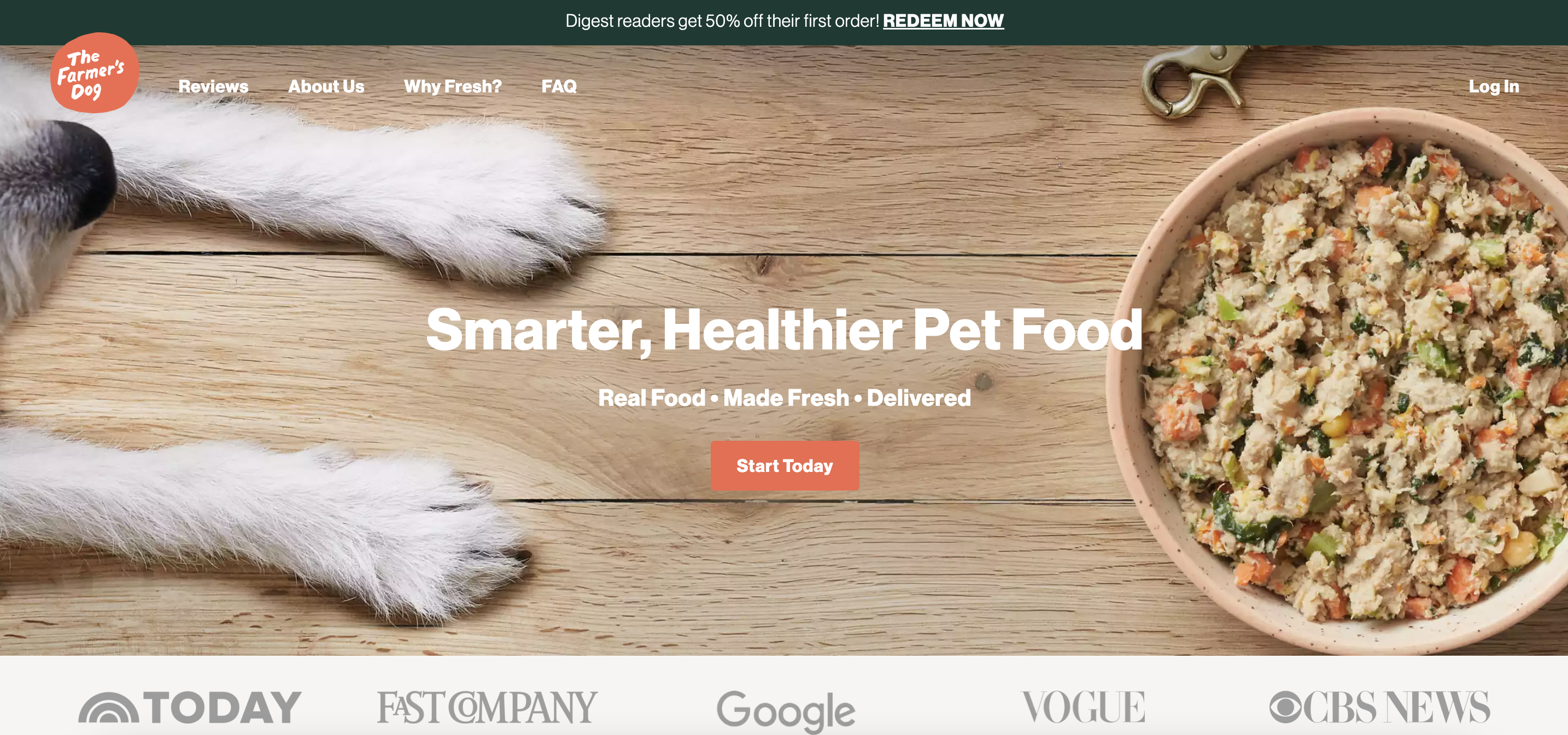
The Farmer’s Dog was founded in 2014 by two dog lovers. 6 years later, they’re delivering millions of meals monthly.
How did they do it?
We analyzed their sales funnel and boiled it down to 6 lessons you can apply in your own business to generate more sales.
Read the full The Farmer’s Dog case study .
2. The secret behind the Care/of marketing strategy
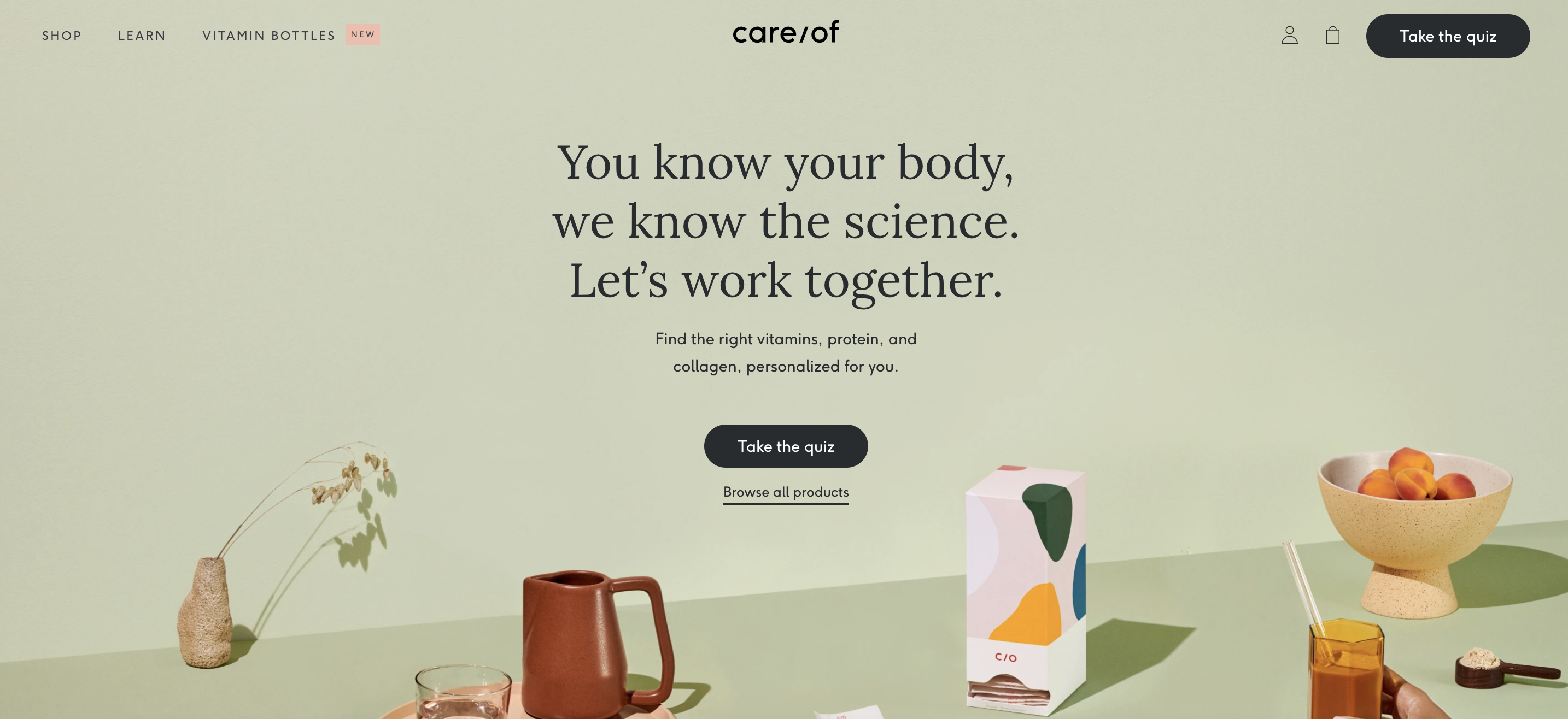
Every small ecommerce site owner dreams about a success story like Care/of’s. They achieved a $225 million valuation and were acquired by Bayer in just 6 years.
In this case study, we analyze the marketing strategies that Care/of used, including:
- Quiz funnel
- Content marketing
- Social media
- Paid advertising
Get inspired by these strategies to grow your own online sales.
Read the full Care/of case study .
3. Dollar Shave Club marketing success
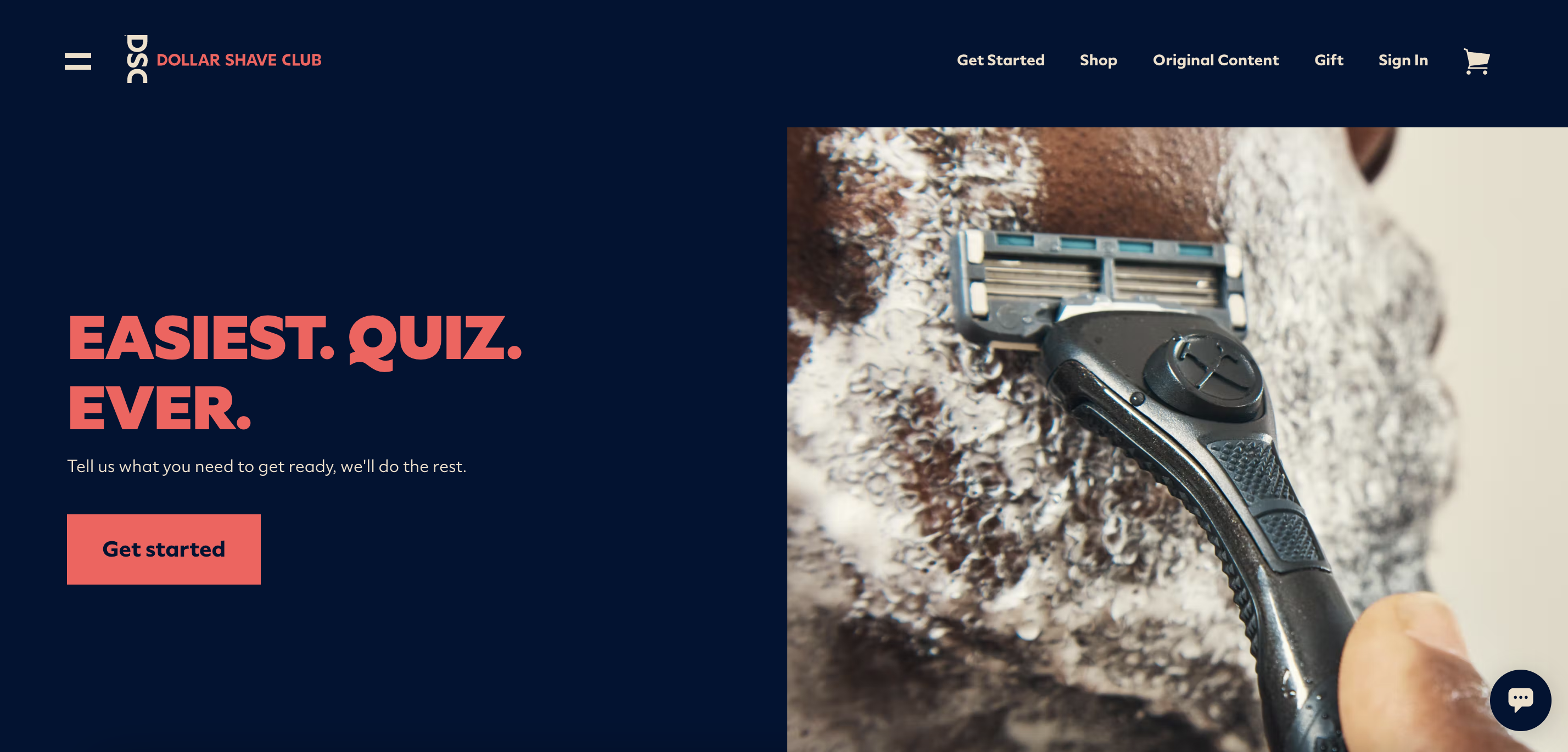
Dollar Shave Club is one of the most talked-about DTC brands, and with good reason. Their famous “our blades are f***ing great” video went viral in just a few days. The video went on to collect 4.75 million views in the first 3 months and has over 27 million views today.
This launch video gave them a killer head start, and their witty brand voice, strong content marketing campaigns, and direct-to-consumer business model enabled them to grow further. They were so successful that Unilever bought the company in a billion-dollar cash acquisition in 2016.
In this case study, we cover everything you need to know about Dollar Shave Club’s marketing game plan to build your own billion-dollar empire.
Read the full Dollar Shave Club case study .
4. How Casper took the mattress industry by storm and reached a $1.1 billion valuation
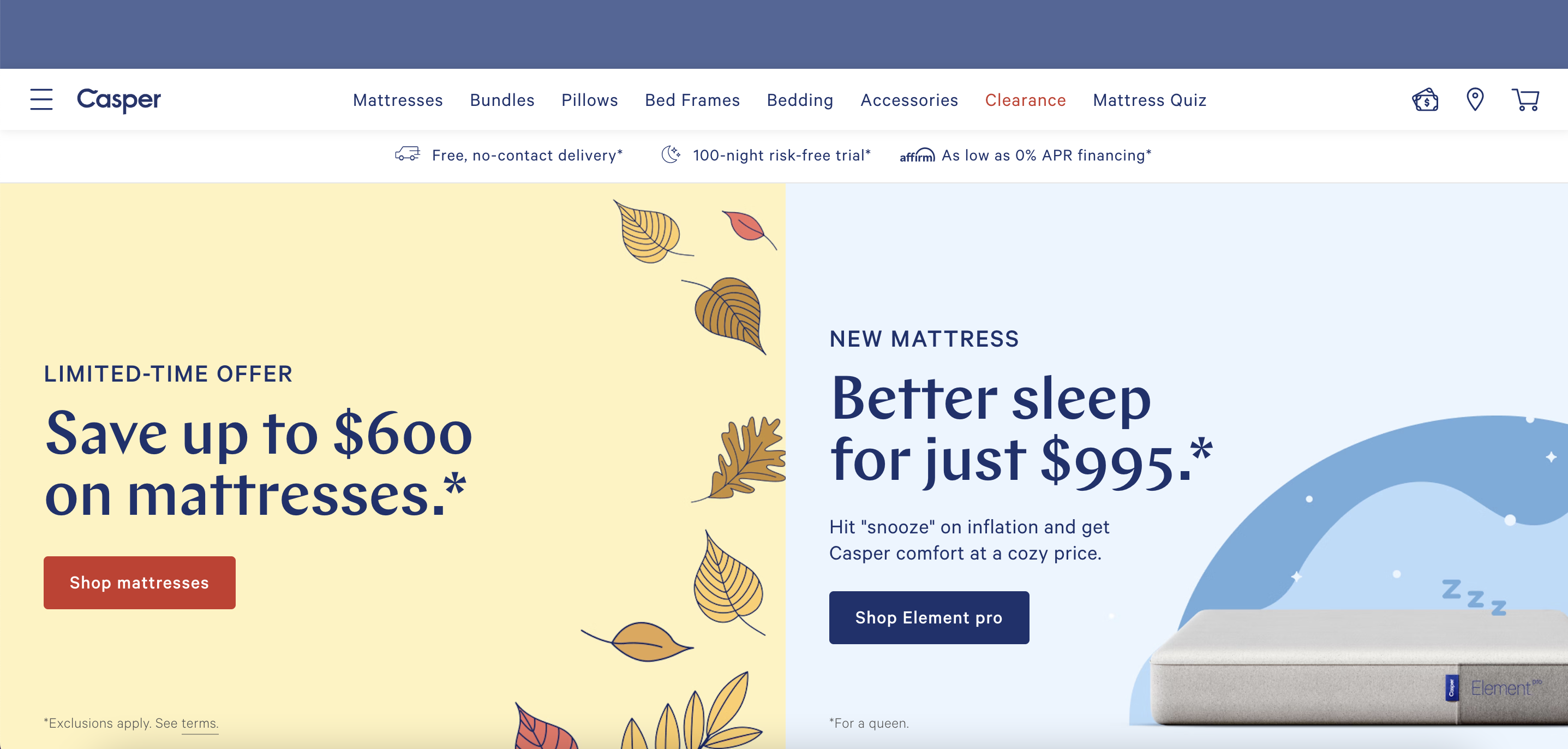
In this case study, you’ll get a sneak peek into how Casper was able to build unprecedented trust and convince people to purchase mattresses online.
We look at their well-rounded content marketing strategy, which covers topics of interest for visitors at every stage of the buyer’s journey.
We also discuss how they utilize social proof to build trust, their unbeatable guarantee, and their referral marketing strategies . Don’t miss this one!
Read the full Casper case study .
5. How Glossier became a $1.2 billion company
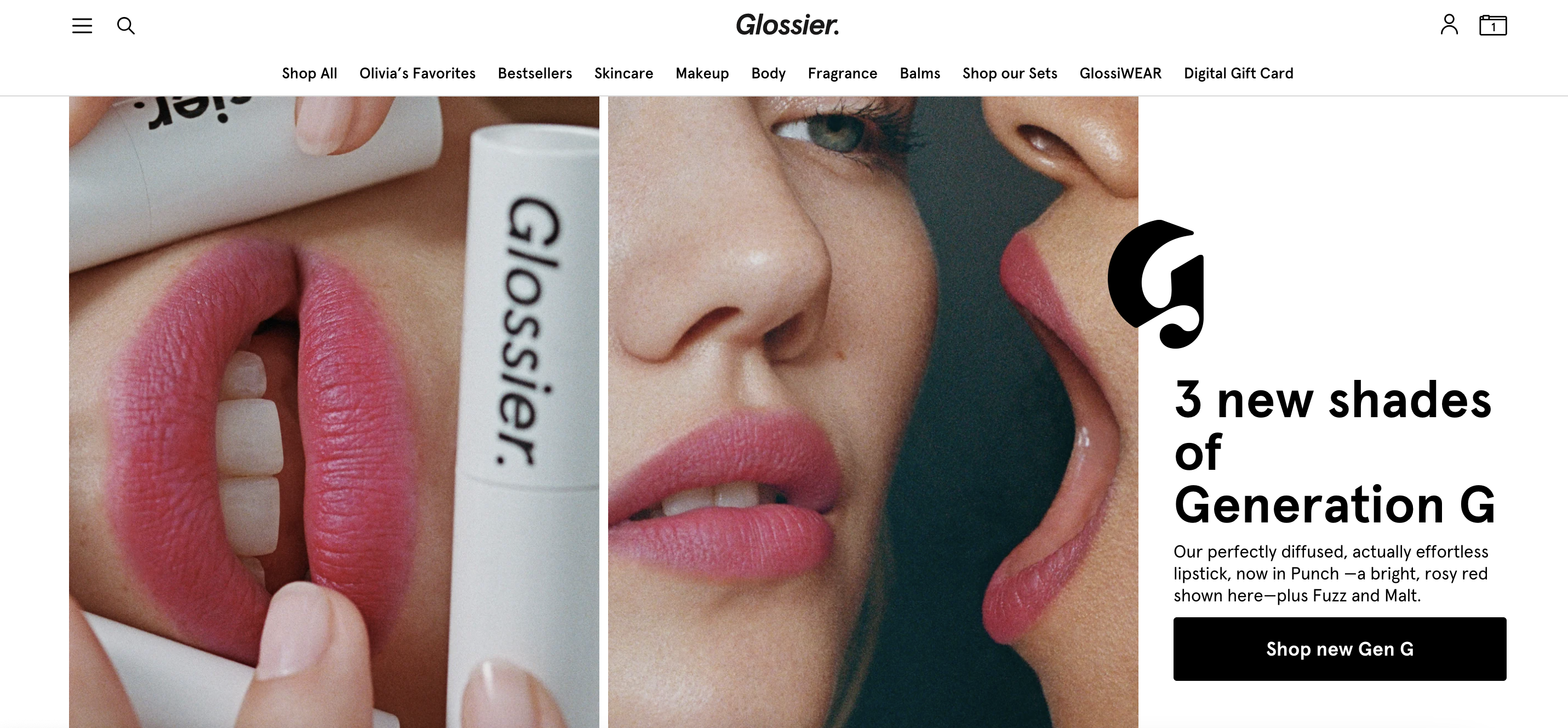
Glossier is one of our favorite ecommerce case studies. If you have a beauty brand, you’ll want to read it.
We’ve studied Glossier’s entire customer experience to find 5 lessons you can use for your own brand:
- Know your target audience and build relationships with them
- Use (micro-) influencer marketing
- Focus on branding
- Publish engaging content
- Provide an amazing user experience
Click the link below for all the juicy details.
Read the full Glossier case study .
6. How Happy Box 10x-ed their online store revenue during Covid
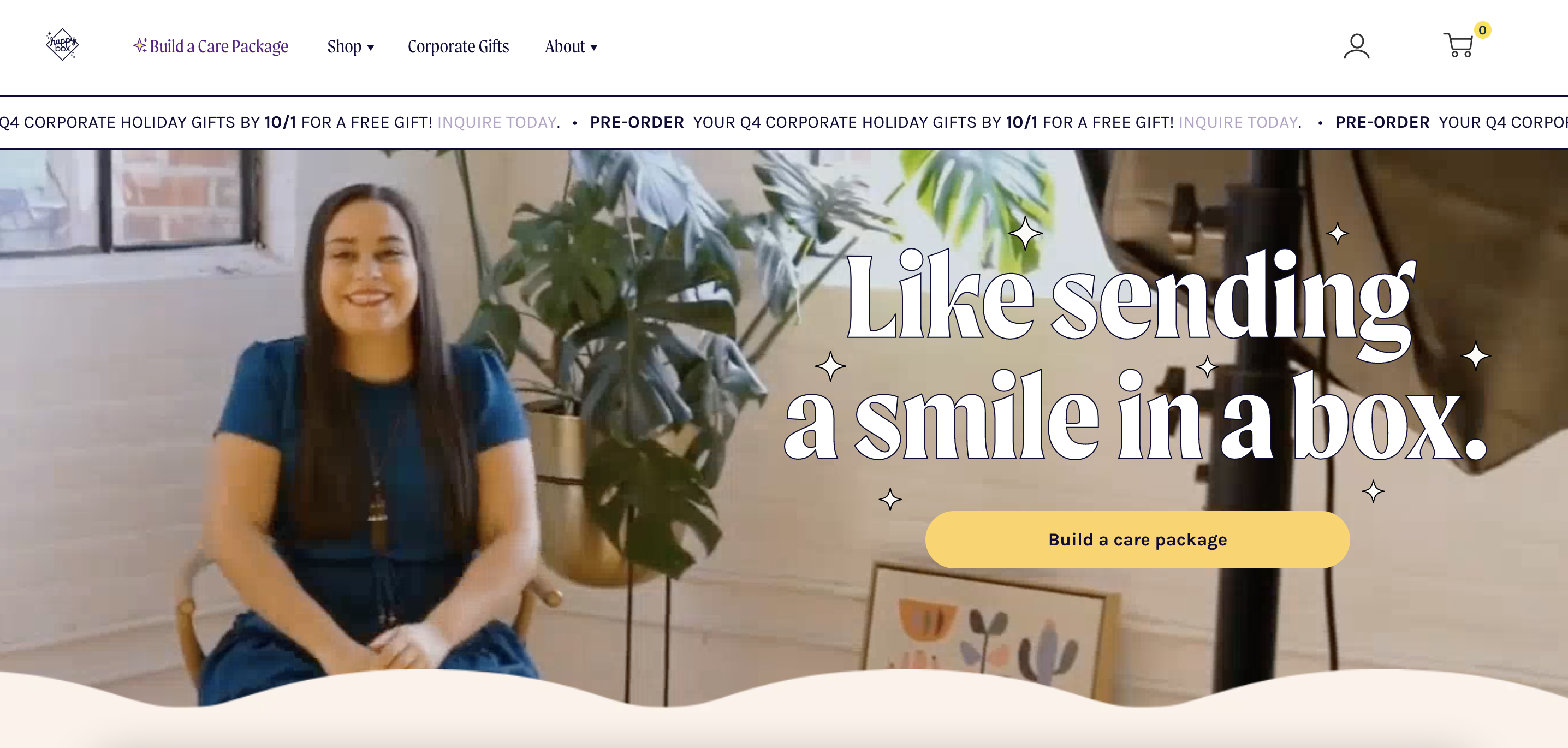
Happy Box is not as well-known as some of the other ecommerce stores on this list, but its growth is bound to inspire you.
The company started as a side project and grew into a full-time ecommerce business during the Covid pandemic. In fact, they were able to achieve a 10x growth rate in 2021!
In this case study, we look at the marketing blueprint behind their astounding success.
Read the full Happy Box case study .
7. How Warby Parker reached a $3 billion valuation and became an ecommerce giant
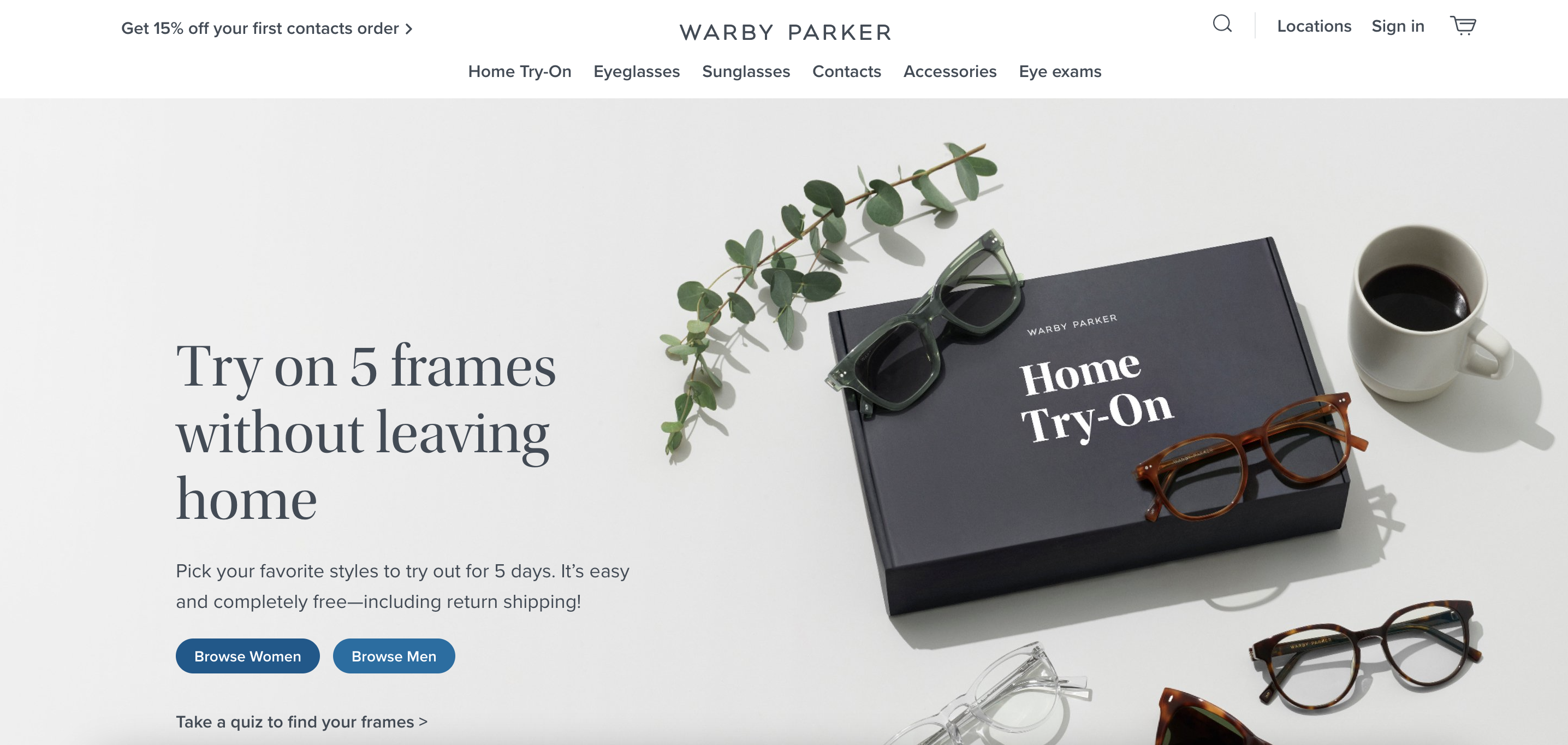
The idea of buying eyeglasses online was uncharted territory for consumers a decade ago. But Warby Parker’s phenomenal marketing helped to overcome that challenge.
Their website crashed just after its official launch, their top 15 most popular styles sold out within 4 weeks, and they collected a waitlist of 20,000 customers during that time.
In this post, we share the key strategy Warby Parker used to reach its target audience so quickly and went on to become the $3-billion giant everyone knows.
Read the full Warby Parker case study .
8. 4 steps for growing your brand organically using ColourPop’s marketing strategy
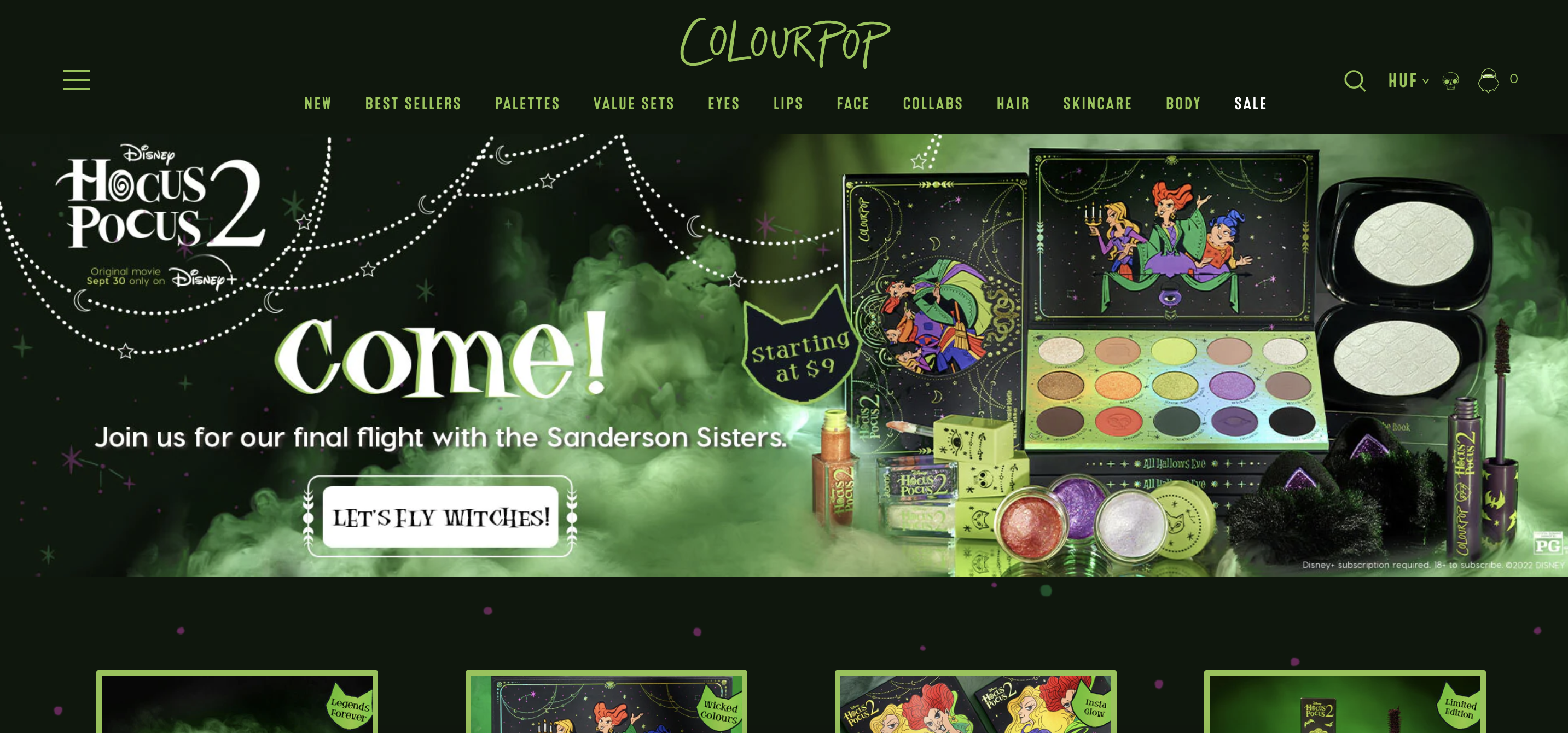
In this case study, we share 4 key takeaways from ColourPop’s winning social media strategy:
- Give freebies in exchange for authentic reviews
- Build meaningful relationships with your influencers
- Get your hashtag trending
- Host Instagram giveaways
Check out the tips that you can easily copy for your own ecommerce company.
Read the full ColourPop case study .
9. Replicate Urban Outfitters’ marketing strategy with these 4 tips
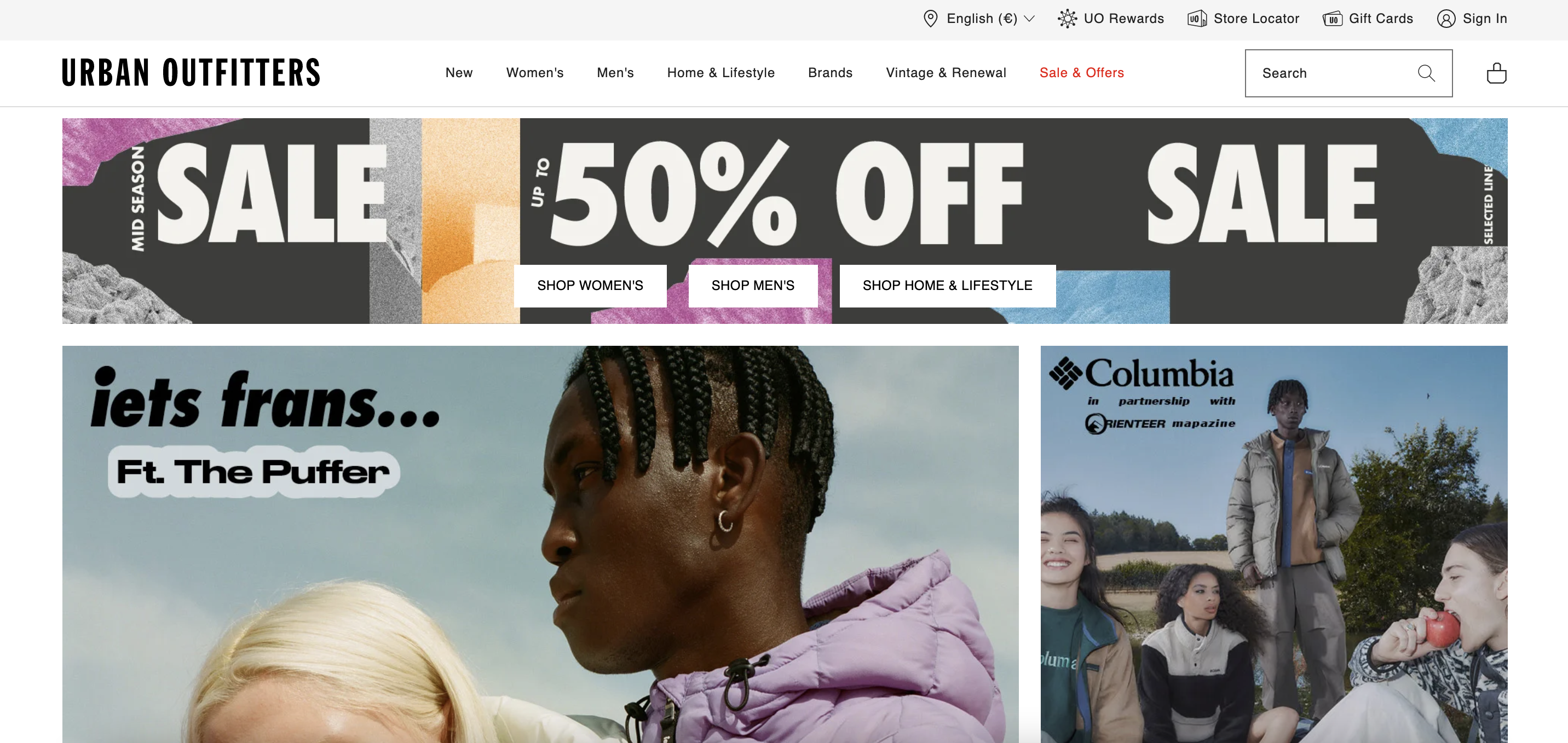
Urban Outfitters is different from a lot of the ecommerce brands on this list because they didn’t start online and grow into a global retail giant… instead, they started as a brick-and-mortar business (back in 1970) and managed to make the successful transition to online sales.
It’s worth talking about them because they’re fantastic at keeping in touch with their target audience (Millennials and Gen Z). They also succeed in strengthening customer loyalty with a rewards program.
Check out this case study to learn how you can do the same with your business to drive sales.
Read the full Urban Outfitters case study .
10. How Gymshark bulked up into a $1 billion+ brand
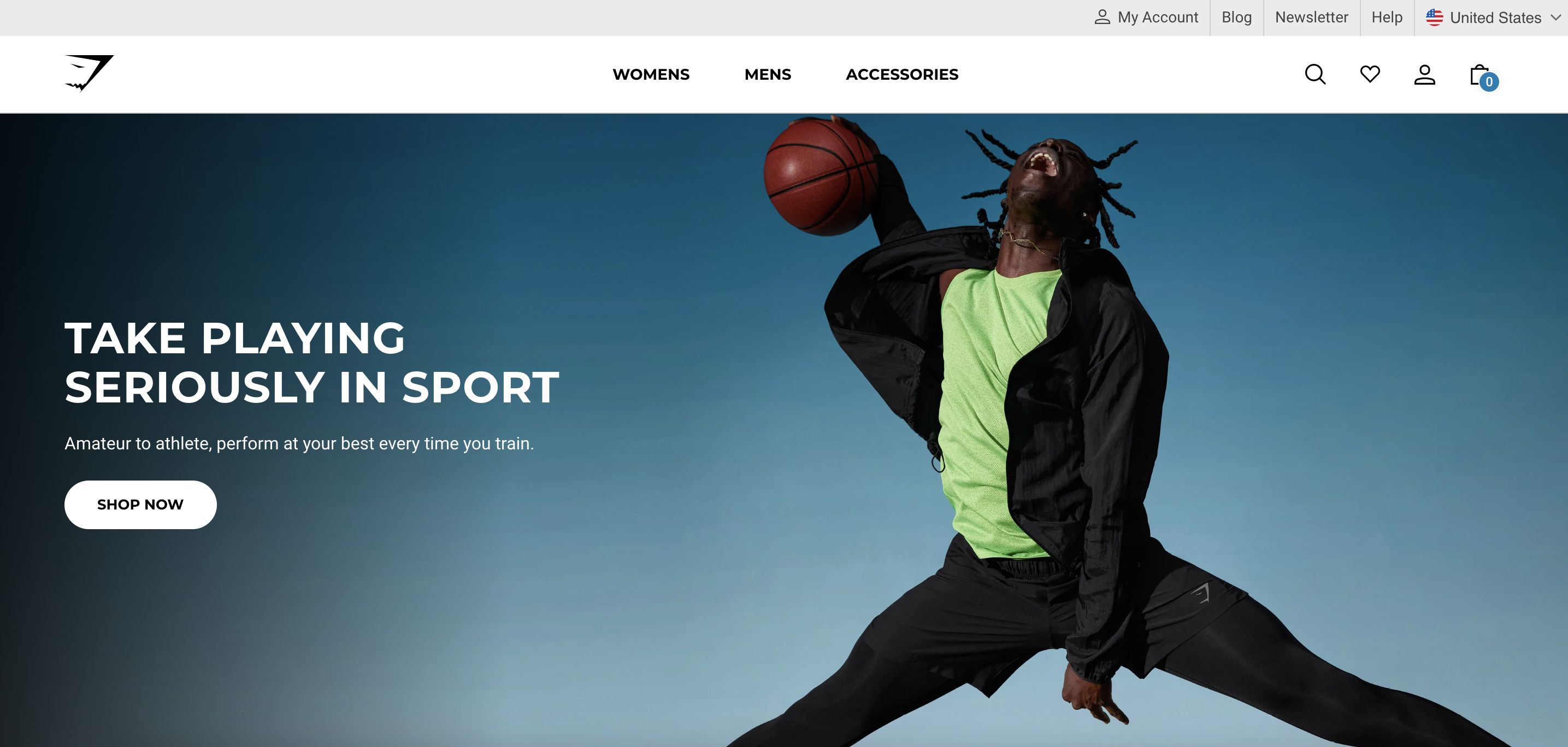
Gymshark is well known for its influencer marketing strategy. In fact, the company was one of the early adopters of influencer marketing.
In this case study, we cover how Gymshark managed to build its fan base, and we spill the beans on what they’re still doing today to delight customers. Check out our 6 key takeaways below!
Read the full Gymshark case study .
11. How Allbirds went from a small startup to a billion-dollar sneaker brand in 4 years
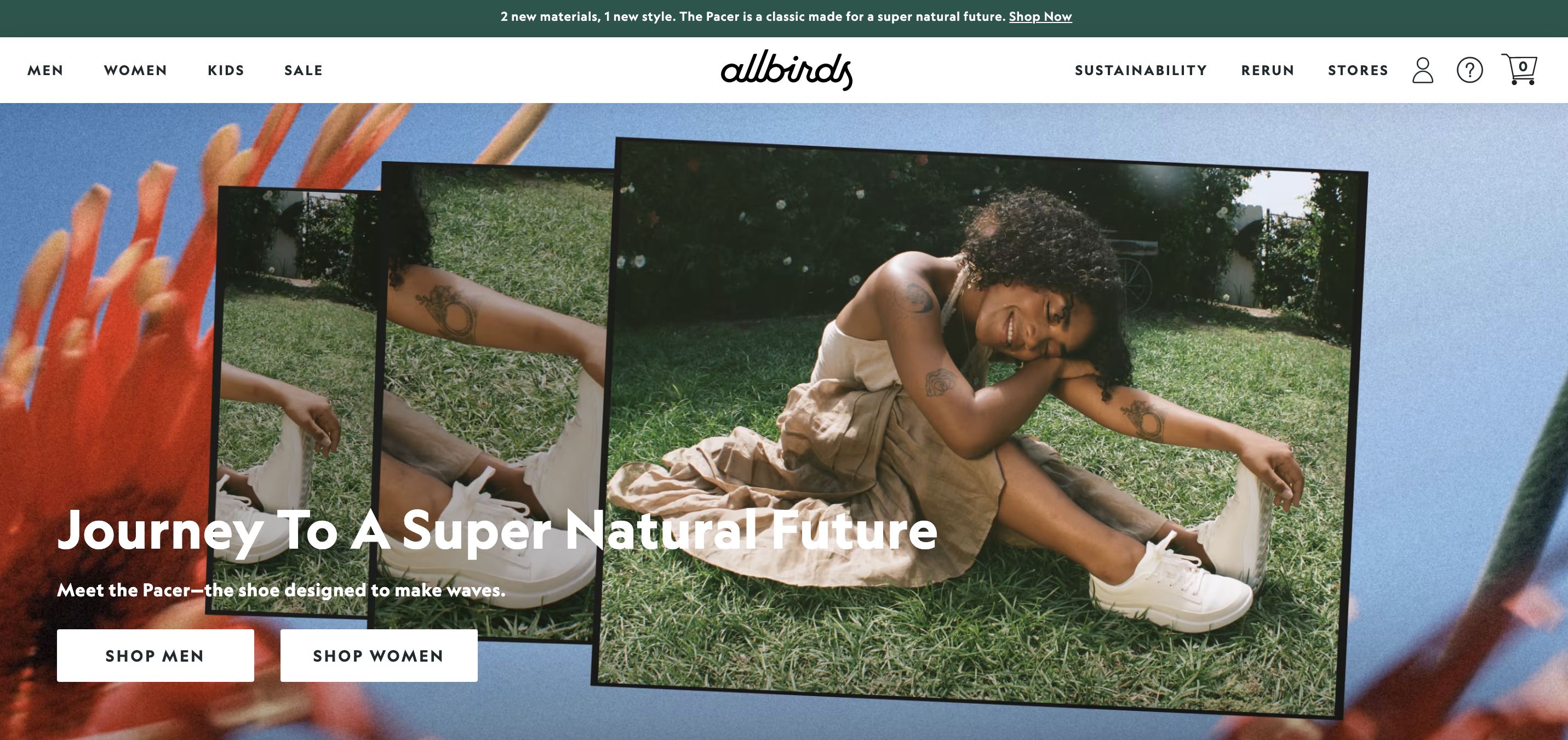
Allbirds is among the most popular ecommerce businesses, especially among circles of professionals in Silicon Valley, including Google co-founder Larry Page. The company differentiates itself from competitors by focusing on three important principles:
- Simple design
- Sustainable shoes, made from nature
Check out this case study to learn how they fight with their competitors, how they use PR campaigns and word-of-mouth marketing to get people talking about the brand, and more.
Read the full Allbirds case study .
12. How Lunya achieved $25M revenue
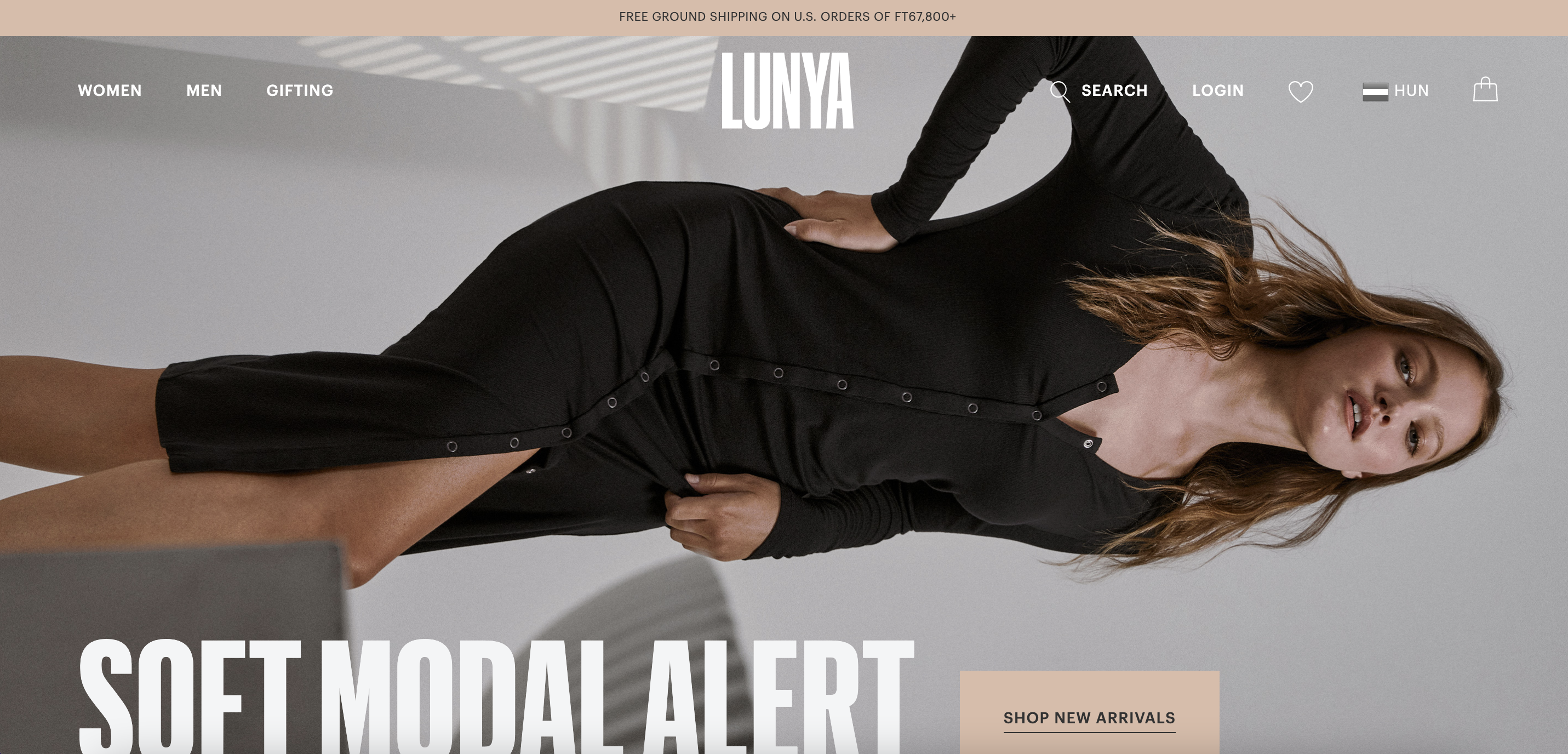
Lunya was able to disrupt the women’s sleepwear industry quickly by creating products that bridge the gap between style and sensibility. According to Lunya co-founder Ashley Merrill, the brand was able to grow by putting customers first and never losing sight of the customer’s perspective.
We analyzed the steps Lunya took to build their brand and create a successful customer-centric strategy.
Read the full Lunya case study .
13. 6+1 tips from Rituals to create meaningful moments online
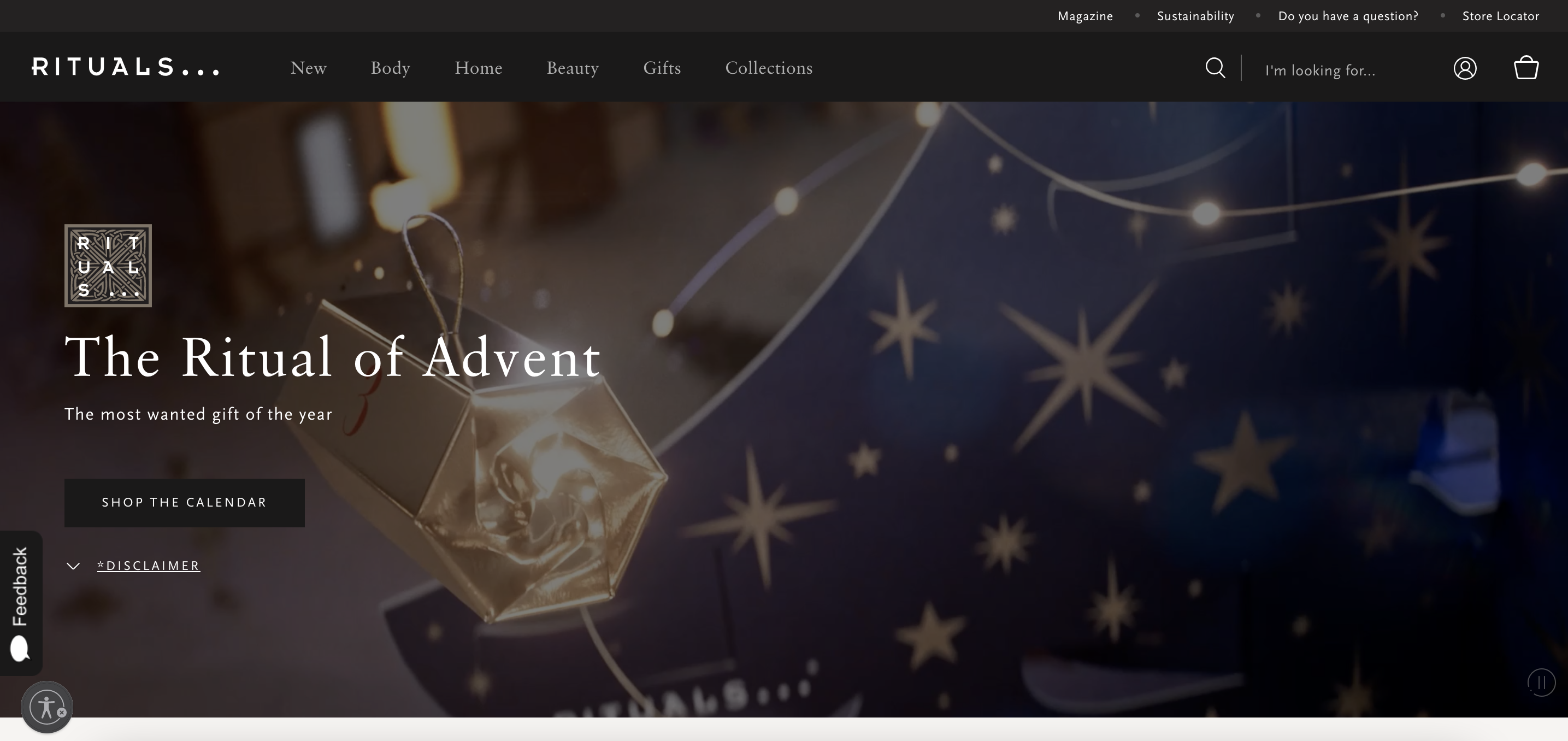
Rituals, founded in 2000, has an impressive product line including skincare, body care, makeup, and scented candles.
They really care about their customers and focus on creating an engaging customer experience online. We wanted to find out how they do it, so in this case study, we explore 6+1 tips from the marketing masters at Rituals.
Read the full Rituals case study .
14. 13 solid tips for mastering the art of personalization like Sephora
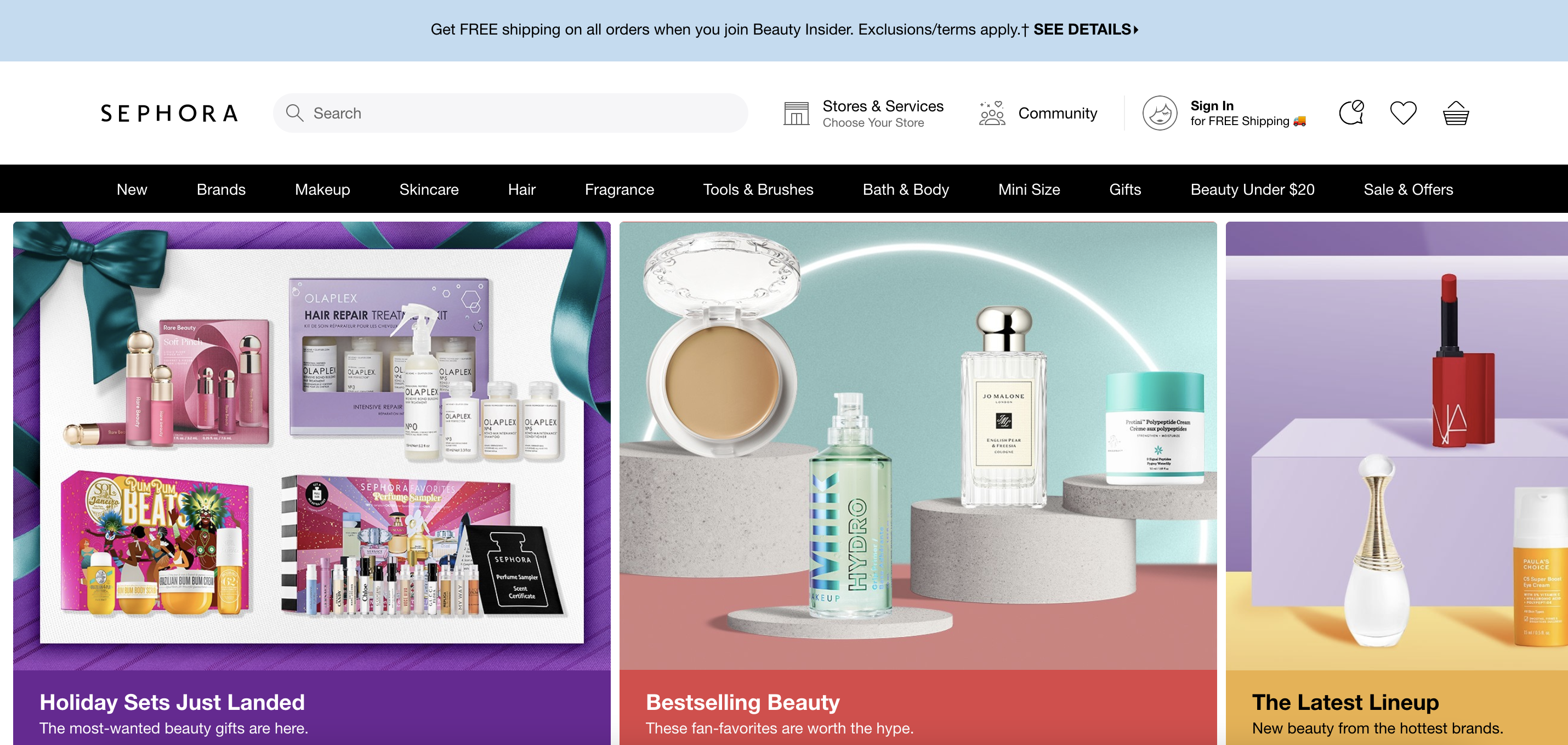
Sephora is a cosmetic behemoth that we can all learn from. What’s the secret behind their worldwide success?
In this case study, we share 13 tips they use to delight customers and create loyalty, including:
- Driving sales through personalization
- Helping customers make informed purchasing decisions
- Using YouTube to drive conversions
- Nurturing long-term customer relationships
Read the full Sephora case study .
15. How Alo Yoga scaled to $247M in revenue
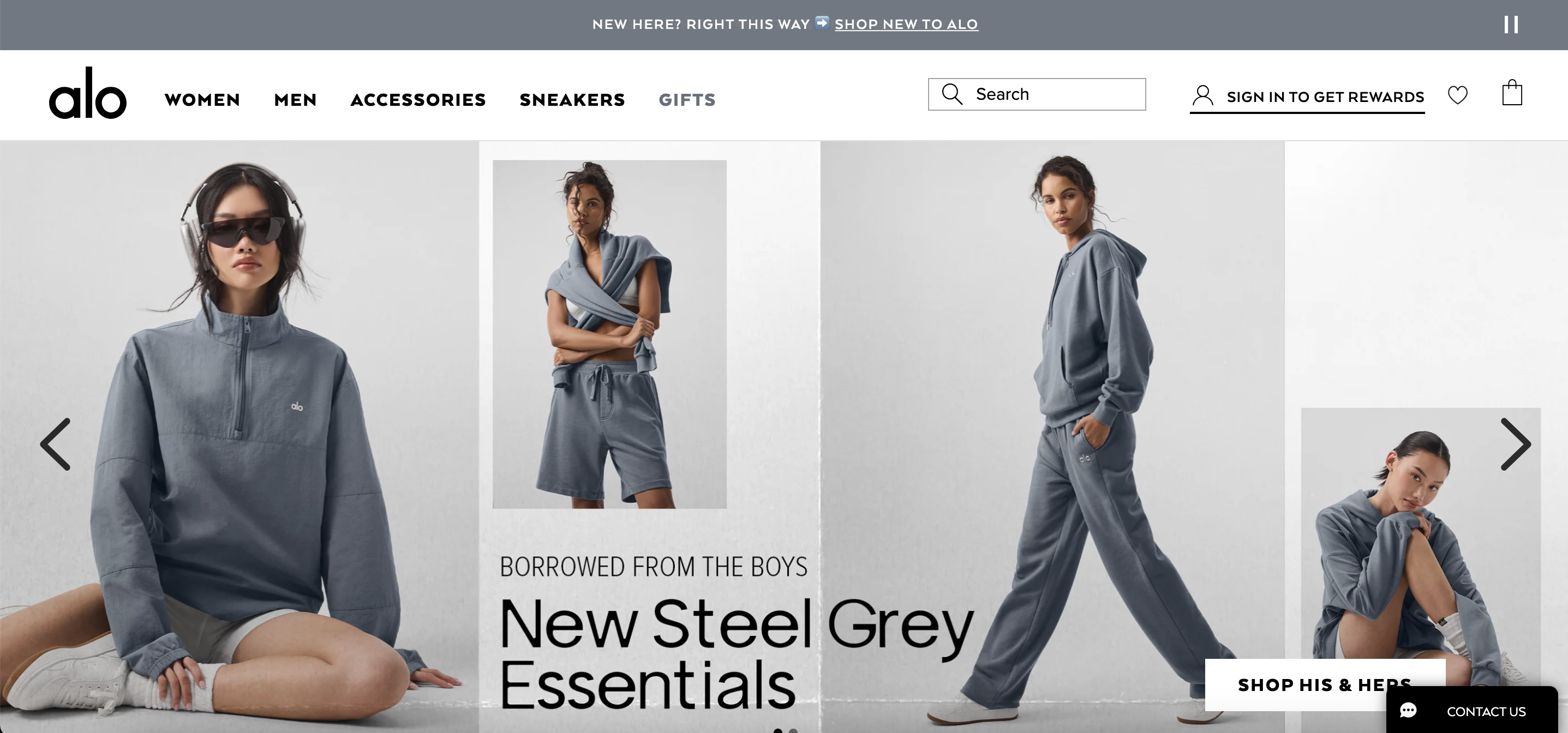
Alo Yoga is an athleisure brand known for its “studio-to-street” clothing, making it perfect for both yoga sessions and everyday wear. Founded in 2007 in Los Angeles, Alo Yoga has grown steadily, now boasting an annual revenue of $247.1M and 3 million Instagram followers.
In this ecommerce case study, we’ll share the key marketing strategies that have fueled Alo Yoga’s success.
You can discover their community-building tactics, how they leveraged user-generated content, created personalized experiences for visitors, and more.
Read the full Alo Yoga case study.
16. Bloom & Wild’s marketing strategy to become the 2nd fastest-growing startup
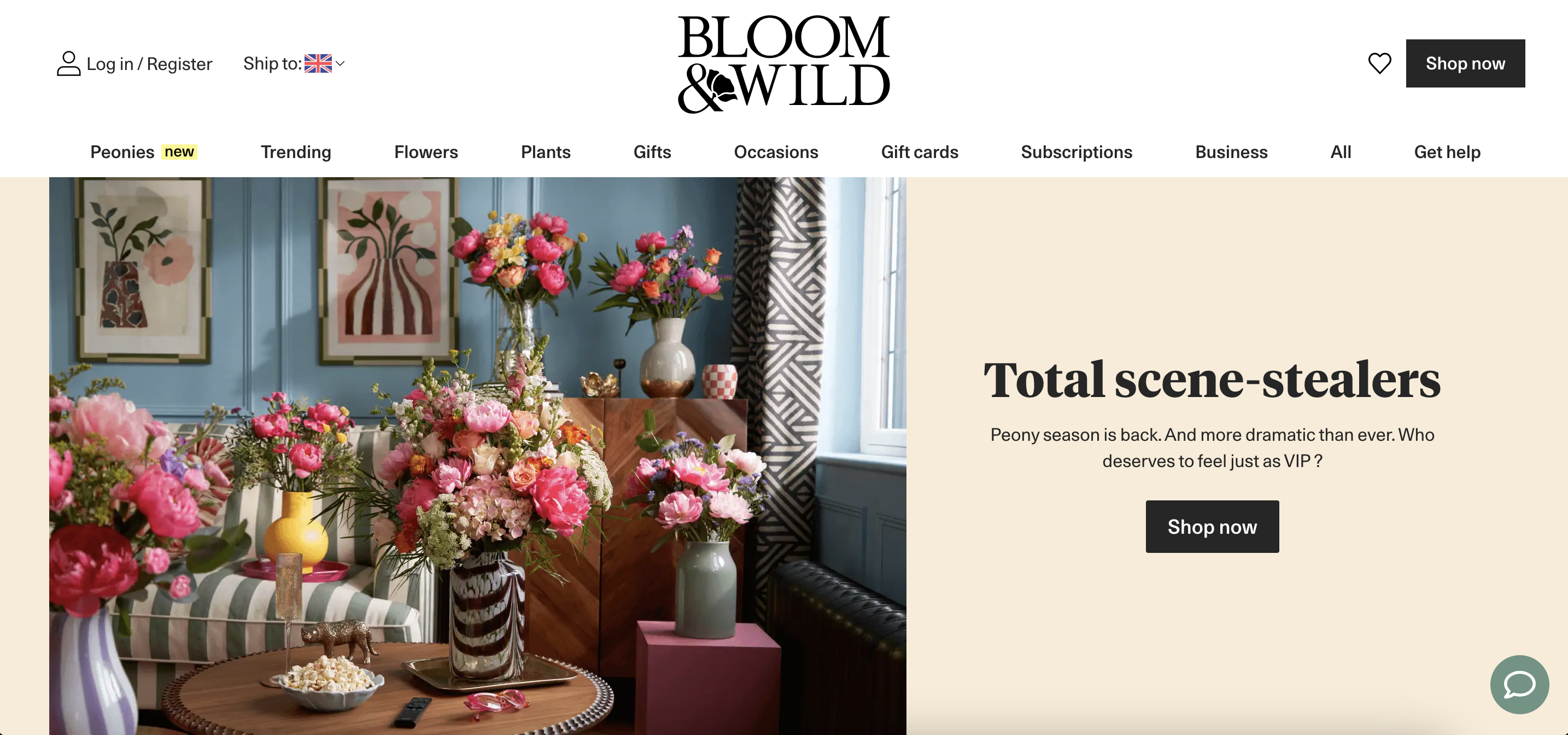
Bloom & Wild, an online florist operating in the UK, Austria, France, Germany, and Ireland, has become one of the fastest-growing online stores in its category. In 2021, the company raised $102 million in investment capital.
Bloom & Wild achieved this impressive business growth by focusing on:
- Caring about their customers
- Increasing on brand awareness with TV campaigns and dominating search results
- Customizing content for each social media channel
- Encouraging referrals
- Building loyalty with a subscription model
Read the full Bloom & Wild case study.
17. How SNOW® Teeth Whitening achieved $100M in online sales
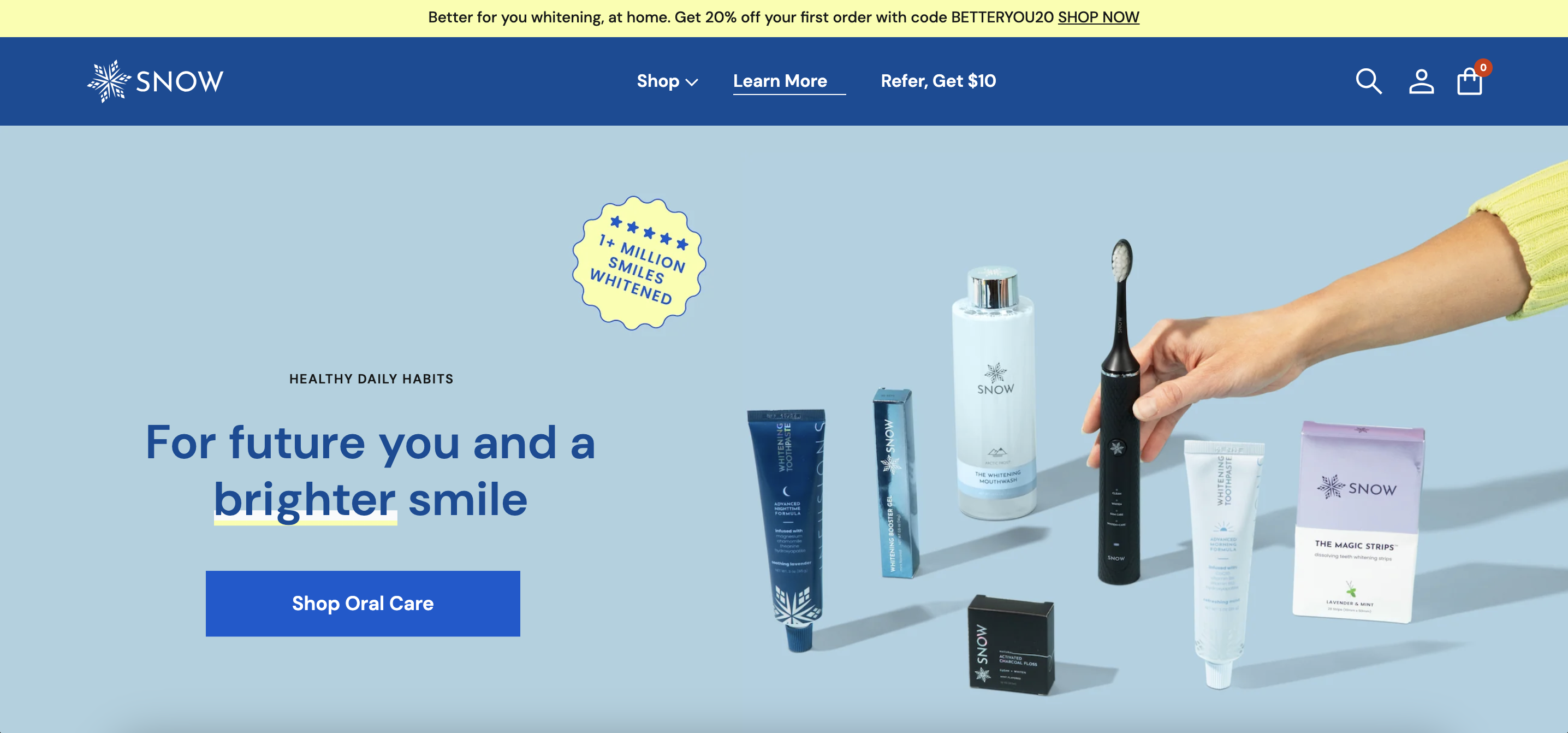
SNOW® Teeth Whitening is a DTC oral care brand focused on delivering professional-level whitening with an at-home kit.
Founded by Josh Elizetxe (a.k.a. Josh Snow) in 2017, SNOW® has quickly gained millions of fans. Over 13 million people shopped SNOW® products in 2021 alone, and by 2020, the company hit $100 million in sales after just three years online.
So, how did SNOW® achieve such significant growth?
In this ecommerce case study, you’ll learn how:
- They focus on creating and continually improving a product that meets customer needs.
- Each ad SNOW® puts out highlights the pain points that their product solves.
- They diversify channels.
- They leverage owned media for customer engagement.
- They collaborate with A-list celebrities to build brand awareness and credibility.
Read the full SNOW® case study.
Final thoughts
Well, that’s it—these are the best ecommerce case studies we’ve found during our extensive research! Hopefully you’ve found plenty of inspiration on this list.
No matter how big (or small) your company is or what industry you’re in, you can use tips and strategies from these ecommerce case studies in your own store.
Which ecommerce case study is your favorite?
Migration has never been easier
We made switching a no-brainer with our free, white-glove onboarding service so you can get started in the blink of an eye.

What should you do next?
Thanks for reading till the end. Here are 4 ways we can help you grow your business:
Boost conversions with proven use cases
Explore our Use Case Library, filled with actionable personalization examples and step-by-step guides to unlock your website's full potential. Check out Use Case Library
Create a free OptiMonk account
Create a free OptiMonk account and easily get started with popups and conversion rate optimization. Get OptiMonk free
Get advice from a CRO expert
Schedule a personalized discovery call with one of our experts to explore how OptiMonk can help you grow your business. Book a demo
Join our weekly newsletter
Real CRO insights & marketing tips. No fluff. Straight to your inbox. Subscribe now
Nikolett Lorincz
60 new year email subject lines to kickstart your 2025 campaigns, top 5 optimonk features from 2024, nps ecommerce: how to enhance customer loyalty and sales, how to use customer feedback to improve service effectively, what is ecommerce retargeting and how can it skyrocket your sales, how to increase ecommerce sales: 13 effective tactics, how to create a refer a friend popup to drive more customer referrals, top 9 optimizely alternatives for a/b testing and conversion rate optimization, 3 killer st. patrick’s day promotion ideas to grow your business.
- All features
- Book a demo
Partner with us
- Partner program
- Success Stories
- We're hiring
- Tactic Library
- Help center / Support
- OptiMonk vs. OptinMonster
- OptiMonk vs. Klaviyo
- OptiMonk vs. Privy
- OptiMonk vs. Dynamic Yield
- OptiMonk vs. Justuno
- OptiMonk vs. Nosto
- OptiMonk vs. VWO
- © OptiMonk. All rights reserved!
- Terms of Use
- Privacy Policy
- Cookie Policy
Product updates: September Release 2024
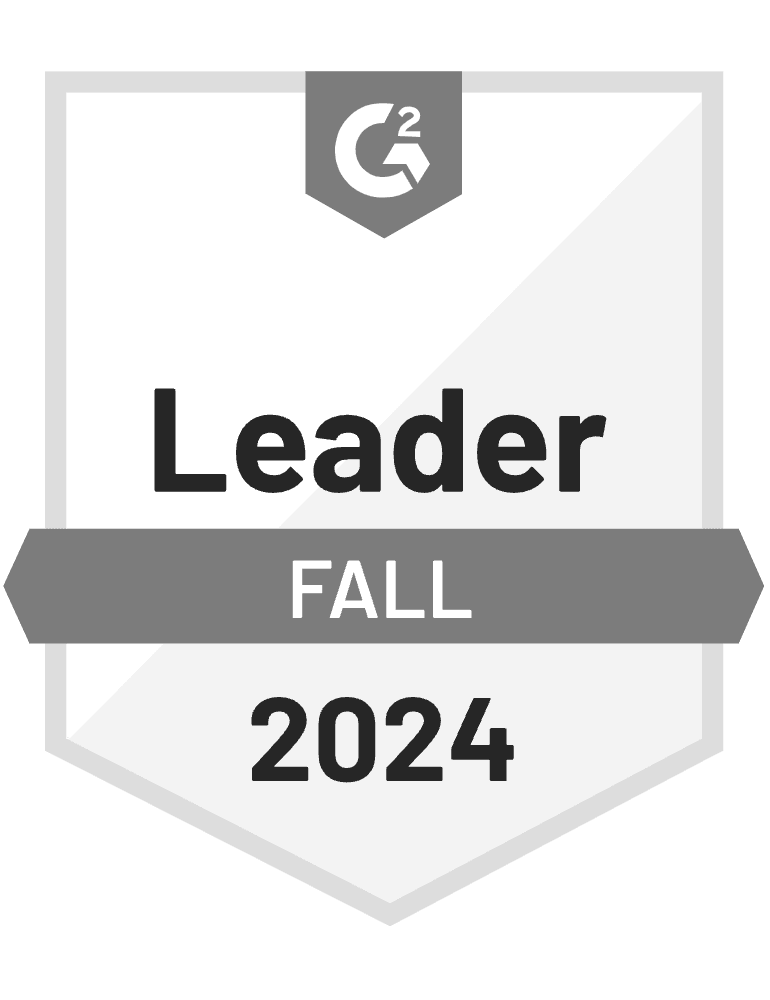
- Newsletters
- SMS | Avada Commerce
- Segments | Avada Commerce
- Popup & Spin to Win
- Shopify Development Service
- Shopify Speed & Performance Optimization
- Shopify Free Trial
- Shopify Theme Detector
- Request Demo
Top 10 Inspiring E-Commerce Case Studies To Learn From
Last updated: December 05 2024
Maintaining relevance should be a primary concern in the fiercely competitive realm of digital commerce.
With that in mind, in this article, we’ve compiled the following eight real-world e-commerce business case studies to assist you in attracting more customers and boosting revenue.
- Key Takeaways
- The article highlights 10 businesses that enhanced their e-commerce performance using Bloomreach solutions, including Bosch, Topdanmark, The Vitamin Shoppe, Albertsons, HD Supply, My Jewellerry, Debra’s, Burrow, Rakuten 24, and Al-Bahar.

Bosch Power Tools, part of the global Bosch Group, understands the importance of keeping pace with industry trends, especially those influenced by Amazon. Their case study about e-commerce is among the most famous examples of how an eCommerce brand overcomes its challenges.
Given their multiple international sites, Bosch recognized the need for a tailored digital experience for its customers. Their main challenge was offering unique experiences for each country while presenting a cohesive global presence.
Bosch established uniform technology systems and processes to address this challenge. This wasn’t just about control but about boosting momentum in every region.
Bosch then adopted a headless commerce approach, paired with Bloomreach Content. Unlike traditional systems, headless commerce separates the back and front ends. Combined with Bloomreach Content, this strategy allows Bosch to update the front end without disrupting operations, making processes more efficient.
As a result, Bosch can now quickly introduce features worldwide, aligning with the company’s goals and offering custom experiences from one country to another.
Additionally, Bosch has teamed up with Bloomreach and SAP. The Bloomreach Commerce Experience Cloud integrates seamlessly with the SAP Commerce Cloud, a key component of SAP’s Industry Cloud Program available on the SAP Store. This partnership enables Bosch to offer personalized experiences across all channels for every customer journey.

Topdanmark, Denmark’s second-largest insurance company, is committed to managing insurance and pension schemes for its customers while building trust. As it advances in the digital realm with Bloomreach Content, Topdanmark encountered challenges common to many financial services companies.
The main challenges of Tondanmark include dealing with cumbersome legacy systems filled with customer data and creating custom customer elements rapidly. In choosing a platform for their digital experience, Topdanmark sought a solution that met three critical criteria:
- Ongoing product development.
- An easier way to share content across multiple brands.
- A customer-centric online experience.
Solutions
Topdanmark sought a continually updated platform with a vibrant developer community capable of integrating with top-tier technologies and enabling its developers to enhance user experiences. Thus, they turned their attention to open-architecture CMS platforms.
For them, flexibility was crucial. They needed to test and assess new features for customers quickly. This includes letting customers easily enhance their primary insurance coverage. After seeing vital positive feedback, they made this feature a permanent option.
In their search for a platform that supported rapid innovation, Topdanmark found Bloomreach Content to be the perfect fit. With Bloomreach Content, Topdanmark smoothly shifted 500 URLs over 13 two-week periods. They also set up a responsive CMS designed for current and future efficiency.
- The Vitamin Shoppe

The Vitamin Shoppe®, a global wellness retailer, offers customers reliable products, advice, and services for their wellness journey. They observed that, although their search function efficiently helped customers find specific items, there was room to enhance their category browsing experience.
A Health Enthusiast would help uncertain customers by recommending products tailored to their needs in physical stores. Yet, before using Bloomreach, The Vitamin Shoppe had no online system to offer this level of personalized guidance.
To address and optimize its category pages, The Vitamin Shoppe incorporated Bloomreach Search and Merchandising to entice more site visitors into exploring and searching for products.
Upon deploying Bloomreach Discovery, The Vitamin Shoppe witnessed an uplift of 11% in the add-to-cart rate for category pages. Additionally, there was a 2% surge in revenue per visitor (RPV) for those who initiated their journey via these category pages.
In the realm of search pages, after a mere two weeks post-implementation, The Vitamin Shoppe observed a 7.73% enhancement in the search add-to-cart rate, a 6.51% ascent in the search average order value (AOV), and a 5.69% rise in RPV (Source: bloomreach ).
These advancements boosted The Vitamin Shoppe’s revenue and enriched the shopping experience for their customers, further aiding them in their pursuit of wellness objectives.

Albertsons – an e-commerce case study
Albertsons, a company committed to delivering a consistent and unique omnichannel customer experience, has always been at the forefront of e-commerce innovation. As one of the first grocery chains to initiate online delivery in the 2000s, Albertsons has consistently strived to offer customers personalized content that enhances brand loyalty, making it one of the most innovative grocery brands in the market.
Albertsons saw that over half of e-commerce sales came from search and knew they needed better search results for their loyal customers.
In physical stores, shoppers usually start with a list and know where items are. Online, they begin with a search. Bloomreach Discovery’s Semantic Search uses natural language processing, detailed attribute extraction, and previous visitor actions to show the most relevant products.
Thanks to Bloomreach Discovery, Albertsons used artificial intelligence to give sharper search results, making their brand experience more personal for shoppers. Beyond tailored search results, Albertsons also began suggesting products using Bloomreach’s algorithms.
After adding Bloomreach Discovery, Albertsons saw a 25% jump in the speed of building shopping baskets, showing that customers found what they wanted faster.

HD Supply, a large company, is updating its digital strategy to address ongoing challenges and better serve customers in today’s digital world. Their e-commerce team looked into their current systems and how customers used them. They found that customers wanted a faster, more dependable way to buy items.
So, HD Supply focused on making it easier for customers to quickly find and buy products, helping them return to their day. A vital part of this was upgrading the add-to-cart feature.
HD Supply realized that using ready-made technology would reduce the need for heavy changes later. So, they picked Bloomreach Discovery for their site search needs.
Understanding customers wanted faster shopping, HD Supply revamped its search feature. Customers can see product details from the search bar and add items to their cart directly.
HD Supply used the Bloomreach algorithm for most search results to lighten their team’s load. The company noticed a 16% rise in search-related revenue thanks to these changes, showing how well the Bloomreach system works.
- My Jewellery

My Jewellery – an e-commerce case study
In a world where consumers are increasingly concerned about data protection, businesses are becoming more cautious about data collection. This includes My Jewellery, a Netherlands-based clothing and jewelry retailer. My Jewellery aims to enhance the customer experience for its loyal patrons while respecting their personal data privacy.
My Jewellery used Bloomreach Engagement to lead in collecting zero-party data. They introduced a unique approach that engages customers while valuing their privacy.
With their “style profile test,” customers simply indicate if they like a shown item. This game boosts customer experience without compromising privacy. Items appear individually; customers click a heart or X to share their tastes. Based on this, My Jewellery creates a personalized style profile.
After sharing an email, customers get their style profile based on their choices. This method has proven beneficial. Emails using style profile data had a 20% higher open rate than regular campaigns, highlighting the importance of such innovative data collection.

DeBra’s, an Australian company specializing in women’s undergarments, lingerie, and swimwear since 2000, has seen substantial growth in online and offline channels over the past 21 years.
The advancement of modern technologies led to DeBra’s online business exceeding its expectations, necessitating a new online platform to facilitate future growth. Amid the COVID-19 pandemic, with the surge in women shopping online, DeBra’s aimed to ensure their online presence could deliver a digital experience equivalent to an in-store fitting.
DeBra’s team identified BigCommerce as the optimal solution for their business, logistics, and marketing needs. BigCommerce’s open API functionality allowed DeBra’s website to easily integrate with other technologies, such as a POS system, enhancing its marketing and customer experience.
BigCommerce also enabled DeBra’s to launch a virtual fitting service. Their in-store staff serves as virtual assistants in this service, helping customers enjoy a professional, digitally appropriate experience.

Burrow – an e-commerce case study
Burrow, a B2C furniture store established in 2017, was founded to eliminate the inconveniences of traditional furniture shopping. However, once their business achieved $3 million in sales, they encountered system issues with their existing online platform. Their business growth had outpaced their eCommerce solution.
Additionally, the Burrow team needed practical content management tools that would allow them to update landing pages without requiring extensive technical expertise.
Burrow separated their website’s front and back ends using headless commerce. This approach provided them with the flexibility to create a unique shopping experience. Thanks to a headless CMS, the Burrow team could freely use available templates and customize marketing-focused content as needed.
They could continually update and adjust content across channels to align with targeted customers. Furthermore, Burrow recognized the importance of offering customers unique logistical features, including the ability to delay orders and require signatures on delivery.

Rakuten 24, an online branch of Japan’s top e-commerce company, Rakuten, sells everyday items like groceries and healthcare products. Seeing the fast rise of mobile shopping, Rakuten 24 aimed to create a top-notch mobile experience for its users.
Although Rakuten 24 is newer to Japanese consumers, pouring a lot of resources into making specific apps for iOS and Android might not be the best move. Instead, they felt a well-designed, user-friendly mobile website could be a more innovative alternative for Rakuten 24’s mobile presence.
Rakuten 24 built a Progressive Web App (PWA) to increase market share and improve user retention to deliver a seamless web experience across all browsers. Their PWA successfully combined the best features of native apps with the extensive reach of the mobile web. Rakuten 24 also provided a detailed guide on manually installing the PWA on Android and iOS devices for mobile web users.

Based in Kuwait, Al-Bahar is a leading supplier of FMCG products, electronics, and office tools from top brands like Unilever and GE. It’s a trusted name in the Middle East. However, despite its strong reputation and heavy website traffic,
Al-Bahar faced web issues like slow speeds and frequent downtimes. The main causes were poor hosting choices, an outdated CMS, and using Magento 1, which was no longer supported.
Given the website’s needs, a significant overhaul was in order, but this came with risks like data loss and compatibility problems. Al-Bahar needed to be careful.
After teaming up with SimiCart, a recognized PWA development agency, Al-Bahar updated its site based on SimiCart’s guidance. SimiCart suggested transitioning the front end to a Magento PWA and shifting from Magento 1 to Magento 2 for the backend.
This transition not only ensured data preservation but also boosted the store. With a PWA interface, Al-Bahar enjoys faster speeds, greater adaptability, and a smoother user shopping experience.
- Bottom line
These eCommerce case studies unveil novel strategies and tactics on how others have tackled challenges in the eCommerce field. You can learn from their experiences to overcome challenges while running an eCommerce business. Follow our next articles to explore additional information related to case study email examples or case study questions examples .

Recommend for you

Don't have a Shopify store?

Irakli Zviadadze | Content Marketer | Sugatan.io
March 9, 2021
Top 33+ eCommerce Marketing Case Studies You Need to Swipe
One of the best ways to grow your eCommerce business is by reading up on some real-life, practical, and proven case studies .
Whether you’re a new or seasoned eCommerce marketer, there’s always something new you can learn from other brands with proven results in eCommerce.
The problem?
There aren’t many case studies out there that provide the practical step-by-step of what they did that worked.
This is why we’ve compiled this long list of the best eCommerce marketing case studies and strategies you need to know about.
This is going to be the single most comprehensive article you’ll read on eCommerce case studies. So, you might want to save the link.
Looking for a specific eCommerce marketing channel you want to read up on?
Feel free to skip ahead:
Facebook Ads Case Studies
Influencer marketing case studies, email marketing case studies, seo case studies.
- Other Case Studies (Storytelling, sales hacks , plugins, copywriting, and more).
If not, let’s start from the top:
1. Sugatan – Step-by-Step eCommerce Scaling from 50k/mo to 520k/mo With Facebook Ads

Yes, that’s us.
But we achieved some serious results in this case study and learned a lot of stuff that’s worth sharing.
- $520k+ in monthly sales with 3.79x ROAS throughout the funnel.
- 2.35x ROAS at TOF spending $100k+/monthly.
- $410k in revenue during Black Friday with 7.27x ROAS
Case Study Summary:
In this case study, we scaled one of our clients using Facebook ads and went from $15k monthly ad spend to $140k in only 4 months and through 9 main steps.
Here’s the short version of how we did it:
- Fleshed out the customer-centric marketing funnel (TOF, MOF, BOF) and installed Hotjar to get insights on consumer behavior.
- Started testing different video creative types, placements, targeting, and other details. Used the Waterfall method to test the creatives (ad styles, buttons, thumbnails, headlines, and more).
- Started preparing to scale. Killed off smaller ad-sets with the same audience and increased the budget by 20%-30% TWICE per day for 2-3 days.
- Increased the budget 1 month prior to the Christmas and Black Friday sales. Launched Facebook messenger and email collection campaign before the sale started. Also created different VIP sale for people who either: a) gave us their email address or b) subscribed to our messenger list.
- Once we had built up bigger remarketing audiences for flash sales, we started running Facebook ads for the whole Black Week and gave 10% off to everyone who we pixeled and 20% off for VIP sales (only for 24h).
And this is only the tip of the iceberg.
Read the whole eCommerce Facebook ads case study here to learn what else we did to scale and our approach to creatives .
Also check out our separate guide to eCommerce Black Friday to learn how we generated 45% of yearly revenue in 3 months!
2. GrowRevenue.io – 0 to 29.5x ROAS in 3 Months for Furniture eCommerce Site Using “See, Think, Do” Strategy

- Went from spending over $2,000/mo on social campaigns with 0 to 29.x5 ROAS in 3 months.
eCommerce store specializing in niche furniture style with an AOV of $1,300 applied a “See, Think, Do” Facebook ad strategy to significantly improve their ROAS.
The essence of the strategy is to create specific campaigns with different targeting, creatives, and CTA for each stage of the marketing funnel. Here’s what they did:
- Uncovered past mistakes and did an audit of their previous social campaigns. Found that ads weren’t set up correctly, audiences were too broad, they weren’t using URL tags, and more.
- See phase: They created a video view campaign that was launched as a general prospecting tool with the effort to gain brand recognition with new audiences.
- Think phase: The information from the ‘See’ phase was used to update and refine the audience for the ‘Think’ phase. When it was time to run the traffic campaign, after the success of the reach and video view campaigns, the leads visiting the eCommerce site were significantly more qualified.
- Do phase: By this stage of the funnel, the audience was already familiar with the brand and the products and more prepared to take action. Finally, they narrowed down the audience and launched a conversion campaign.
Sometimes, fixing past mistakes can have a huge impact on your ROAS. Check out the full Facebook ads eCommerce strategy to learn what they did in more detail.
3. Depesh Mandalia – $7M in eCommerce Sales With 21x ROAS Using Facebook Ads

- $21x ROAS in November generating $7M+ revenue with $341K ad spend.
- Generated $15M+ revenue total in Q4.
This eCommerce store sells ski and snowboarding apparel and gear with an AOV of $200 and had a great understanding of their target audience. Here’s a quick rundown of this case study:
- Defined the target audience and creative personality elements early on. They wanted to make it clear that the brand was a snow/ski apparel brand. With the creatives, they wanted to sell the experience itself and make the customers feel something.
- Approached ads with a fast bite-sized testing method: Set up the campaign structure for rapid testing, used fast-paced testing at scale, used test insights to build ads ready to scale, and used ad impressions for high output testing.
- Used ‘soft scaling’ rules focusing on horizontal scaling through duplicating ad sets and segmenting into ad, gender, placements, devices, and so on.
- Implemented their testing process in multiple countries to test new markets.
- Used FOMO with past knowledge of purchasing habits around Black Friday and made sure they wouldn’t sell out quickly during Black Friday.
A lot of this case study was based on testing and evolving around Facebook’s algorithm. Read the full Facebook ads eCommerce case study here for more info.
4. Valentina Turchetti – How a Beauty eCommerce Generated $14K in 5 Days With Facebook Ads

- Generated 14,325$ in 5 days with $1,568 ad spend on Black Friday with a single ad (9.13x ROAS).
Here’s what the beauty and haircare eCommerce brand did to generate 166 purchases with a single ad:
- Created a conversion campaign and tracked purchases as an ad event.
- Used retargeting to target audiences who: visited the website in the last 60 days, made a purchase in the last 60 days, added products to their carts in the last 60 days, email leads of customers of the last 3 months, and used lookalike audiences. Also targeted their audience for interests (hair brand names and beauty interests), and women aged 24-55 in Italy.
- Wrote minimal, clear, and specific copy. Focusing on main keywords like “Black Friday”, “hair”, “beauty”, and “sale”. Made sure the sale amount (50%) was the focus of the ad image and focused only on the discount with the copy. Also used SEMrush’s Topic Research feature to find relevant keyword ideas.
- Used a high-quality picture of a collage of real products and a clear “Shop Now” CTA.
Sometimes, simple ads and creatives perform best. Learn more about this eCommerce Facebook Ads strategy here.
5. Growth Cave – $18K in Revenue at 659% ROAS For an eCommerce Company In 4 Months

- Generated over $18,700 in revenue at 659% ROAS in 4 months using Facebook ads.
In this case study, Growth Cave used their ‘8 Figure Framework’ to grow an eCommerce company to $18K in revenue.
The framework is based on 3 simple core campaigns :
- Retargeting.
- Previous customer upselling and cross-selling.
- New customer prospecting.
Here’s what they did:
- Create a carousel of products retargeting customers who had interacted with those products and offered a 20% discount coupon to encourage them to complete the purchase.
- Set up campaigns upselling their newest products. In the ad copy, they made sure to call out these previous customers and thank them for their support throughout the year.
- To find new customers, they did 2 thi9ngs: 1. Created a list of all their high AOV customers. 2. Created a list of all of their repeat customers (people that purchased 2 or more times in the last 6 months). For this eCommerce business, their new customer prospecting campaigns were designed to showcase only the best selling products in simple, clean ad formats (slideshow videos).
And that’s it! The best part about this case study is that the above core campaigns in theory can work for nearly every eCommerce business regardless of their budget, size, and so on. Check out the full Facebook ads eCommerce case study to learn more about the campaigns and how much each of them generated.
6. Common Thread Collective – $1M Ad Spend at 4x ROAS

- Generated $4M in sales.
- Made a 4x ROAS on the first $1M and 3.8x ROAS on the full $1.5M.
- Sold over 80,000 pairs of pet-themed socks over the course of 45 days.
In this case study, Common Thread Collective (CTC) built, managed, and scaled a campaign of epic magnitude. The brand (pet-themed personalized socks) was spending $500 per day on Facebook ads and wanted to make millions over the holiday season.
Here’s what happened:
- To prepare, they created multiple ad accounts and raised the ad account spending limit to $100,000 a day through their Facebook rep. Made sure the website could handle the traffic and fixed other technical issues for scaling.
- Ran PPE campaigns for 7 days before going into aggressive scaling to find the winning ad creative that gained a 4xROI.
- Created 50+ lookalike audiences, 200+ custom audiences, 500+ variations of lookalike and custom audiences broken out by placements, bid types, etc.
- Killed off ad sets that weren’t working and scaled the winning sets. If they got 4-5 add-to-carts, they made a call on whether to kill or to scale the ad sets.
- Duplicated winning ad sets and increased the budget (3x-4x depending on the size of the audience) and used auto-bidding. Then, they duplicated that winning ad set again 3-5 more times with different manual bids.
- Used influencer marketing to increase their reach. Used the same ad creative but changed the ad copy so that it felt more organic and native to their community.
It’s rare to see ad campaigns planned out at this level. Read the full eCommerce Facebook ads case study for more info and main takeaways.
7. Sugatan – How to Generate $350k/Mo with Influencer Marketing

Just so happens, influencer marketing is also one of our specialties.
- $350k/Mo from influencer marketing with an easily replicable 3-step process
2 Main priorities we look at within influencer marketing are:
- Generating revenue – Measured through discount codes, Google Analytics, so on.
- User-generated content (UGC) – Measured through the number of creatives.
Here’s a breakdown of our process :
- First, we define our influencer marketing goals. Usually, it’s generating sales or getting user-generated content.
- Then, we define our influencer type. We mostly consider celebrity influencers, macro, micro, or nano influencers – depending on the audience and niche.
- We use Scope to find potential influencers, filter them down to our requirements, and Yesware for our email outreach campaigns.
- Then, we upload the list of influencers (either generated from Scope or the manual research is outsourced) to Yesware, set up our outreach templates and add at least 3 email follow-ups to the flow.
- From there, we negotiate the price, process, and deliverables. Unless the influencer requests a high rate or we need something very specific, we don’t do contracts.
Obviously, some things depend on case-to-case here. But for the most part, our process stays the same.
Check out our full eCommerce influencer marketing for a more detailed look into our process and the exact variables we define for our marketing.
8. Gymshark Growth Story – How Gymshark Grew by 200%+ Year On Year and Hit $57M in Sales

- Grew 200%+ Year on Year and generated $57+M in sales.
- 193% compound sales growth from 2013-2016.
- Achieved worldwide cult-like following in around 7 years.
The Gymshark story is a classic tale of influencer marketing and social media done right. Here’s how they disrupted the gym apparels market:
- Only selected specific influencers and used scarcity to associate Gymshark brand with high-quality.
- Sponsored various social networks, organized meet-ups, and flooded just about every social media channel with different kinds of influencer content (Instagram, TikTok, Facebook, even Twitter, Pinterest, etc). Even created a Gymshark Spotify playlist to reach a broader audience.
- Partnered with fitness and lifestyle influencers on TikTok.
- Announced the “66 Days | Change Your Life” challenge on social media platforms where followers were asked to choose a personal goal and upload an initial photo of themselves. 66 days later, they had to update their photo for a chance to win a year’s supply of Gymshark goods.
- Built long-lasting relationships with fans and were present on the biggest social networks engaging with their fans.
See the full Gymshark influencer growth story here:
9. HiSmile – Growing From $20k Investment to $40M eCommerce Powerhouse in 3 years With Influencer Marketing

- Went from $20k investment from the founders to over $40M in sales from over $100k customers across the globe.
- The founders recognized a gap in the oral hygiene market that they capitalized on with the right teeth-whitening product (vegan, cruelty-free) and branding.
HiSmile is a teeth whitening company that’s dominating the teeth-whitening niche. In just over 3 years, the 2 founders achieved explosive growth by targeting millennials and working with some of the biggest influencers in the world (Kylie Jenner, McGregor, and many other huge celebs).
- Did a ton of customer and product research and created a strong, no-hassle offer: vegan, cruelty-free teeth-whitening product with a full money-back 30-day refund guarantee.
- Took a “throw spaghetti at the wall and see what sticks” approach in the beginning and published a lot of content for everyone from 15-35 years of age. Then, they found the biggest component of their social media strategy – targeting media influencers.
- Invested nearly all of their initial $20k into targeting micro-influencers at first and sent out their products in hopes of getting mentioned on social media.
- Started posting on social media a lot once they gained traction and used influencers’ content to increase their reach. Created different types of content for each channel (e.g. under 45 second videos on Facebook talking about the product).
- Invested in improving their website user-experience, set up subscription pages (e.g. monthly toothpaste), improved site speed and SEO, and started getting major media coverage – gaining explosive growth from all sides.
The truth is, they utilized more than just influencer marketing, but HiSmile’s success was no fluke. Check out the full HiSmile case study to learn more about their overall digital and social marketing strategy.
10. Coconut Bowls – Instagram Giveaway That Resulted in 41K Emails, 37K followers, and 15K Shares using VYPER

- With less than $1,000 Coconut Bowls was able to generate over 41K emails in 4 weeks using influencer and viral marketing.
- Reached over 222,263 pageviews, added 37,703 new social followers, and generated 41,820 new email leads.
Coconut Bowls is a Shopify eCommerce brand that sells coconut bowls. Getting people to share and engage with household products like bowls is no easy task for a marketer. And with less than $1,000, they wanted to generate a huge amount of buzz focusing on social shares, referral loops, and engaging content (UGC).
Here’s how:
- Built a specific giveaway landing page for one of their highly sought-after products using VYPER. Used highly converting features and tricks (FOMO, countdown, CTA styling, etc.) to achieve a 18% landing page conversion rate.
- Started creating Instagram content and leveraged UGC to get the ball rolling.
- Emailed their newsletter list.
- Worked with partners and influencers to share their content.
- Encouraged followers to comment and engage with the giveaway post by tagging their friends. Added reminders and updates in all emails to new followers.
This case study proves you don’t need a huge budget to succeed. Rather, a dedicated fanbase can go a long way. Learn more about the Instagram giveaway case study here.
11. MVMT – Bootstrapped From 0 to $300M Exit in 5 Years While Disrupting the Watch Industry

- Bootstrapped from 0 to $300M exit in 5 years.
- Sold over 1.5M watches, sunglasses, and other accessories in 160+ countries worldwide while disrupting the watch industry.
What started as a journey at the age of 22 with $20,000 in debt, the 2 founders of MVMT managed to disrupt one of the oldest, most legacy-filled, and competitive industries in the world. They used crowdfunding, influencer marketing, paid ads, and SEO to grow their brand from scratch.
- With Kickstarter refusing their pitch twice, they used Indiegogo with an initial goal of $15,000 – which they crushed by raising over $300,000 from 3,000 backers within 50 days – becoming the second most-funded fashion brand on the platform in 2013.
- Targeted small-to-midsize influencers instead of going after the big celebrities. Created a “#JoinTheMVMT” platform and made it easy for influencers to become brand ambassadors on their website.
- Started posting content on Facebook, YouTube (some of which gained 1M+ views), and Pinterest (7M+ UNIQUE viewers), Tumblr (which had the biggest impact).
- Used Facebook, Instagram, and Google ads to push their products in front of the right people. Used on-brand style for the design and copy and pushed out new ads almost daily.
- Optimized website for SEO and UX (page speed, usability, etc.), and used email marketing to further boost the revenue.
There’s a lot more to this eCommerce case study as MVMT achieved A LOT in just 5 years. Check out how they disrupted the watches industry here.
12. Fashion Nova – Beat Out Dior and Gucci to Become the Most Googled Fashion Brand in the World Using High-Level Influencer Marketing

- Generated over $400M within 18 months after launching their website.
- Grew Instagram brand with over 20M total followers on 3 different accounts at a growing rate of 600% year over year.
- Partnered with more than 3,000 high-profile celebrities (including Kylie Jenner, Cardi B, Khloe Kardashian, and more).
Everyone’s heard of Fashion Nova at this point. But this wasn’t always the case. Here’s briefly what contributed to their huge growth:
- Focused on distributing content on Instagram by updating their feed every 30 minutes in the beginning and built up their social media presence from scratch.
- Used the Influencer Marketing Pyramid model which targeted 4 levels of influence. Customers & followers, superfans (“NovaBabes”), top-tier influencers. The level of passion and expertise increases from the bottom to the top. The levels are: “I Know It”, “I Like It”, “I Love it”, and “I Live it”.
- Optimized for ultra-fast fashion and being so cheap that everyone could buy their products. This helped with their viral growth and was also highlighted by top-tier celebrities wearing such affordable clothes.
- To make sure they wouldn’t fall behind, they started adding 600 new items weekly.
Learn more about the Fashion Nova growth case study here.
13. FrankBody – $20M in 2 Years Selling Unique Coffee-Based Skincare Product

- Generated over $20M in 2 years.
- Over 800K+ followers for a project that started as a side project.
Frank Body makes eCommerce skincare cosmetic products based on coffee. The project began with minimum funds, developed a lovable brand character (“Frank”), and used influencer marketing to grow and develop a loyal following.
- Created a unique brand voice – a dirty-talking, lovable character called Frank that helped the company differentiate itself from competitors. This approach made the customers feel more engaged with the brand as they referred to a person instead of a corporation. Even the package they created was well-thought, minimal, and fun to make it appealing for new-generation customers.
- Relied on user-generated content heavily and used influencers or everyday individuals in their social made showing the outcome or results. Every package came with a small note saying “We’d love to know what you think. Share your feedback using the #frankeffect” hashtag.
- Along with UGC, they also started using influencers to quickly spread the word.
- Used engaging newsletter designs, offer, and copy to keep their customers coming back for more. Used punchy copy and design in product pages and featured real customer images in reviews.
- Expanded across Facebook and YouTube which ended up being the main sources of traffic for Desktop users.
This summary doesn’t do the case study justice. Learn the full eCommerce case study and check out their branding to see why FrankBody was so successful.
14. Alphalete Athletics – Using Content & Community to Grow a Multi-Billion Dollar Apparel Brand

- Multi-million dollar annual revenue.
- Highly engaged 750k+ Instagram followers and thousands of fans showing up to meet-ups all over the world.
To build an eCommerce brand, you need something to stand out. This was the case with Lululemon, Gymshark, and the case with Alphalete too.
- The founder started documenting their journey early on with his vlogs on YouTube in 2015.
- Decided to make Alphalete a launch-based eCommerce company with occasional restocks in between releases. Used FOMO-based marketing and authenticity to grow their loyal tribe.
- Started creating quality content (extensive, professional photoshoots, guides, interviews, etc.) and used influencer marketing to work with sponsored athletes to open new markets.
Alphalete shows no signs of stopping anytime soon. This case study is a great example of an eCommerce company capitalizing on authenticity, quality production and branding, and die-hard customer interactions. Check out the full Alphalete eCommerce teardown here.
15. Attrock – Generating Sales Boost of $1.6M at 3.5x ROI From Influencer Marketing
- With an initial investment of $300K, the influencer was able to generate a sales boost of $1.6M
- Achieved a 5x ROI on influencer marketing activities.
In this case study, Attrock helped a body fitness eCommerce CEO boost the company’s sales and maximize the ROI from their influencer marketing campaign. Here’s how it went down:
- First, they optimized the body fitness website for better conversions. Revamped products, services, content, and designed a new logo for the company.
- Reached out to other influencers to get the CEO of the company (also an influencer) featured on their body transformation posts (highlighting her fitness program).
- Ran an email drip campaign aimed at driving sales and conversions once they started getting more subscribers. The idea behind this was to pitch more products and services to people who were already interested in the fitness brand.
- Revamped the influencer’s content strategy and promoted her as a health and fitness influencer. The key theme of the campaign was to promote her programs and their ability to transform a person’s body.
- Started offering bundled packages and services to cater to different customer needs and to upsell products and increase revenue.
Check out the full fitness influencer marketing case study here.
16. HustlerMarketing – Taking Eternity From $0 to $289K/Mo In Email Revenue

- Went from $0 to $289K/mo in 11 months.
- Boosted store revenue $700K+ in the last 30 days.
- Email marketing brought in 40% of the store’s revenue.
HustlerMarketing grew Eternity Modern (an online furniture store that sells mid-century modern furniture to customers globally) from $0 to $289K/mo in email revenue.
- Defined 3 main challenges that were preventing the store from maintaining solid ROI early on.
- Set up beautifully crafted email automation, got rid of spam issues to improve deliverability, and implemented 60-day content and promo-based marketing strategy.
- Created 9 different email flows, including: Welcome flow (pop-up), browse abandonment, add-to-cart, add-to-cart pop-up, cart abandonment, 7-day email sequence, post-purchase order count split, special upsell/cross-sell flows, re-engagement, and win-back flows.
- Added regular nurture and promotional newsletters to their existing list. Made sure to highlight news when possible (e.g. Black Friday, new product launches, etc.) to keep emails fresh and subscribers engaged.
- Went from 2x a week emails to 4x a week over the months, sending more frequently during big holidays and related promo dates. Continued tweaking and experimenting with the engaged segment levels on a weekly basis, from 30-day engaged to 365-day engaged – depending on the list response.
Email marketing can save you a ton of time and effort. Check out the fully eternity modern case study for more info on what they did and the exact email creatives they used.
PS – Be sure to check out our podcast with Bostjan from HustlerMarketing for more info on email marketing as well as personal development here: Bostjan Belingar – 80/20 Rule in Life and Email Marketing .
17. Beardbrand – Going From $30 to $100K in Monthly Recurring Revenue Through 13 Different Marketing Tactics

- Built and grew a men’s grooming company from scratch to pulling in over $100K/Mo.
In this case study, Sleeknote goes into detail about how Beardbrand (grooming eCommerce company) grew from scratch to generating over $100K monthly. In total, they used 13+ strategies to grow the eCommerce business.
- Defined buyer personal incredibly in-depth and positioned the brand around the beard lifestyle. Opened a curiosity gap at checkout to turn prospects into repeat customers.
- Created content first, grew organically, and then, as demand rose, began selling products. Created SEO-optimized content around top-of-funnel, middle-of-funnel, and bottom-of-funnel search queries based on their products (e.g. “how to grow a thick beard fast” and similar content). Invested in YouTube videos early on too.
- Promoted popular content with Facebook ads and started answering every frequently asked questions in their content to overcome customer objections.
- Utilized email marketing to turn prospects into customers with a drip email course and offered rewards upon completion, which they could only claim if they bought something else.
- Used cart recovery emails in their email marketing AND Facebook retargeting ad to close forgetful buyers.
There’s a lot more that went down in this case study behind-the-scenes. Check out the full beardbrand marketing for more info and other strategies they used to grow the eCommerce brand.
18. TheKewlShop – 22% Boost in eCommerce Store’s Monthly Revenue With This Email marketing Strategy

- Grew company’s revenue by 22% in 12 months with minimal added costs.
- Started continuously converting 5% of email prospects into customers.
Case Study Summary
TheKewlShop is an eCommerce shop that sells dresses, shoes, and leggings online. Because women’s fashion products niche is a fiercely competitive online market, they had to get creative when acquiring customers as cheaply as possible. Here are the 3 main strategies they used to get more revenue.
- Developed weekly email series only for existing customers on content, style tips, and other topics that the customers of that niche care about.
- Profiled habitual discount-hunters to maximize their profit margins. Aligned individual buyer behavior and tagged leads in drip campaigns based on whether or not they believed the customers needed discounts to buy.
- Set up product-page abandonment campaigns so that customers would get an email about the product page they were looking at if they hadn’t bought within 60 minutes.
Learn the exact email drips they used and more about the lifecycle marketing case study here.
19. DockATot – Making $87K With a Single Email and Kickstarting Explosive Growth

- Generated $87,000 lift in sales from a single community welcome email. Gained a 42% open rate and 6.2% click-through-rate on the same email.
- Follows up with a drip campaign that generated more than $110,000 in a year by giving their target audience (new mothers) an excuse to buy.
DockATot sells a unique product that helps newborn babies gain better sleep and in turn, also helps new mothers gain their sleep back. The product is a combination of a blanket, cot, and a baby lounger.
- Created a strong welcome email that gets sent out when a customer joins the company’s community. Rather than trying to sell to new members, they emphasized three major ways in which the members would benefit from being part of the community.
- Used multiple CTAs, with the main objective being to immerse new mothers into the DockATot community.
- Created educational content to invite new mothers to engage with the company’s FAQ. Made sure to also address objections and other concerns they had before purchasing.
While DockATot practically invented a new product category, there’s also a lot you can learn from their email marketing efforts. Check out the full welcome email case study to see the full email and learn why it worked so well.
20. Harry’s – Reverse Engineering a $400M Startup and Recover Abandoned Carts With a Twist

- $250M in venture capital.
- $200M in revenue in 2017 alone.
- 3 billion monthly recurring customers and counting.
Harry’s razor is a quality monthly subscription shaving eCommerce brand that competes with the likes of Gillette, Dollar Shave Club, and others. They used 5 main strategies that can be applied to just about any eCommerce store.
- Created 2 main emotionally-driven story archetypes for the brand: ‘The welcome prophet’ (remedy to the overly expensive razor blades problem) and ‘The scrappy underdog’ (David vs Goliath style branding that positions Harry’s as the underdog against the big shaving companies). Created separate branding material and marketing content for both archetypes.
- Won new business with a replicable word-of-mouth referral engine through which they gained 100K email addresses through a week-long pre-launch campaign.
- Built white hat SEO backlinks through 3 eCommerce link-building tactics: ‘The Best-of Backlink Builder’, The Poster Boy Formula’, and ‘The Marketer Magnet’.
- Converted on-the-fence potential customers with 3 proven ad angles: Positioning, Objection handling, and Damage mitigation.
- Engaged subscribers and increased product AOV with the CPS method – Cart recovery (with a twist), product praise, and stealth promotion.
The best part is all these marketing tactics are applicable to most eCommerce businesses. There’s nothing stopping you from trying out a similar marketing tactic. Swipe the full Harry’s marketing case study to see examples and more detailed explanation of each step.
PS – Check out our own guide to eCommerce email marketing to learn how to generate 40%+ of your revenue using emails alone.
21. Huckberry – Going From $10K to $1M Revenue in 1 Year Through Affiliates, Content, and Email Marketing

- Went from personal investments of $10K to making $1,000,000 revenue in 1 year.
- Grew to 80+ employees and selling well over 750,000 products per year.
Huckberry is a multimillion-dollar outdoor retail eCommerce company with a simple, yet undeniably effective approach to marketing.
- Created a unique product website (everything from men’s winter clothing to quirky camping gear) and brand story.
- Invested in affiliate marketing and ambassador programs early on when they didn’t have a lot of cash for advertising. Created valuable content in the form of roundups, gift guides, gear guides, and more so that SEO would kick in later.
- Built a killer email drip campaign so that users would have to sign up to be a Huckberry member. Added value to customers instead of selling in emails. They even weren’t afraid to send their subscribers to other websites.
- Experimented with Facebook and Instagram product abandonment retargeting ads. Optimized landing pages for conversion with A/B testing. Analyzed and understood every nuance of the customer journey.
- Finally, started increasing repeat buyers by building authentic relationships with customers (by having ‘real talk’ emails). Then, built a loyal community through grassroots marketing.
By mixing old-school grassroots marketing and storytelling techniques with modern-day eCommerce growth-hacking tactics, they managed to create a winning formula that propelled them into a multimillion-dollar eCommerce business. Learn more from the Huckberry brand story here.
22. TrailBlaze – eCommerce SEO Case Study – From $0 to $900K in Less Than 3 Years

- $900K+ Revenue generated at 250% average ROI.
- Achieved 4% conversion rate and 245% average year-over-year user increase.
In this SEO story, TrailblazeMarketing helped scale an eCommerce business from the ground up using SEO and other growth campaigns.
- Started from the very beginning, chose BigCommerce to meet the business, user, and customer requirements and prepared a smart structure that could scale in the future.
- Optimized the “money pages” (category pages), created a site-wide search engine, and whenever they would earn backlinks, they funneled that authority back to the product pages through internal linking.
- Turned their focus to Google Shopping, focusing on quality and structure of each paid-campaign to decrease their acquisition costs.
- Optimized website for desktop in a mobile-first world because that’s where most of their traffic was coming from (because businesses were a core audience for the eCommerce client).
- Tried a few different attribution models to increase the accuracy of all their future optimization.
This case study is a prime example of what’s going on behind-the-scenes and the more technical sides of growing an eCommerce business. Check out the full eCommerce SEO case study for more detailed steps.
23. DiggityMarketing – eCommerce SEO Case Study – Going From $43K/Mo to $91K/mo in 8 Months

- Went from generating $43K a month to $91K a month – a 112% increase in overall revenue.
- Grew eCommerce client’s traffic by 417% in 8 months.
- Increased the positions for their core high-value keywords by 1467 positions on Google.
In this case study, DiggityMarketing helped their eCommerce client work out the best approach for tracking organic search traffic. Here’s the custom strategy they came up with for the client operating within a small B2B furniture niche.
- First, they established eCommerce E-A-T (Expertise, Authority, Trust) and started earning backlinks. Improved the eCommerce website’s low-hanging fruit like the UX, visual changes, mobile optimization, and more.
- Did a technical audit, removed all traces of their old website from the Google index, removed duplicates, and cleaned up other legacy strategies.
- Started creating evergreen, SEO-optimized content and added internal links to keep the customers on the website longer.
- Did a page-by-page product and category page analysis. Then, started on-page optimization of individual pages.
- Did a competitor analysis using Ahrefs, created more content (infographics), and launched backlink outreach campaigns to improve their Google ranking.
Organic traffic is no joke. Learn what they did in the full eCommerce SEO case study to find out how you can boost your own organic traffic.
24. Robbie Richards – 150,732 Visits With a 6-Step SEO Process Within the Drone Niche

- Increased organic traffic by 11,065% in just 6 months.
- Generated 20,314 organic page views with a single blog post and captured 2,335 emails.
Robbie Richards outlines his 6-step SEO process to grow his client’s drone business website – a relatively new, but extremely competitive niche.
- Performed keyword research from scratch and found evergreen topics targeting beginner pilots (core persona at the time).
- Started targeting keywords related to educational content on how to fly quadcopter and other drones. Created the (at the time) best guide which was more in-depth and high-quality than the other articles that were ranking on Google.
- Optimized the website blog for best on-page SEO practices, included a lot of external and internal links, improved page speed, and made the content more UX-friendly.
- Inserted a pop-up and lead-box to start generating subscribers from the traffic they were gaining to the blog posts.
- Promoted content on Quora, online forums, set up social media automation, distributed it to other channels, and used 4 different outreach strategies to build backlinks.
The full case study is incredibly in-depth in an interesting niche. Check out the full SEO case study here.
25. YouFoodz – Explosive Growth of Revenue by 3000% Through Customer Lifecycle Marketing and Keeping Churn Under Control

- 5%-10% sales growth week over week, 3846% increase over 14 months.
- Consistently kept churn rate under control and increased retention rate for customers (subscription/repeat orders).
YouFoodz is a food delivery service. They don’t force users to subscribe to weekly or monthly delivery and the meals don’t have to be cooked. Their business model is very much like a SaaS company, but they used many eCommerce tactics you can also duplicate.
- Found a strong product-market fit for customers who care about their health and are very passionate about the quality of life above most things. They also went the extra mile by lowering the barrier to entry – no delivery free, flexible payment options with zipPay, and customers can cancel any time.
- Built a strong brand through word of mouth and SEO marketing. Spent millions of dollars into a media campaign across Instagram, Facebook, and YouTube, as well as programmatic video and display advertising. Also ran online co-marketing campaigns with publishers in the food and travel industry.
- Used strong audience engagement to stay close to the customer and reduce the churn rate. Used email drips, reactivation campaigns, and retargeting to establish omnichannel touchpoints with customers – especially if they hadn’t ordered within 1-2 months.
- Reduced customer acquisition cost through referral programs (offered a free meal for a referral). Used SEO to bring in customers without any direct costs – gained traffic value of up to $58K in paid ads, for free!
- Leveraged 4 main metrics for success: product-market fit, brand awareness, churn rate, and customer acquisition cost.
YouFoodz approached their subscription meal delivery business like a SaaS business. And it paid off greatly. Check out the full YouFoodz marketing case study for more info on what they did to grow and how you can copy their process.
26. MeUndies – 9 Strategies to Grow by 1,583% in 3 Years

- Grew 1,583% in 3 years.
- Achieved an estimated annual revenue of $60M.
MeUndies is a direct-to-consumer underwear brand. They used 9 main strategies to achieve explosive growth for the eCommerce brand.
- Created a homepage quiz to turn visitors into buyers and help them “find their first pair” of underwear based on their preferences (style, feel, color, etc.).
- Created ascension ladder to increase customer retention rate. Used several chances and upsells to upgrade a one-time purchase into a membership (monthly subscription with exclusive benefits).
- Built a replicable referral engine to gain customers consistently. Wrote a killer headline and CTA for the referral program (“get free undies”, “Give 20%, get $20”). Simplified the referral process and UX to increase customer engagement.
- Wrote a go-to gift guide which accounted for a lot of their direct traffic. Sponsored many podcasts which also gave them a backlink from the podcast page. Started getting featured in roundup/gift guide posts (men’s clothing guides, etc.).
- Activated new subscribers with small wins, used persuasion triggers and cart recovery emails to boost sales, asked for feedback to improve products, and boost social engagement.
There are a lot of practical steps you can swipe from this case study. Check out the full MeUndies marketing case study for more detailed info on each step.
Other eCommerce Marketing Case Studies
27. blendjet – generating $163k in 30 days using reduce cart abandonment shortcut plugin.

- Generated $166,633 and recovered 3,406 abandoned carts in 30 days.
- Of 3,000 email subscribers that would have otherwise abandoned their cart or left the site, 1,336 converted into new customers – adding $63,861 to the store’s revenue.
BlendJet runs an eCommerce store that sells portable blenders. Like many other stores out there, they were losing sales on abandoned carts. Here’s a simple trick they did to remedy this:
- Installed the Reduce Cart Abandonment Shortcut (Sumo plugin) popup on their website and ran a Google Optimize test to see if it would increase or decrease their conversion rate.
- Implemented a “10% off” popup offer for when users were trying to abandon their cart or checkout page. Shoppers who activated the offer could copy the discount code or click ‘Continue’ to add it to their order with one click.
- Achieved 29.37% conversion rate because the popup was based on the visitor’s behavior – and wasn’t random.
Simple case study. But sometimes a simple plugin works best. Check out the full Shopify sales case study for more info.
28. Shopify Store That Doubled Their AOV From $28 to $55.60 in 24 Hours Through Discount Sales Hack

- Increased AOV from $28 to $55.60 in 24 hours by A/B testing a simple two-step discount tier sales strategy.
- Generated $2,035 in 24 hours.
This simple sales discount strategy turned buying products into a game for the visitors. It takes advantage of the commitment bias as well. Here’s how this sales hack worked:
- Created 2-step discount tier strategy. Discount tier 1: Offers visitors 10% off any order over $45. Discount tier 2: Offers visitors 20% off any order over $90 (after the visitor has added >$45 of products to their cart).
- Once a visitor adds over $45 worth of products to their cart, the notification bar on the site updates to let them know the 10% off has been applied to their order. Then, it let the visitors know how much more money they needed to spend to get more savings.
By gamifying sales, you’re making spending more money with your business fun. When customers see the progress bar progress, they’re more likely to spend more on your eCommerce store to reach the next level. Check out the full eCommerce average order value case study for more info and which plugin they used.
And check out our 99+ eCommerce hacks to boost your sales for more quick hacks like this one that can instantly boost your sales.
29. Koala – From 0 to $13M in 12 Months Through Unique and Out of the Box Marketing to Break Through the Noise

- Generated $13M in sales in their first 12 months.
- Used some unique and out-of-the-box marketing tactics and strategies to sell high-quality mattresses.
Koala is an Australian-made eCommerce company that sells high-quality mattresses. It’s hard to communicate with potential customers what a mattress feels like. Here’s what Koala did:
- Created an incredibly high-quality product with a STRONG, risk-free offer (free shipping, 120 nights trial period, return warranty, $100 off your first purchase). Started creating high-quality content around their products (e.g. how to unbox the mattress) and made it easy for customers to buy by adding an Afterpay option.
- Invested heavily into Facebook ads and unique video content that showed off their mattress with a ‘Zero Disturbance Test’. Starting running Google Ads Words on branded campaigns, competitor campaigns, and product campaign keywords.
- Used persistent email marketing (4-6 follow-ups) to push customers to the first purchase.
- Here’s where the out-of-the-box marketing tactics kick in. They used offline marketing tactics to break through the noise in a crowded market through billboards to communicate a mass-market message.
- Used podcast advertising and sponsoring to push their product in front of their target audience.
- Ran a ‘Snooze Cruise’ campaign in which customers could book a time and then, a van with the mattress came to their location so that they could try it out for free.
They also thoroughly optimized their eCommerce website, checkout process, post-purchase follow-up flow campaign, committed to a good cause (helping Koalas charity), and MORE. This is one incredibly in-depth case study and they really pushed the boundaries to sell a unique product.
Check out the full Koala growth case study here.
30. Sleeknote – Increasing eCommerce Website Traffic by 63% Through Pinterest Ads

- Increased Pinterest referral traffic from ads (Buyable Pins) by 63%
Here, Sleeknote realized the potential of Buyable Pins on Pinterest, and because most of their target market was on the platform anyway, they decided to experiment further.
- Chose the ‘boost engagement’ advertising goal to grow their following.
- Created own, custom audience based on women’s fashion interests and trends.
- Set up targeting to advertise to American consumers and set the maximum CPE bid to $0.95. Added UTM code to the destination URL for their Promoted Pin to track the results and analytics.
Simple campaign, but strong results. Pinterest is often underrated in eCommerce. Check out the full Pinterest ads case study to learn how to use Pinterest to grow your traffic.
31. Bellroy – 7 Million-Dollar Growth Secrets of an eCommerce Innovator

- Disrupted the wallet industry by creating a new and better product that bridged the gap between style and functionality.
- Used 7 unconventional strategies to get more traffic and higher conversions.
Bellroy is an Australian-based, accessories eCommerce brand for all things carrying goods, men’s wallets, cases, and more. They gained a reputation for being “the best men’s wallet you can buy”.
This case study is a bit different from the other ones covered, but it’s definitely worth reading.
Here are some of the many marketing strategies they used to grow the brand.
- For Black Friday – created a subscriber-exclusive promotion list for customers to receive the discount (building FOMO through email creatives, copywriting, UX, and more).
- Used “The Life Force 8” (concept from Cashvertising) to maximize their ad conversions. Which are as follows: 1. Survival, enjoyment of life, life extension. 2. Enjoyment of food and beverages. 3. Freedom from fear, pain, and danger. 4. Sexual companionship. 5. Comfortable living conditions. 6. Being superior, winning, keeping up with the Joneses. 7. Care and protection of loved ones. 8. Social proof.
- Created unique offerings to market to the affluent (e.g. corporate gifting solutions and customized wallets to reward your team or clients). Played on the social approval angle and used clever copywriting for their buyer persona’s upsell.
- Translated their website and ads into other languages to reach other countries (started with Germany).
- Partnered with brands in similar vertices (ideally those with a wider reach than Bellroy) to create new products. E.g. partnered with Google to develop a sleeve for Google’s Pixelbook. Played on the social proof and exclusivity angles.
Bellroy is a very interesting brand to study and replicate their marketing tactics from. Check out the full Bellroy marketing case study to learn what else they did to generate more conversions.
32. GrowthRock – Increasing eCommerce Product Page Conversion Rate By 13.9% Through Benefits-Centric Copy

- Achieved multi-million dollar increase in annual revenues by rewriting product details page.
- Increased checkout conversion rate by 13.9% rate.
GrowthRock used 3 advanced copywriting tactics to increase the conversion rate for their direct-to-consumer mattress eCommerce brand.
- Went way deeper into the ‘Why’ of the product benefit. Instead of buying a drill, people don’t buy a “hole in the wall”, they buy the ability to hang family portraits in their house to make it feel like home. Realized that the more expensive, complicated, or important your offer is for the reader, the more your copy needs to connect with their deepest hopes and fears.
- Focused on the customer gaining more energy and less pain as the main mattress benefit (instead of just “better sleep”).
- Overcame customer inaction by painting the picture that doing nothing would lead them to be worse off. Positioned themselves as the market leader using comparative statements to deposition competitors.
It’s usually the little things that result in big change. This eCommerce copywriting goes way beyond than basic bush-league ‘features to benefit’ tactic. Check out the full guide to learn how to take your copywriting to the next level.
33. Sunski – From Vintage Pair Sunglasses into a $2M eCommerce Business Through Highly Engaging Marketing

- Launched the company with a Kickstarter goal of $9800. Later scaled to a $2M brand that redefined quality sunglasses for outdoor enthusiasts.
Sunski created sustainable and high-quality sunglasses designed for modern style and outdoor performance. Here are some of the highly engaging marketing strategies they used to scale the company:
- Created a virtual ‘try-before-you-buy’ feature on their website and made it so that customers could narrow down their products based on gender, head size, and face type.
- Made a fun and unique FAQ page to answer visitors’ most pressing questions – using comedy, humor, and singing. This style of communication matched their brand and allowed them to stand out and be memorable.
- Retained existing customers with an admirable loyalty club. Whenever customers took action, they were rewarded for doing so. Customers got $5 for joining, reviewing a product, sharing something on social media, and so on. Customers would also get a $5 cart abandonment email if they didn’t finish their purchase.
- Because Sunski wanted to associate their products with quality and prestige, they added a lifetime warranty and made sure it was everywhere (banner, FAQ, product description, etc.). Made sure to also communicate their other values (environmental responsibility, product quality, recyclable packaging, etc.).
- Leveraged package marketing to increase customer engagement. Used fun copy, thanked the customer for shopping with them, and used other engaging packaging.
- Increased their reach with a replicable referral engine. Enriched reviews and increased credibility with a multistep review sequence. For posting a review, customers would get a 20% discount code.
Check out the full Sunski marketing case study for a more detailed breakdown of their 9 engaging marketing strategies.
34. ManCrates – Turning $1000 into $10M+ Through Clever Storytelling, Content, and Branding

- Turned a $1000 loan into $10M+ worth eCommerce company.
- Scaled from a 3 team operation running out of a garage to a 50+ person company with multiple distribution centers across the U.S. At a staggering growth rate of 4900%
ManCrates is a unique brand dedicated to redefining what it means to buy the perfect gift for a loved one. When it comes to gift-giving, ManCrates focuses on the buyer’s anticipation for finding (and buying) the perfect gift.
- Used SEO search intent and optimized their main landing page for variations of “gifts for men” and “man crates” keywords. Optimized the landing page around finding the perfect gift as the main CTA – instead of making a purchase straightaway.
- Used visual storytelling to build anticipation and clever copywriting to convince prospects that they’ve found the perfect gift through product descriptions.
- Teased the product unboxing experience to reduce cart abandonment and used anticipation throughout the entire funnel to turn visitors into customers. By showing prospects what the package would look like upon delivery, they reduced the likelihood of cart abandonment.
- Personalized the buying experience with pre-written, personal note notes. Created a share-worthy unboxing experience through fun packaging and copy.
- Improved customer retention with personalized gift reminders. They encouraged customers to mark special occasions (e.g. gift for father, husband, brother, etc.) to encourage more purchases and increase retention. This way, they would have more purchases throughout the entire year, not just during gift-giving seasons.
- Used gift guides, reviews, and other nudges to reduce decision fatigue and encourage on-the-fence buyers.
ManCrates is a perfect example of successful storytelling and brand awareness within eCommerce. See the full marketing case study for more info and examples.
And that’s a wrap!
Hope you found this guide useful.
Whether you’re looking to grow your eCommerce business using Facebook ads, influencer marketing, SEO, or plain storytelling, there’s a lot you can learn from the above case studies.
And fortunately, we covered case studies of almost any eCommerce marketing done right.
Swipe the full studies, reverse-engineer their success, and start applying the above eCommerce concepts. And you’ll start seeing some serious results.
NOW – Did I miss any important eCommerce case study? Or do you have a marketing tactic you’d like to share for us to include? Let us know down in the comments.
And if you’re looking for more eCommerce marketing content like this – be sure to join our newsletter below or say hi in our private eCommerce marketing Facebook group .
See you soon!
Submit a Comment Cancel reply
Your email address will not be published. Required fields are marked *
Submit Comment
19 Ecommerce Case Studies You Need To Steal From
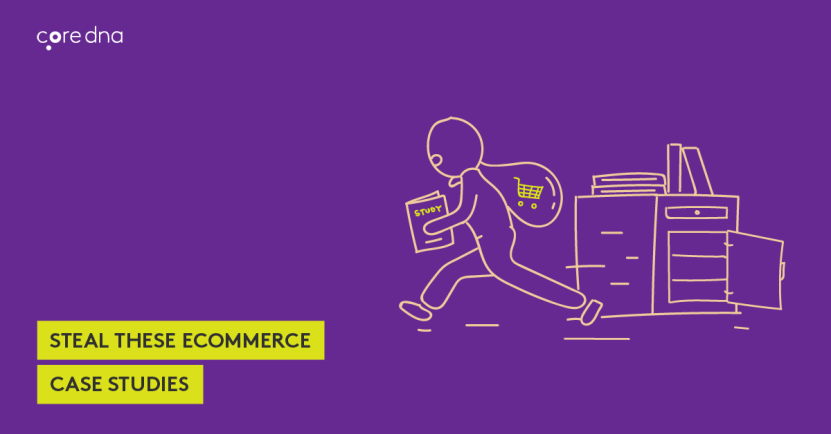
You’ve heard it before - always be testing.
But if you’re running an eCommerce business then the tasks of analyzing your site data and identifying leaks in the funnel usually get pushed to the bottom of your to-do list. Let's face it, you’ve got 97 other things you SHOULD be doing today.
So with that in mind, we've pulled together the following 19 real-world eCommerce lessons to help you cut straight to the chase in implementing some simple solutions to increase your online sales.
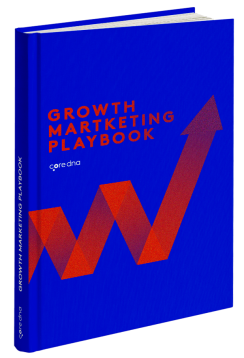
Growth Marketing Hacks for 2022
We share how we grew from 4-figure to 6-figure traffic in just one year.
In a hurry? Here are some eCommerce studies you need to steal from:
- How to improve Conversion: Envelopes.com achieve 40%
- How to improve Communication: Budapester increased mobile conversion by 29%
- Make small changes: Edible Arrangements increases same-day sales by 8%
- Make product benefits clear: Amerisleep increased checkouts by 13.9%
- Reduce website friction: Company Folders increase conversion by 68%
- Try cross selling products: Furniture retailer increased its AOV by 4.6% in 41 days
- Reduce clutter and distractions: Taloon.com ditched social buttons
- Use influencers to reach customers: Gwynnie Bee saw 5.85% CTR from Youtube influencer
- Reduce risk of purchase: Express Watches provides authenticity stamp
- Use events to drive sales: eCommerce companies saw a 27% spike during football world cup
- Remove distractions: Underwater Audio bump sales by 41%
- Get customers to take the next step: Kettlebell Kings’s takes advantage of user generated content to drive sales
- Use comparison data: Paperstone took out their competition with data
- Test and measure results: MVMT generated $90M in revenue in five years
- Find alternate channels: ECCO Shoes decreased customer acquisition costs by 14%
- Move past the product: Away generated $125M by standing out
- Drive inbound through content marketing: Bavarian Clockworks reached $1m in sales
- Build loyal engaged followers: Frank Body hit $20M in annual sales
- Be relevant to your customers: Society Socks improved survey response rate by 200%
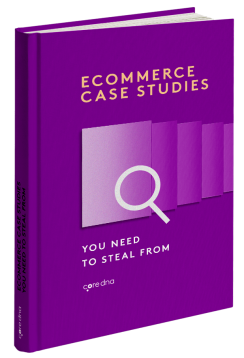
19 eCommerce Case Studies to Double Your Sales
19 eCommerce case studies you need to learn from.
[eCommerce case study #1] How to improve Conversion: Envelopes.com achieve 40%
A common eCommerce problem is prospects exiting the page before completing their order. As consumers, we've all done it before. So the team at Envelopes.com wanted to see if they could “rekindle the flame” and land some sales from hot leads using target followups. These are visitors who created an account and put an item in their shopping cart, so we can see some real intent to purchase at some stage down the track.
The Envelopes.com team were confident that sending targeted follow-up emails generally resulted in sales but weren’t sure of the best timeframe to send them. So they tested out email sends at two alternate time lapses post cart abandonment; the first group sent the following morning at 11 a.m. and the second group 48 hours post cart abandonment.
The emails sent at 11 a.m. the following day delivered:
- an open rate of 38.63%
- a click-through rate of 19.54% and
- a conversion rate to a sale of 27.66%
The emails sent after 48 hours delivered:
- an open rate of 38.01%
- a click-through rate of 24.71% and
- a conversion rate of 40.00%
Although sending these emails on the following day post cart abandonment had a slightly higher open rate, the most important figure, conversion to sale was significantly lower.
Take home message
Send a follow-up email to people who abandon their carts, if you’re not already doing it. Though Envelopes.com found that 48hrs later was the best performing time, a different cadence and time lag may work better with your customer base, so test out multiple alternatives. If you're looking for some assistance on the creative messaging front, we have included the exact email creative used by Envelopes.com here:

(Envelopes.com Reminder Email 1)

(Envelopes.com Reminder Email 2)

(Envelopes.com Reminder Email 3)
[eCommerce case study #2] How to improve Communication: Budapester increased mobile conversion by 29%
As anyone in the eCommerce realm can attest to, it can be pretty disheartening when a major influx in traffic doesn’t lead to an equally major spike in sales.
Unfortunately, that’s exactly what happened to German luxury fashion retailer Budapester a few years back.
Astoundingly, the brand’s website had been seeing hundreds of thousands of visitors each month—but its conversion rates were absolutely abysmal. The problem was even worse on mobile, where Budapester’s conversion rate was less than half that of its desktop alternative.
Upon realizing something needed to be done, the company’s first order of business was to communicate its unique selling propositions and other offers and policies more clearly to its visitors. This meant displaying information regarding free delivery, shipping options , and product availability prominently within its individual product pages:

(Budapester website | Source)
Along with this, Budapester also tweaked its site’s header—specifically, decreasing the logo’s size, and adding the above-mentioned info at the very top of the page. Again, this made it much easier for visitors to learn about these policies and offers right away.
Finally, the team also tweaked the appearance of its shopping cart page. From this...

(Source | Budapester shopping cart – Before)

(Source | Budapester shopping cart - After)
Once more, the above information is now prominently displayed to the consumer—this time in two ways. In addition to the change to the header, the website now displays the company’s offer for free shipping in a green font that stands out at the bottom of the screen.
The end result of Budapester’s efforts, as Growcode explains :
“Its overall conversion rate increased by 12.5%, with its mobile conversion rate going up by nearly 30%. All in all, this equated to an additional 120,000€.”
There are three main lessons to take away, here:
Firstly, it’s essential that you communicate your value to your potential customers in a clear and concise manner. If you offer something of value—say, free shipping on orders over $100—but you don’t tell your visitors about it...how are they supposed to know?
On the other side of this, you want to avoid including redundant or unnecessary information anywhere on your eCommerce website. Not only might this be distracting to your visitors, but it also takes up physical space on your site that could have been put to better use.
Finally, it’s worth pointing out that optimizing your site might not mean you need to do a complete overhaul. As was the case with Budapester, a few tiny, seemingly insignificant tweaks can be all your site needs to start generating a massive amount of conversions.
[eCommerce case study#3] Make small changes: Edible Arrangements increases same-day sales by 8%
Edible Arrangements had a fairly typical marketing challenge . They offer customers a same-day delivery option (and have done so for years) but people weren’t taking advantage of the offer because they didn’t know about it.
To educate customers about this option they significantly increased visibility with a large banner in an extremely prominent position on the homepage, just below the navigation bar. This created urgency around the offer by featuring a countdown timer to the deadline for same day delivery. It was impossible to miss or misunderstand.

(Edible Arrangements website)
The result of this simple countdown feature? An increase in same-day sales by 8% !
You don’t need a new product to promote something. People might not know about a product or service you already have in play, so by increasing visibility to your existing audience, you may be able to snap up some quick wins. As a side note on this particular example, creating some urgency is always a good sales strategy. Encourage your audience to act now, instead of later (or never).
[eCommerce case study #4] Make product benefits clear: Amerisleep increased checkouts by 13.9%
Online mattress retailer Amerisleep had a problem that was quite similar to Budapester’s:
The company was seeing a ton of traffic on its website, but its conversion rates were nowhere near where the team would have liked them to be.
However, with the help of Growth Rock , Amerisleep decided to take a different approach to improving its website:
Rather than adding or deleting certain information, the team decided to focus on improving the messaging of the site’s copy—in a few ways.
First, the team dug deeper into the true benefits their products provide their customers. In Amerisleep’s case, this meant going beyond promising “a good night’s sleep,” and instead focusing on how getting a good night’s sleep every night can be absolutely life-changing.

(What would you do with more energy and less pain? | Source)
Secondly, the team aimed to reduce hesitation among its visitors by addressing the importance of immediate action. Rather than discussing the above benefits in a more hypothetical manner, the site’s copy was adjusted to address the idea that every night spent tossing and turning is another night visitors will never get back.
Lastly, the team tweaked some rather ambiguous copy comparing Amerisleep’s products to its competitors’ and made it more clear.
Originally, the website had made claims such as “No mattress is more carefully engineered.” The problem, here, is that this could be interpreted as “No mattress is more carefully engineered—but many are engineered equally as carefully as ours.”
The new copy read:
“Our innovative and proprietary materials let us build one of the most comfortable mattresses ever”
Much stronger, no?
Again, these relatively minor tweaks had major implications for Amerisleep: That 13.9% increase in conversion rate we mentioned equated to millions of dollars in added revenue over the course of the next year .
The overarching takeaway here is to write your copy with your audience in mind at all times.
This means:
- Ensuring they understand the true value your product will bring to their lives, and what it will enable them to do or accomplish
- Instilling a sense of urgency in your visitors, so they not only understand what they have to gain from using your product, but also what they have to lose by not using it
- Double- (triple-, and quadruple-) checking your copy to be absolutely certain it means what you want it to mean—and that your visitors will interpret it in the same way
[eCommerce case study #5] Reduce website friction: Company Folders increase conversion by 68%
Company Folders is an established business but had a website that their CEO admitted was “obviously last year”, which is putting it gently.
The main problem they wanted to remedy was their online quote function. This is a vital step in their marketing funnel, so making the process as smooth as possible was essential to ultimately driving more sales for the business.
This sounds a simple task but with over 15 million product combinations, the current quoting system was highly complex. Further to this, there was a very high rate of prospects dropping out of the form partially completed.
Intuitively they assumed that getting the form onto a single page would help get prospects through the process, but after surveying their best customers, they realized that a redesign was necessary.
They took a cumbersome single step process with lots of options and broke it up into a multi-step bite size process (pictured below). Doing this resulted in a whopping 67.68% increase in total quotes .

(Company folders website)
Take home message #3
Breaking down a complicated system into manageable smaller steps can help keep people focused and increase conversion . Though additional clicks can often be seen as new opportunities to lose customers, the Company Folders experience tells us that streamlining to shorter stepped forms is the way to go right now.
![case study e commerce Form 48 - Going D2C [Guide]](https://www.coredna.com/files/images/pages/185/FULL-SIZE-to-Going-Direct-to-Consumer.webp?f=png&w=244&h=358&s=fit)
Going Direct-to-Consumer: The Definitive Guide
The definitive guide to going direct to consumer.
[eCommerce case study #6] Try cross selling products: Furniture retailer increased its AOV by 4.6% in 41 days
(Note: For this study, the company did not wish to be named, so we will, of course, respect their privacy)
Perhaps the only thing better than getting potential customers to convert in the first place is getting them to add even more items to their cart before converting.
Our anonymous furniture company knows this—which is why they had been aiming to cross-sell a conditioning kit to customers purchasing leather furniture from their online store.
While sales of the company’s “main” products (i.e., furniture) were pretty decent, sales of these smaller complementary items weren’t all that great. The main problem was that most customers simply weren’t even aware the company offered the conditioning kit in the first place. Basically, the only way they would be exposed to the product is if they were to actively browse for it on the company’s website.
(We should also note that the price of the item being cross-sold costs only about 6% of the company’s average order value, while still adding a ton of value to the main product. In other words, making the additional purchase should have been a no-brainer.)
Knowing they needed to do a better job promoting such smaller-ticket items, the company decided to include a call-to-action directly within the shopping cart page when customers added an applicable big-ticket item to their cart.
So, the page went from looking like this:

(Your Shopping Cart | Source)
...to looking like this:

( Your Shopping Cart | Source)
Customers were then able to add the supplementary item to their cart with a single click (by clicking the plus sign), and could also visit the smaller item’s product page by clicking anywhere else within the pink bar.
The results were nothing short of amazing: As per Growth Rock’s data , the company’s average order value had increased by $55 (4.6%) in only 41 days . This equates to an additional $180,000 in monthly revenu e!
The first takeaway, here, is that successfully cross-selling relevant items that add value to your bigger-ticket items (and that add value to your customer experience ) can have a major impact on your overall revenues.
But simply offering such supplementary products isn’t enough on its own. You also need to promote these items specifically as supplementary to the more valuable and expensive items you offer.
(For example, it’s more likely that consumers visiting a furniture eCommerce site will purchase leather cleaner if they’re in the market for leather furniture. That being the case, you’d want to focus on promoting the product specifically to these individuals.)
Going along with this, you also need to present your cross-sell offer at just the right time to get your customers to bite. Here, the company did so as visitors showed a high probability of making a large purchase — a prime moment to add extra value to their overall experience with the brand.
[eCommerce case study #7] Reduce clutter and distractions: Taloon.com ditched social buttons
Taloon.com got caught up in the trend towards social proof, with "Like” and "Share“ icons on their product pages. However, they noticed unusually low conversions on pages with those social sharing buttons.
To test what was going on they created two variants of the same page with and without the social share icons.

(Taloon.com website)
They assumed that by de-cluttering the page, it would keep customers focused on the task at hand - checking out.
The results?
“Pages without social share icons saw an improved “add to cart” click-through by 12% ”
Just because everyone else is doing it doesn’t make it right. Always put yourself in the mindset of your customer, and keep them focused on the main task you want them to complete. Declutter pages with unnecessary actions to focus on making the sale.
[Ecommerce case study #8] Use influencers to reach customers: Gwynnie Bee saw 5.85% CTR from Youtube influencer
By now, you’re probably well aware of how effective influencer marketing can be in spreading brand awareness and social proof, and increasing engagement among your target audience members.
A few years ago, rental clothing e-retailer Gwynnie Bee realized this exact same thing. While the team had experienced a decent amount of success using a number of other marketing strategies (such as Facebook Ads), they knew they could be generating a lot more business than they were.
So, the company partnered with Reelio to get the ball rolling.
Working with Reelio, Gwynnie Bee began digging through YouTube’s massive database of influencers in search of those who aligned with the clothing company’s target market.

(Search results for "plus size" on Youtube)
The team’s first order of business was to create a list of potential candidates who fit the “surface-level” characteristics of their target market. This meant finding influencers who were female, aged 18 or older, and who typically wore clothing of sizes 10-32.
Now, here’s where Gwynnie Bee diverged from the “typical” path most brands take. Rather than looking specifically for individuals who often worked with other fashion companies, GB also considered those whose audience overlapped with their own. This meant looking at influencers who create content related to more tangential topics, such as lifestyle, accessories, food, and more.
The team then developed guidelines for their chosen influencers, which enabled them to create content that was authentic and non-scripted—but that also aligns with Gwynnie Bee’s overall marketing goals, as well. In addition to creating content to be presented on the influencer’s channel, GB’s influencers also created a virtual “closet” on the brand’s website to showcase the specific items they loved most.
The results of Gwynnie Bee’s influencer campaigns were...well...pretty darn good. While the average click-through rate of all influencer campaigns hovers around the 2% mark, GB’s campaigns saw a CTR of 5.85% — nearly three times the average .
If you’re just getting started with influencer marketing, the main thing to focus on is finding content creators with an engaged audience full of consumers who align in some way with your own target market. They don’t have to overlap entirely, but you, of course, want to be sure that the people who end up seeing your products will have a genuine appreciation for, and interest in, your brand.
As far as content creation goes , you’ll want to provide your influencer’s with almost completely free rein in order to ensure authenticity. This will communicate to your influencer’s audience the idea that the influencer actually uses your products, and aren’t simply promoting them because they’re getting paid for it.
Finally, you might also consider inviting your influencers to create content on your channels as well as their own platforms. Again, this will prove to their audience that they truly are superfans of your brand who actively engage with everything your company has to offer.
[eCommerce case study #9] Reduce risk of purchase: Express Watches provides authenticity stamp
This is a classic problem for online stores; Do you boast the lowest price or the most authentic products ?
The team at Express Watches were debating whether to communicate a ‘lowest price guarantee’ versus a stamp of authenticity on their website. They tested variants with both, each telling a different story about the clientele: bargain hunters vs aficionados. The results were pretty surprising.

(Lowest prices vs highest authenticity)
By labeling the site with a badge of authenticity, Express Watches saw an increase in online sales of 107% . A huge differential from the price based messaging, simply from a little seal of authenticity.
You may think you know what your audience wants, but testing out some alternate value proposition could surprise you.
[eCommerce case study #10] Use events to drive sales: eCommerce companies saw a 27% spike during football world cup
The Soccer/Football World Cup is not only the most-watched sporting event on television of the 21 st century – it is the most-watched event of any kind, period.
Needless to say, such an enormous audience makes for some major opportunities for eCommerce companies all over the world.
Of course, it also made for heft competition for brands operating in niches like sporting goods, clothing, and memorabilia.
As SEMRush explains, the brands that came out on top were the ones who:
- Increased their presence on the right channels (specifically, social media),
- Adjusted their ad copy to target soccer fans from specific nations (e.g. whose teams were making a run for the World Cup)
- Developed relevant and valuable offers to address time-sensitivity (e.g. fast and free shipping to ensure orders were received before the Wolrd Cup had ended)
The opportunistic initiatives led to some MASSIVE revenues for eCommerce companies. In Brazil, eCommerce purchases spiked by $16.6 BILLION, or 27% above the average . After Germany ended up winning, German-based eCommerce activity increased by a whopping 75%!
First and foremost – and this goes any business, online or brick-and-mortar – you need to recognize an opportunity when it comes up and strike when the iron’s hot.
With this in mind, it’s worth noting that Brazillian-based eCommerce activity dropped by 17% immediately once the national team was eliminated from the tournament.
As far as recognizing these opportunities, you’ll want to keep an eye on upcoming events – be it a sports tournament, music festival, fashion show, etc. – that relate, in some way, to your brand’s offerings.
The goal is to “piggyback” off of the hype created by these events and market your products to those who are attending or engaged with the event in some way or another.
There are two main ways to go about this:
You might simply do as the brands mentioned above did, and ramp up your marketing initiatives throughout the timespan of the event, or, if possible, reach out to the host of the event to see if they’d be interested in partnering up in some way. This might mean sponsoring the event (in lieu of upping your ad spend) or even setting up a pop-up shop at the actual event
[eCommerce case study #11] Remove distractions: Underwater Audio bump sales by 41%
Underwater Audio had a problem with visitors who were in the middle of their sales funnel, researching specific products but then dropping off at the comparison page. When they noticed this leak they decided to get to the bottom of it.
Here are the old and new versions of the page. At first glance, they don’t look too different, but the devil is in the detail.

(Underwater Audio website page comparison)
The original one was a bit more cluttered with the table formatting breaking up the flow of information. To test what the problem was, they redesigned the comparison page to make it simpler and more streamlined.
As their CEO said:
“The (rather) unattractive table had information in terse phrases organized in no particular fashion (activity, seal, size, features, warranty, depth). The paragraphs continued below the fold and essentially repeated the table, with only a few unique additions hidden in the text. In short, it was not the most engaging page!”
The new version did away with the data tables, streamlined the text, and put everything above the fold.
The result? The redesigned page had an increase in online sales of 40.81% .
To quote Occam's Razor, “the simplest solution is often the best” and the simpler flow worked wonders for Underwater Audio. Find pages in your pipeline where users are dropping off and see how you can simplify them to focus your customers.
[eCommerce case study #12] Get customers to take the next step: Kettlebell Kings’s takes advantage of user generated content to drive sales
In yet another case of “x isn’t working as well as we thought, let’s try something else,” the owners of fitness equipment startup Kettlebell Kings switched to a more organic approach after realizing their Google Ads campaigns were costing the company way too much money.
The team’s main focus: Instagram.
Their initiative started simply enough, creating instructional content focused on teaching their audience how to get the most out of their workout sessions.
As engagement began to soar, the team also noticed that its customers had also begun creating their own content featuring Kettlebell Kings’ products—which led the company to begin using this UGC to their advantage.

Hailing from Ireland, Paul is a fan of good food and coffee. For Core dna he’s responsible for Partnerships both with agencies and 3 rd party integrators.
Related posts

eCommerce Business
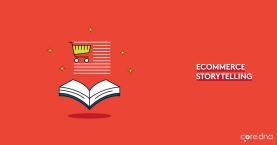
Content Marketing
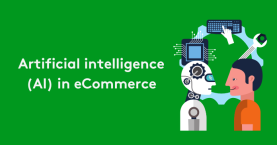
Platform Strategies
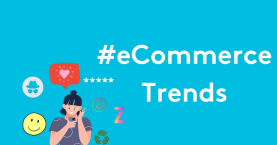
Commerce insights
The 24 Best eCommerce Retail Case Studies Worth Reading

In the fast-paced world of retail and eCommerce, staying ahead of the game is not just a goal; it’s the lifeline of our industry. For seasoned retail executives, inspiration often comes from the experiences and successes of industry giants who paved the way with their innovative thinking and managed to thrive through thick and thin. That’s why we’re excited to bring you an exclusive collection of the 30 best eCommerce case studies meticulously curated to provide you with a wealth of insights and ideas to fuel your strategies. These case studies are more than just success stories; they are beacons of guidance for retail professionals navigating the ever-changing landscape of our industry.
In this article, we delve deep into the journeys of retail giants who have not only weathered the storms of disruption but have emerged as trailblazers in eCommerce. From adapting to shifting consumer behaviors to mastering the art of online engagement, this compilation offers a treasure trove of wisdom for the modern retail executive.
Table of Contents
- > Case studies for grocery/wholesale eCommerce retailers
- > Case studies for fashion eCommerce retailers
- > Case Studies for home & furniture eCommerce retailers
- > Case Studies for health & beauty eCommerce retailers
- > Case studies for electronics and tools eCommerce retailers
- > Case Studies for toys and leisure eCommerce retailers
Case studies for grocery/wholesale eCommerce retailers
Retail case study #1: tesco .

Industry : Grocery stores
Why worth reading:
- Historical evolution: Understanding Tesco’s rise from a group of market stalls to a retail giant provides valuable lessons on growth and adaptation to market changes.
- Customer service focus: Tesco’s long-term emphasis on customer service, which is consistent across their physical and online platforms, showcases the importance of customer-centric strategies.
- Innovation in eCommerce: The case study covers Tesco’s pioneering of the world’s first virtual grocery store in South Korea, a testament to its innovative approach to digital retailing.
- Crisis management: Insights into how Tesco handled the Horse Meat Scandal, including efforts to tighten its supply chain, contributing to its logistical success.
- Financial integrity: The study discusses the Accounting Scandal, offering a sobering look at financial transparency and the repercussions of financial misreporting.
Read the full Tesco case study here .
Retail case study #2: Walmart

Industry : Discount department and grocery stores
- Data-driven success: The case study provides a wealth of data, showcasing Walmart’s remarkable achievements. With an annual revenue of almost $570 billion, a global presence in 24 countries, and a customer base exceeding 230 million weekly, it’s a testament to the effectiveness of their strategies.
- Marketing strategies: The case study delves deep into Walmart’s marketing strategies. It highlights their focus on catering to low to middle-class demographics, the introduction of the Walmart Rewards loyalty program, and their commitment to environmental sustainability, all of which have contributed to their success.
- eCommerce transformation: As eCommerce continues to reshape the retail landscape, this case study details how Walmart shifted significantly towards omnichannel retail. Readers can learn about their innovative technologies and approaches, such as personalized shopping experiences and augmented reality, that have helped them adapt to changing consumer behavior.
- Supply chain innovation: Walmart’s proficiency in supply chain management is a crucial takeaway for retail executives. Their decentralized distribution center model , in-house deliveries, and data-driven optimization exemplify the importance of efficient logistics in maintaining a competitive edge.
Read the full Walmart case study here .
Retail case study #3: Sainsbury’s

Industry : Grocery stores
- Omnichannel success amidst pandemic challenges: With the fastest growth in online shopping among major retailers, the study illustrates how Sainsbury’s adapted and thrived during unprecedented times.
- Dynamic brand positioning: The analysis delves into Sainsbury’s strategic shift in brand positioning, demonstrating a keen responsiveness to changing consumer preferences. This shift showcases the brand’s agility in aligning with contemporary health-conscious consumer trends, supported by relevant data and market insights.
- Supply chain and quality assurance: The study highlights Sainsbury’s commitment to a stellar supply chain, emphasizing the correlation between high product quality, ethical sourcing, and customer loyalty. With data-backed insights into the extensive distribution network and sourcing standards, retail executives can glean valuable lessons in maintaining a competitive edge through a robust supply chain.
- Innovative technological integration: Sainsbury’s implementation of cutting-edge technologies, such as Amazon’s “Just Walk Out” and Pay@Browse, demonstrates a commitment to providing customers with a seamless and convenient shopping experience.
- Diversification beyond grocery: The case study unveils Sainsbury’s strategic partnerships with companies like Amazon, Carluccio’s, Itsu, Leon, and Wasabi, showcasing the brand’s versatility beyond traditional grocery retail.
Read the full Sainsbury’s case study here .
Retail case study #4: Ocado

- From startup to industry leader: The Ocado case study presents a remarkable journey from a three-employee startup in 2000 to becoming the UK’s largest online grocery platform.
- Omnichannel excellence: The study emphasizes Ocado’s success in implementing an omnichannel approach, particularly its early adoption of smartphone technology for customer engagement.
- Operational efficiency: From automated warehouses with machine learning-driven robots to digital twins for simulating order selection and delivery processes, the data-rich content sheds light on how technology can be leveraged for operational efficiency.
- Navigating challenges through innovation: Ocado’s strategic response to challenges, particularly its shift from primarily a grocery delivery service to a technology-driven company, showcases the power of innovative thinking. The case study details how Ocado tackled complexities associated with grocery deliveries and embraced technology partnerships to stay ahead.
- Strategic partnerships: The study sheds light on Ocado’s strategic partnerships with grocery chains and companies like CitrusAd for advertising opportunities on its platform.
Read the full Ocado case study here .
Retail case study #5: Lidl

Industry : Discount supermarkets
- Longevity and evolution: The article provides a detailed overview of Lidl’s origins and evolution, offering insights into how the brand transformed from a local fruit wholesaler to a global retail powerhouse. Understanding this journey can inspire retail executives to explore innovative strategies in their own companies.
- Global success: Retail executives can draw lessons from Lidl’s international expansion strategy, identifying key factors that contributed to its success and applying similar principles to their global ventures.
- Awards and recognitions: The numerous awards and accomplishments earned by Lidl underscore the effectiveness of its marketing strategy. Marketers and eCommerce professionals can learn from Lidl’s approach to quality, innovation, and customer satisfaction.
- Comprehensive marketing components: The article breaks down Lidl’s marketing strategy into key components, such as pricing strategy, product diversification, and target audience focus. Readers can analyze these components and consider incorporating similar holistic approaches in their businesses to achieve well-rounded success.
- Omnichannel transformation: The discussion on Lidl’s transformation to an omnichannel strategy is particularly relevant in the current digital age. This information can guide executives in adopting and optimizing similar omnichannel strategies to enhance customer experiences and drive sales.
Read the full Lidl case study here .
Retail case study #6: ALDI

Industry : FMCG
- Omnichannel approach: Aldi’s growth is attributed to a robust omnichannel strategy that seamlessly integrates online and offline channels. The case study delves into how Aldi effectively implemented services that can overcome the intricacies of a successful omnichannel approach in today’s dynamic retail landscape.
- Target market positioning: Aldi’s strategic positioning as the most cost-effective retail store for the middle-income group is explored in detail. The case study elucidates how Aldi’s pricing strategy, emphasizing the lowest possible prices and no-frills discounts, resonates with a wide audience.
- Transparency: Aldi’s commitment to transparency in its supply chain is a distinctive feature discussed in the case study. For retail executives, understanding the importance of transparent supply chain practices and their impact on brand perception is crucial in building consumer trust.
- Differentiation: Aldi’s successful “Good Different” brand positioning, which communicates that low prices result from conscientious business practices, is a key focus of the case study. Effective differentiation through brand messaging contributes to customer trust and loyalty, especially when combined with ethical business practices.
- CSR Initiatives: The case study highlights Aldi’s emphasis on social responsibility to meet the expectations of millennial and Gen-Z shoppers. By consistently communicating its CSR efforts, such as sustainable sourcing of products, Aldi creates a positive brand image that resonates with socially conscious consumers and builds brand reputation.
Read the full Aldi case study here .
Retail case study #7: ASDA

Industry : Supermarket chain
- Omnichannel implementation: The case study details how ASDA seamlessly integrates physical and virtual channels, offering customers a diverse shopping experience through in-store, digital checkouts, Click & Collect services, and a dedicated mobile app.
- Market segmentation strategies: The incorporation of partnerships with young British designers and influencer collaborations, coupled with socially progressive messaging, reflects a strategic shift that can inspire marketers looking to revitalize product lines.
- Crisis management and ethical branding: The study highlights ASDA’s strong response to the COVID-19 crisis, with ASDA’s actions showcasing a combination of crisis management and ethical business practices. This section provides valuable insights for executives seeking to align their brand with social responsibility during challenging times.
- Product and format diversification: ASDA’s product categories extend beyond groceries, including clothing, home goods, mobile products, and even insurance. The case study explores how ASDA continues to explore opportunities for cross-promotion and integration.
- Website analysis and improvement recommendations: The detailed analysis of ASDA’s eCommerce website provides actionable insights for professionals in the online retail space. This section is particularly beneficial for eCommerce professionals aiming to enhance user experience and design.
Read the full ASDA case study here .
Case studies for fashion eCommerce retailers

Retail case study #8: Farfetch
Industry : Fashion retail
- Effective SEO strategies: The Farfetch case study offers a detailed analysis of the company’s search engine optimization (SEO) strategies, revealing how it attracted over 4 million monthly visitors. The data presented underscores the importance of patient and dedicated SEO efforts, emphasizing the significance of detailed page structuring, optimized content, and strategic backlinking.
- Paid search advertising wisdom and cost considerations: The study delves into Farfetch’s paid search advertising approach, shedding light on its intelligent optimization tools and the nuances of running localized advertisements. Moreover, it discusses the higher cost of visitor acquisition through paid search compared to organic methods, providing valuable insights for marketers navigating the paid advertising landscape.
- Innovative LinkedIn advertising for talent acquisition: Farfetch’s unique use of LinkedIn advertising to attract talent is a standout feature of the case study and highlights the significance of proactive recruitment efforts and employer branding through social media channels.
- Strategic use of social media platforms: Exploring the brand’s highly consistent organic marketing across various social media channels, with a focus on visual content, highlights Farfetch’s innovative use of Instagram’s IGTV to promote luxury brands. The emphasis on social media engagement numbers serves as a testament to the effectiveness of visual content in the eCommerce and fashion sectors.
- Website design and conversion optimization insights: A significant portion of the case study is dedicated to analyzing Farfetch’s eCommerce website, providing valuable insights for professionals aiming to enhance their online platforms. By identifying strengths and areas for improvement in the website’s design, marketers, and eCommerce professionals can draw actionable insights for their platforms.
Read the full Farfetch case study here .
Retail case study #9: ASOS

Industry : Fashion eCommerce retail
- Mobile shopping success: eCommerce executives can draw inspiration from ASOS’s commitment to enhancing the mobile shopping experience, including features such as notifications for sale items and easy payment methods using smartphone cameras.
- Customer-centric mentality: ASOS emphasizes the importance of engaging customers on a personal level, gathering feedback through surveys, and using data for continuous improvement. This approach has contributed to the brand’s strong base of loyal customers.
- Inclusive marketing: ASOS’s adoption of an ‘all-inclusive approach’ by embracing genderless fashion and featuring ‘real’ people as models reflects an understanding of evolving consumer preferences. Marketers can learn from ASOS’s bold approach to inclusivity, adapting their strategies to align with the latest trends and values embraced by their target audience.
- Investment in technology and innovation: The case study provides data on ASOS’s substantial investment in technology, including visual search, voice search, and artificial intelligence (AI). eCommerce professionals can gain insights into staying at the forefront of innovation by partnering with technology startups.
- Efficient global presence: ASOS’s success in offering a wide range of brands with same and next-day shipping globally is attributed to its strategic investment in technology for warehouse automation. This highlights the importance of operational efficiency through technology, ensuring a seamless customer experience and reduced warehouse costs.
Read the full ASOS case study here .
Retail case study #10: Tommy Hilfiger

Industry : High-end fashion retail
- Worldwide brand awareness: The data presented highlights Tommy Hilfiger’s remarkable journey from a men’s clothing line in 1985 to a global lifestyle brand with 2,000 stores in 100 countries, generating $4.7 billion in revenue in 2021. This strategic evolution, exemplified by awards and recognitions, showcases the brand’s adaptability and enduring relevance in the ever-changing fashion landscape.
- Adaptation and flexibility to changing market trends: The discussion on how the brand navigates changing trends and overcame market saturation, particularly in the US, provides practical insights for professionals seeking to navigate the challenges of evolving consumer preferences.
- Successful omnichannel marketing: Tommy Hilfiger’s success is attributed to a brand-focused, digitally-led approach. The analysis of the brand’s omnichannel marketing strategy serves as a map for effective promotion and engagement across various channels.
- Decision-making and customer engagement: The case study emphasizes the brand’s commitment to data-driven decision-making with insights into customer behavior, leveraging data for effective customer engagement.
Read the full Tommy Hilfiger case study here .


Retail case study #11: Gap

- Overcoming challenges: The case study provides a comprehensive look at Gap Inc.’s financial performance, and growth despite the challenges. These insights can offer valuable takeaways into effective financial management and strategies for sustained success.
- Strong branding: Gap’s journey from a single store to a global fashion retailer reveals the importance of strategic brand positioning. Understanding how Gap targeted different market segments with unique brand identities, can inspire retail executives looking to diversify and expand their brand portfolios.
- Omnichannel adaptation: The case study delves into Gap’s omnichannel strategy, illustrating how the company seamlessly integrates online and offline experiences.
- Unique use of technology: By exploring the technologies Gap employs, such as Optimizely and New Relic, retail executives can learn about cutting-edge tools for A/B testing, personalization, and real-time user experience monitoring. This insight is crucial for staying competitive in the digital retail landscape.
- Inspiring solutions: The case study highlights challenges faced by Gap, including logistical, technological, financial, and human resource challenges.
Read the full Gap case study here .
Retail case study #12: Superdry

- Success story: The case study emphasizes SUPERDRY’s successful transition to an omnichannel retail strategy, with in-depth insights into their adaptation to online platforms and the integration of technologies like the Fynd app.
- Mobile-first and social-first strategies: As mobile internet usage continues to rise, understanding how SUPERDRY leverages videos and social media to engage customers can offer valuable takeaways for optimizing digital strategies.
- Sustainable fashion focus: Executives looking to appeal to environmentally conscious consumers can gain insights into how SUPERDRY navigated the shift towards sustainable practices and became a leader in eco-friendly fashion.
- Data-driven marketing strategies: The case study delves into SUPERDRY’s social media marketing strategies, showcasing how the company uses targeted campaigns, influencers, and seasonal keywords.
- Global market understanding: By exploring SUPERDRY’s experience in the Chinese market and its decision to exit when faced with challenges, the case study offers valuable insights into global market dynamics.
Read the full SUPERDRY case study here .
Retail case study #13: New Look

Industry : Fast-fashion retail
- Strategic pivots for profitability: A decade of revenue contraction led New Look to adopt transformative measures, from restructuring credits to withdrawing from non-profitable markets.
- Omnichannel strategy: Marketers and eCommerce professionals can study New Look’s journey, understanding how the integration of physical stores and online platforms enhances customer experience, reduces costs, and improves profitability.
- Social media mastery: The case study underscores the pivotal role of social media in engaging audiences, showcasing how New Look leverages user-generated content to build brand loyalty and maintain a positive brand perception.
- Effective partnerships for growth: New Look strategically partners with major eCommerce platforms like eBay & Next to expand its brand presence, and tap into new audiences and markets.
Read the full New Look case study here .
Retail case study #14: Zara

- Rapid international expansion through innovative strategies: Zara’s unique approach to continuous innovation and quick adaptation to fashion trends fueled its global success. Marketers can learn how to build brand narratives that resonate across diverse markets, and eCommerce professionals can glean strategies for seamless international expansion.
- Revolutionary eCommerce tactics: The case study provides a deep dive into Zara’s eCommerce strategy, emphasizing the importance of agility and responsiveness. The brand can be a bright example of implementing supply chain strategies for a swift market adapting to rapid fashion cycles.
- Visionary leadership: Amancio Ortega’s low-profile persona and visionary leadership style are explored in the case study, aiding retail executives to learn about leadership strategies that prioritize customer-centric business models.
- Omnichannel marketing and integrated stock management: Zara’s successful integration of automated marketing and stock management systems is a focal point in the case study. With insights into implementing integrated stock management systems to meet the demands of both online and offline channels, Zara can inspire professionals to improve their operations.
- Co-creation with the masses: Zara’s innovative use of customer feedback as a driving force for fashion trends is a key takeaway. Marketers can learn about the power of customer co-creation in shaping brand identity, and eCommerce professionals can implement similar models for product launches and updates.
Read the full Zara case study here .
Case Studies for home & furniture eCommerce retailers
Retail case study #15: john lewis.

Industry : Homeware and clothing retail
- Omnichannel perspective: The data-driven approach, especially in tracking orders and customer behavior, serves as a blueprint for any retail business aiming to enhance its omnichannel experience.
- Strategic growth factors: This case study offers concrete data on the strategies that contributed to the company’s sustained success, inspiring similar endeavors.
- Innovative customer engagement: John Lewis’s take on customer engagement showcases the brand’s agility and responsiveness to evolving consumer needs, supported by data on the effectiveness of these initiatives.
- eCommerce best practices and pitfalls: The analysis of John Lewis’s eCommerce website provides a data-backed evaluation of what works and what could be improved. The critique is grounded in data, making it a valuable resource for those looking to optimize their online platforms.
Read the full John Lewis case study here .
Retail case study #16: Argos

Industry : Homeware catalog retail
- Adaptation to the changing retail landscape: Argos’s journey from a catalog retailer to a retail giant demonstrates its ability to successfully adapt to the evolving retail landscape.
- Omnichannel success story: The case study provides a detailed analysis of Argos’s omnichannel strategy, showcasing how the company effectively integrated online and offline channels to achieve a seamless shopping experience across multiple touchpoints.
- Market share and financial performance: The inclusion of data on Argos’s market share and financial performance offers retail executives concrete metrics to evaluate the success of the marketing strategy. Understanding how Argos maintained a robust market share despite challenges provides actionable insights.
- Technological advancements: The case study delves into the technologies employed by Argos, such as Adobe Marketing Cloud, New Relic, and ForeSee.
- Overcoming obstacles: By examining the challenges faced by Argos, including logistical, technological, financial, and human resources challenges, retail executives can gain a realistic understanding of potential obstacles in implementing omnichannel strategies.
Read the full Argos case study here .
Retail case study #17: IKEA

Industry : Home & furniture retail
- Data-driven evolution: This detailed case study offers a data-rich narrative, illuminating the brand’s evolution into a leader in omnichannel retail.
- Pandemic response: This exploration delves into the integration of eCommerce strategies, online expansions, and the balance between physical and digital customer experiences.
- Advanced mobile apps and AR integration: A deep dive into IKEA’s innovative applications, notably the AR app “IKEA Place,” showcases how the brand leverages technology for a seamless customer experience.
- Democratic design approach: The study meticulously breaks down IKEA’s success factors, emphasizing the brand’s holistic approach through the lens of “Democratic Design.”
- DIY mentality and demographic targeting: A detailed analysis of how IKEA’s affordability is intertwined with a Do-It-Yourself (DIY) mentality. The case study explores how IKEA strategically tapped into a shift in consumer behavior, particularly among younger demographics, influencing not only purchasing patterns but also reshaping industry norms.
Read the full IKEA case study here .
Retail case study #18: Marks & Spencer

Industry : Clothing and home products retail
- Valuable lessons in eCommerce: The Marks & Spencer eCommerce case study offers a profound exploration of the brand’s journey from a latecomer to the online scene to a digital-first retailer.
- Real-world application of effective solutions: By diving into the history of Marks & Spencer, the case study provides tangible examples of how a retail giant faced setbacks and strategically pivoted to revitalize its eCommerce platform.
- Data-driven analysis of eCommerce failures: The case study meticulously analyzes the pitfalls Marks & Spencer encountered during its eCommerce journey, offering a data-driven examination of the repercussions of a poorly executed website relaunch.
- Multichannel customer experience: Marks & Spencer’s shift towards a multichannel customer experience is dissected in the case study, emphasizing the significance of a seamless user journey for increased customer satisfaction and loyalty.
- Embracing technology: Exploring Marks & Spencer’s technological innovations, such as the introduction of an intelligent virtual assistant can enhance the customer shopping journey, foster engagement, and contribute to revenue growth.
Read the full Marks & Spencer case study here .
Retail case study #19: Macy’s

Industry : Clothing and homeware retail
- Resilience and adaptability: The case study showcases Macy’s ability to navigate and triumph over obstacles, especially evident during the COVID-19 pandemic. Despite hardships, Macy’s not only survived but thrived, achieving $24.4 billion in net sales for 2022.
- Omnichannel innovation: Macy’s successful transition to omnichannel retailing is a standout feature. The case study delves into Macy’s implementation of a seamless omnichannel strategy, emphasizing the integration of physical and digital retail channels.
- Private label strategy: The introduction of new private brands and the emphasis on increasing the contribution of private brands to sales by 2025 provides a strategic lesson. Retailers can learn from Macy’s approach to enhancing control over production and distribution by investing in private brands, ultimately aiming for a more significant share of profits.
- Groundbreaking retail media strategy: Macy’s innovative approach to retail media and digital marketing is another compelling aspect. For marketers, this presents a case study on how to leverage proprietary shopper data for effective advertising, including entry into connected TV (CTV).
- Community engagement and social responsibility: The case study explores Macy’s “Mission Every One” initiative, highlighting its commitment to corporate citizenship and societal impact, integrating values into business strategies.
Read the full Macy’s case study here .
Case Studies for health & beauty eCommerce retailers
Retail case study #20: the body shop .

Industry : Beauty, health, and cosmetics
- Activism and ethical values: The Body Shop has pioneered promoting eco-friendly, sustainable, and cruelty-free products. The brand’s mission is to empower women and girls worldwide to be their best, natural selves. This strong ethical foundation has been integral to its identity.
- Recycling, community fair trade, and sustainability: The Body Shop initiated a recycling program early on, which turned into a pioneering strategy. It collaborates with organizations to create sustainable solutions for recycling, such as the Community Trade recycled plastic initiative in partnership with Plastics for Change.
- Product diversity: The Body Shop’s target demographic primarily focuses on women, but it has expanded some product lines to include men. Its products include skincare, hair and body treatments, makeup, and fragrances for both men and women.
- Omnichannel strategy, technology, and eCommerce best practices: The Body Shop has embraced an omnichannel approach that incorporates personalization, customer data and analytics, and loyalty programs. The Body Shop utilizes technology, including ContactPigeon, for omnichannel customer engagement, personalization, and data-driven decision-making.
Read the full The Body Shop case study here .
Retail case study #21: Boots

Industry : Pharmacy retail
- Long-term success: Boots’ rich history serves as a testament to the effectiveness of the brand’s strategies over time, offering valuable insights into building a brand that withstands the test of time.
- Strategic omnichannel approach: The Boots case study provides a deep dive into the marketing strategy that propelled the brand to success, with valuable insights into crafting effective omnichannel growth.
- Impactful loyalty program: Marketers can glean insights into designing loyalty programs that resonate with customers, fostering brand allegiance.
- Corporate Social Responsibility (CSR) as a pillar: The case study sheds light on how Boots addresses critical issues like youth unemployment and climate change, showcasing how a socially responsible approach can positively impact brand perception.
- Adaptive strategies during crises: Boots’ proactive role during the COVID-19 pandemic, offering vaccination services and supporting the National Health Service (NHS), demonstrates the brand’s agility during crises.
Read the full Boots case study here .
Retail case study #22: Sephora

Industry : Cosmetics
- Authentic customer experience-focused mentality: Backed by an impressive array of data, the case study meticulously outlines how Sephora transforms its in-store spaces into digital playgrounds, leveraging mobile technologies, screens, and augmented reality to enhance the customer shopping experience.
- Exceptional omnichannel business plan: The early adoption of an omnichannel strategy has been pivotal to Sephora’s ascendancy. The case study delves into the mobile app’s central role, acting as a comprehensive beauty hub with data-driven insights that drive the success of groundbreaking technologies.
- Omnichannel company culture: The case study illuminates this by detailing how this amalgamation allows a holistic view of the customer journey, blurring the lines between online and in-store interactions. This unique approach positions Sephora as a global leader in turning omnichannel thinking into a robust business strategy.
- Turning data into growth: Sephora’s adept utilization of mobile technologies to harness customer insights is a beacon for retailers in an era where data reigns supreme. The case study dissects how a surge in digital ad-driven sales, showcases the power of data-driven decision-making.
Read the full Sephora case study here .
Case studies for electronics and tools eCommerce retailers
Retail case study #23: screwfix.

Industry : Tools and hardware retail
- Innovative omnichannel approach: The case study highlights how the company strategically implemented online ordering with in-store pickup, creating a seamless shopping experience that contributed to a significant sales growth of 27.9% in just one year.
- Customer-centric strategies: Marketers can gain insights from Screwfix’s emphasis on customer experience. By studying customer feedback and incorporating personalized shopping experiences, Screwfix achieved success in the competitive home improvement sector.
- Supply chain management for rapid growth: The company strategically opened distribution centers to keep up with demand, ensuring efficient inventory management for both online and in-store orders.
- Mobile-first approach for trade professionals: With a customer base primarily consisting of trade professionals, the company’s mobile app allows for easy inventory search, order placement, and quick pickups, catering to the needs of time-sensitive projects.
- Commitment to employee well-being and community: Retail executives and marketers can draw inspiration from Screwfix’s commitment to building a positive workplace culture.
Read the full Screwfix case study here .
Case Studies for toys and leisure eCommerce retailers
Retail case study #24: lego.

Industry : Toys and leisure retail
- Global reach strategies: LEGO’s case study meticulously outlines LEGO’s focused approach, investing in flagship stores and understanding the local market nuances.
- Diversification and licensing brilliance: LEGO’s commitment to diversification through licensing and merchandising emerges as a beacon for marketers. The collaboration with well-established brands, the creation of movie franchises, and themed playsets not only elevate brand visibility but also contribute significantly to sales.
- Social media takeover: The case study unveils LEGO’s unparalleled success on social media platforms, boasting over 13 million Facebook followers and 10.04 billion views on YouTube. LEGO’s adept utilization of Facebook, Instagram, and YouTube showcases the power of social media in engaging customers.
- User-generated content (UGC) as a cornerstone: LEGO’s innovative use of digital platforms to foster a community around user-generated content is a masterclass in customer engagement. This abundance of UGC not only strengthens brand loyalty but also serves as an authentic testament to LEGO’s positive impact on users’ lives.
- Education as a marketing pillar: LEGO’s unwavering commitment to education, exemplified by its partnerships and $24 million commitment to educational aid, positions the brand as more than just a toy. Aligning brand values with social causes and leveraging educational initiatives, builds trust and credibility.
- Cutting-edge mobile strategy: Sephora’s foresight into the mobile revolution is dissected in the case study, presenting a playbook for retailers aiming to capitalize on the mobile landscape.
Read the full LEGO case study here .
Tons of eCommerce retail inspiration, in one place
In the realm of business, success stories are not just tales of triumph but blueprints for aspiring executives to carve their paths to growth. The case studies explored here underscore a common theme: a mindset poised for evolution, a commitment to experimentation, and an embrace of emerging trends and technologies are the catalysts for unparalleled growth.
For any executive eager to script their growth story, these narratives serve as beacons illuminating the way forward. The dynamic world of retail beckons those ready to challenge the status quo, adopting the strategies and technologies that promise scalability. The key lies in constant optimization, mirroring the agility demonstrated by industry leaders.
As you embark on your growth journey, consider the invaluable lessons embedded in these success stories. Now is the time to experiment boldly, adopting new trends and technologies that align with your brand’s ethos. If you seek personalized guidance on navigating the intricate landscape of growth, our omnichannel retail experts at ContactPigeon are here to assist. Book a free consultation call to explore how our customer engagement platform can be the linchpin of your growth strategy. Remember, the path to scaling growth begins with a willingness to innovate, and your unwritten success story awaits its chapter of transformation.

Let’s Help You Scale Up
Loved this article? We also suggest:

Sofia Spanou
Sign up for a demo, this site uses cookies..
We use cookies to optimize our communication and to enhance your customer experience. By clicking on the Agree button, you agree to the collection of cookies. You can also adjust your preferences by clicking on Customize.
Essential (Always Active)
Performance.
What is eCommerce Product Configurator? Benefit, types & examples
- App Builder Cost 2025: A Detailed Breakdown For Starters
8 Best Platforms For Dropshipping in 2025 (Pros & Cons)
- Facebook App Links: A Powerful Tool for Mobile App Marketing
10 Best Shopify Page Builders in 2025
- 6 Things To Check Before Buying An App Builder Tool In 2025 (with checklist questions)
- B2B2C Ecommerce: A No-Headache Explanation + Best Examples
- What is an App Builder? Types, Benefits, Key Features And Specific Examples
Best eCommerce Case Study: 7 Case Studies to Learn From in 2025
Table of contents
Whether you are new to the online shopping market or your shop is already selling thousands of products globally, it’s always essential to constantly learn eCommerce Case Study from other successful brands. These inspiring eCommerce case studies below help you gain valuable insights into how these brands turned web technology into a powerful weapon to get a huge advantage in the e-shopping competition.
- 6 Mobile Marketing Case Studies You Need to Bookmark
- Progressive Web Apps (PWA): Top 3 Case Studies
- Best Examples of Headless Shopify Store
1. Al-Bahar
Al-Bahar is a famous eCommerce Case Study you can refer to. It is a Kuwait-based brand selling a wide selection of FMCG products, electronics, office equipment-related products from big brands like Unilever, GE, Al Alali and many more.
Al-Bahar concerns
Being one of the most favoured and trusted companies in the Middle East, Al-Bahar received a huge number of visitors to their online website every day. However, the old Al-Bahar presence encountered several concerns that related to web speed, stability and infrastructure. There were major speed issues due to both insufficient hosting solution and a disappointing CMS, along with severe downtimes in terms of stability.
More than that, as the old Al-Bahar website was based on Magento 1 which had come to its EOL, the store site was surely in need of significant improvements on both its frontend and backend. However, the migration on such a huge scale might pose some significant threats such as data corruption and other incompatibility issues, which left Al-Bahar with serious consideration.
After consulting with SimiCart , a Google qualified PWA development agency, Al-Bahar has agreed with SimiCart solution to transform the old company website. SimiCart offered a clear action plan to rebuild the Al-Bahar front-end into a headless Magento PWA using Magento PWA Studio and migrate the existing Magento 1 backend to Magento 2.
All the data from their old Magento 1 was transferred to Magento 2, while the store could benefit considerably from a headless PWA storefront, such as better speed, more flexibility, improved scalability, and a seamless shopping experience for the customers.
After the transformation, Al-Bahar’s frontend became app-like and engaging, and page load was no longer an issue thanks to PWA’s enhanced caching machines. The store received a higher purchase conversion rate on mobile, and a drastically reduced mobile cart abandonment rate as well.
In this eCommerce case study, HP leveraged Adobe Commerce to create multiple localized online stores in the Asia-Pacific region, resulting in a 23% increase in online purchases and improved user experience.
HP Concerns
HP is one of the pioneers in computers, workstations, and printers manufacturing. When HP expected to expand their market to the Asia-Pacific region with 5 new online stores, they came to a realization that the new online platform must support multiple HP stores on a global scale.
In order to win the heart of potential customers, from individual shoppers to small businesses in new regions, HP Asia needed to deliver localized experiences across multiple geographies. However, this mission might be quite challenging when they’re a huge, multinational technology company.
More than that, HP team also wished for controlling omnichannel , project management and customer relationship management (CRM) in one place, which required a comprehensive online platform to support.
Magento Commerce became HP Asia-Pacific’s first choice to deliver the true taste of local experience that could attract potential customers from different backgrounds. Thanks to Magento Commerce, HP was able to create several new online stores across different regions and countries that are equipped with an exclusive set of content management, payments processing, and language translation functionality.
HP has utilized Magento Commerce to expand their online business to 5 different countries. 23% of customers decided to make a purchase online rather than going to in-person stores, and an excellent user experience is recorded both from online shoppers and HP Asia-Pacific employees.
3. DeBra’s
The eCommerce website case study of DeBra’s illustrates their use of BigCommerce for better logistics and marketing integration, achieving a 215% revenue increase and a 627% rise in customer engagement
DeBra’s Concerns
DeBra’s is an Australia-based company selling women’s undergarments, lingerie and swimwear since 2000. Over the past 21 years, DeBra’s has experienced significant growth in both online and offline channels.
However, thanks to the development of modern technologies, DeBra’s online business had surpassed their expectations, which required DeBra’s to find a new online platform that could facilitate further growth in the future.
They wanted to ensure their online presence could deliver a digital experience equivalent to an in-store fitting, especially amid the Covid-19 outbreak when the demand for women shopping online was rapidly increasing.
DeBra’s team believed BigCommerce would be the best option for their business, logistics and marketing requirements. With BigCommerce’s open API functionality, DeBra’s website could easily integrate with other technologies, such as a POS system , to help advance its marketing and customer experience.
BigCommerce also supported DeBra’s to introduce a virtual fitting service, in which their in-store staff work as virtual assistants to help customers experience a professional digital fitting.
With the new eCommerce solution, DeBra’s saw a significant 215% increase in revenue, 234% increase in site visits and 627% increase in customers.
4. elph ceramics
This case study on eCommerce discusses how Elph Ceramics adopted Shopify POS to unify online and offline sales channels, leading to a nearly 30% increase in customer retention rates.
elph ceramics Concerns
elph ceramics is a sister-led brand creating and selling contemporary ceramics in Paddington, Sydney. Since their business grew, the inventory management process became quite troublesome, especially when they sold products on both elph ceramics’ physical and online stores. Their old POS system didn’t update automatically when sales, returns or exchanges were processed.
elph ceramics chose Shopify as their online selling platform, and at the same time utilized Shopify POS to run their brick-and-mortar stores. By unifying their sales channels from one back office, they were able to manage inventory and update product information across sales channels with ease. Since all data is centralized, potential customers could also see accurate inventory quantities when they shop online. Also, capturing customer data became less stressful as this could be done in just a few clicks during checkout.
Since choosing Shopify POS, elph ceramics has lifted the retention rate to nearly 30% and significantly grown their customer database.
>> You may also like: Top 10+ Shopify Dropshipping Store Examples to Gain Inspiration
Highlighted in a b2c ecommerce case study, Burrow transitioned to a headless commerce model, allowing for greater customization, which resulted in a 50% increase in site speed and a 30% boost in conversion rates.
Burrow concerns
Burrow is a B2C store selling furniture founded in 2017 with the idea of eliminating the hassles of traditional furniture shopping. Since their business reached $3 million in sales, they constantly run into system issues with the existing online platform due to the fact that their business growth has outgrown their eCommerce solution. More than that, Burrow team’s also in need of effective sets of content management tools that help them update landing pages without much technical expertise .
Burrow decided to separate their website frontend and backend using headless commerce . Being headless gave them the flexibility to craft a unique shopping experience. Burrow team was free to utilize the available templates as well as customize marketing-focused content as wished thanks to a headless CMS.
They could constantly update and adjust content across channels to make it appropriate with targeted customers. In addition, Burrow found it essential to offer customers special logistical aspects, including the ability to delay orders and have signatures on delivery.
Only 2 months after implementing a headless solution to their website, Burrow achieved a 50% increase in site speed and performance and a 30% increase in conversion rate.
6. Rakuten 24
Rakuten 24 improved its mobile shopping experience by building a Progressive Web App (PWA). This e-commerce case study showed a significant result such as a 450% increase in visitor retention and a 200% boost in conversion rates.
Rakuten 24 concerns
Rakuten 24 is an online store by Rakuten, the leading e-commerce company from Japan. This Japanese online store delivers a wide range of daily products such as groceries, medicine, healthcare items and more. Having been soon aware that mobile commerce is growing faster than ever, Rakuten 24 put building an excellent mobile experience for users on their top priority.
However, as Rakuten 24 is relatively new to Japanese shoppers, it might not be efficient to invest a huge amount of time and money in developing a platform-specific app for iOS and Android. Therefore, they believed that Rakuten 24 mobile web would work as an alternative method, as long as they can make an installable and responsive mobile web with all unique design and functionality.
In order to gain market share and improve user retention, Rakuten 24 decided to build a Progressive Web App to deliver a smooth web experience across all browsers. Their PWA did an excellent job in combining the best of native app features and the broad reach of the mobile web. Rakuten 24 also provided a detailed guide on how to install the PWA manually on both Android and iOS devices for their mobile web users.
With the new PWA technology, Rakuten 24 reported an impressive 450% increase in visitor retention rate compared to the previous mobile web, a 150% increase in sales per customer and a 200% increase in conversion rate over a 1-month timeframe.
7. Mainline Menswear
Mainline Menswear utilized Magento to improve their online platform, leading to increased customer engagement and significant sales growth, exemplifying successful practices seen in various ecommerce case studies.
Mainline concerns
Mainline is an online clothing retailer that distributes many designer brands in fashion. As Mainline Menswear offers market presence in over 100 countries via seven custom-built websites and an app, it’s of increasing importance to continually deliver an excellent web browsing experience. Their main goal was to complement their current mobile website with native app features that focused on mobile-friendly design and functionality.
Mainline Menswear made a strategic decision to build and launch Progressive Web Apps to provide a smooth and seamless customer experience on the web, as well as ensure the best performance. They believed transforming the original version of the Mainline Menswear website to a PWA would enable them to take advantage of the fast-moving web technology, and ensure the website framework (Nuxt.js, utilizing Vue.js) would be future-proof.
With the new PWA technology, the Mainline Menswear website enjoyed a 55% higher conversion rate, and a 243% higher revenue per session in PWA compared to the old web.
What is different among B2C eCommerce, B2B eCommerce, D2C eCommerce and Bigcommerce?
- B2C (Business-to-Consumer) eCommerce : This model involves businesses selling products or services directly to individual consumers, focusing on a broad audience. It typically features a straightforward buying process with lower transaction values but higher sales volumes, often driven by emotional marketing strategies.
- B2B (Business-to-Business) eCommerce : In this model, transactions occur between businesses, where companies sell products or services to other companies. B2B eCommerce involves higher transaction values and a more complex sales process, requiring detailed product information and longer decision-making cycles, emphasizing relationships and ROI.
- D2C (Direct-to-Consumer) eCommerce : D2C refers to brands selling directly to consumers without intermediaries like retailers or wholesalers. This approach allows brands to maintain control over their marketing and customer experience, gather direct feedback, and build stronger relationships with their customers.
- BigCommerce : BigCommerce is an eCommerce platform that enables businesses to create online stores tailored for both B2B and B2C sales. It offers customizable templates, payment processing, and inventory management features, making it suitable for businesses looking to scale their online presence effectively.
In conclusion, these case studies illustrate how strategic technological implementations can lead to substantial improvements in user experience and business performance within the eCommerce sector. Hope this article about eCommerce Case Study can help you build and boost your sales well.
To update more helpful information about eCommerce, please follow Simicart’s eCommerce Insight !
Related Posts
Start your Shopify free trial – Enjoy your first 3 months of Shopify for just $1 – Check It Now
For Merchandisers
For Data-Driven Execs
Integrations
Use our integrations to easily connect and move data between your technologies and systems.
Technology Partners
With our partnered solutions, you get access to additional services and technologies to solve customer problems.
Become a Partner
Bloomreach is the leader in ecommerce personalization solutions — join our partner ecosystem to unlock limitless potential.
For Industries
For Customers
For Getting Started
Case Studies
Optimize Performance
Get Expert Insights

From Black Friday to Forever
Turn peak your season success into year-round customer loyalty.
For Marketers
There Is No Upgrade From Bloomreach
Find the perfect package for your business. Unify all your customer and product data and deliver connected customer experiences with our commerce-specific products
Book a demo with one of our experts
About Bloomreach
Innovation Hub

Our CEO's Vision for AI in Ecommerce
Watch Raj, our CEO, discuss the future of AI-powered online shopping at the New York Stock Exchange.
7 Ecommerce Case Studies To Inspire You

- Feb 12, 2024
- 11 min read

In the highly competitive world of digital commerce , relevancy needs to be a top priority.
If you’re not consistently meeting consumer expectations, they won’t hesitate to move on to a competitor. Online businesses must constantly be aware of ways to keep customers engaged and coming back.
That’s why we’ve pulled together the following seven real-world ecommerce case studies to help you get more customers, boost customer loyalty, and increase revenue.
The Vitamin Shoppe Boosts Add-to-Cart Rate With Smarter Search

Business challenge:
The Vitamin Shoppe® is a global specialty retailer and wellness lifestyle company with the mission of providing customers with the most trusted products, guidance, and services to support them on their journeys of lifelong wellness.
The Vitamin Shoppe saw its best revenue data in its search performance, with customers who searched for a specific, desired product on the website finding exactly what they needed. But there was room for growth in its category performance metrics. Customers who were not sure of the exact product they wanted often landed on the category page and browsed products to see which ones fit their specific needs.
For an in-store customer unsure of what they are looking for, a Health Enthusiast would provide assistance by learning more about the customer and recommending a relevant product. Prior to implementing Bloomreach, The Vitamin Shoppe did not have an intuitive ecommerce platform it was confident could fill in for the Health Enthusiast.
To tackle this challenge, The Vitamin Shoppe implemented Bloomreach Discovery to optimize category pages that convert more site visitors who are learning and browsing for products.
With Bloomreach Discovery, The Vitamin Shoppe saw an 11% increase in add-to-cart rate on category pages and a 2% increase in revenue per visitor (RPV) for users who started their journey in category pages.
On search pages, The Vitamin Shoppe experienced a 7.73% increase in search add-to-cart rate, a 6.51% increase in search average order value (AOV), and a 5.69% increase in RPV — all within just two weeks of implementation.
These successes were made possible because of Loomi , Bloomreach’s AI built for ecommerce and backed by 14+ years of relevant industry data. Loomi can automatically optimize category pages, deliver personalized search results, and surface in-depth insights to inform new strategies.
Thanks to the power of Loomi, The Vitamin Shoppe has been able to reach both potential customers and existing customers and help them on the path to achieving their wellness goals (as well as boosting online sales along the way).

HD Supply Increases Search Revenue

HD Supply needed to rethink its entire digital strategy. The multi-billion dollar company knew it wasn’t innovating at a fast enough rate. It needed a solution that would allow it to serve its customers in the new digital world.
After conducting some internal research, the ecommerce team realized that buyers wanted to be able to make a purchase quickly and reliably. HD Supply had to be able to facilitate its customers finding the right products fast and ensure that they could order them efficiently and go about their everyday business.
HD Supply set out to make its buying experience a more optimal one, specifically looking to improve its add-to-cart feature.
HD Supply wanted to use as much technology out-of-the-box as possible to avoid heavy customization further down the line. That’s why the brand turned to Bloomreach Discovery to open up limitless options with its search bars and merchandising strategies.
Understanding that HD Supply customers want to complete purchases fast, HD Supply revamped its site search experience and added the ability to “add to cart” directly from the search bar.
Customers now see the product image, part number, price, and an option to add the product to their cart all directly in the search bar.
HD Supply desired to have technology to reduce some of the workload on its team. It now relies on the Bloomreach algorithm — powered by Loomi — to drive the majority of search results.
With these changes in search, HD Supply experienced a 16% increase in revenue from search on its ecommerce website. This was the result of Loomi at work.
boohooMAN Increases ROI With Personalized SMS Campaigns

The Boohoo Group PLC has a portfolio of 13 market-leading ecommerce brands that use Bloomreach Engagement — including boohoo, PrettyLittleThing, Debenhams, and boohooMAN — to bring fashion, shoes, accessories, beauty, and homeware to millions of customers across the globe.
While SMS marketing has proven to be a successful marketing tactic for many businesses, boohooMAN was experiencing some frustrations when it first began sending SMS campaigns to customers.
With its previous SMS campaign solution, boohooMAN used SMS mostly as a one-off channel on big shopping days such as Black Friday. Its SMS campaigns sent non-personalized messages to unsegmented customers in the United Kingdom and Ireland to showcase big offers.
These communications were sent to largely inactive customers and the return on investment was subpar (never better than 2x on any given occasion), as boohooMAN’s former SMS solution did not have the same targeting capabilities as Bloomreach Engagement.
Bloomreach Engagement turned boohooMAN’s SMS campaigns challenge into a success worth celebrating.
Rather than using SMS campaigns as a one-off, boohooMAN incorporated SMS into its omnichannel strategy and is now sending personalized campaigns to segmented audiences. The company tapped into the wave of the future with these campaigns, using the combination of Bloomreach’s powerful customer data engine and Loomi to craft SMS campaigns that meet customers where they are in the customer lifecycle .
Overall, boohooMAN has generated a 5x overall return on investment with SMS since adopting Bloomreach Engagement for these campaigns.
With its birthday campaign flow specifically targeting customers who aren’t opted in for email communications, boohooMAN has generated a 25x return on investment.
On Black Friday, the brand earned a 7x ROI after being more strategic about its messaging, personalization, and segmentation with customers located in the United Kingdom — a boost that shows just how impactful Bloomreach can be in driving customer engagement.
My Jewellery Personalizes the Customer Experience With Zero-Party Data

As consumers have become increasingly concerned about data protection, ecommerce brands everywhere are becoming cautious about data collection. This includes My Jewellery, a clothing and jewelry retailer based in The Netherlands.
My Jewellery wanted to optimize the customer experience it was giving its loyal customers while respecting their personal data privacy. The best way to do this? Embrace the zero-party data movement.
My Jewellery used Bloomreach Engagement to create a fun method for collecting zero-party data that’s both entertaining to its customer base and respectful to data privacy.
With “the style profile test,” My Jewellery has upgraded customer personalization , increased customer service, and curbed the need for risk taking in data collection. The style profile test is a game that optimizes the customer experience without invading privacy simply by letting customers decide whether or not they like an item that is being shown to them.
My Jewellery’s items are shown sequentially and customers make a decision on each item presented by simply clicking on the heart or X to signify their decision. After a decision is made, My Jewellery is able to offer customers a personal style profile filled with items that individual customers will like based on communicated preferences.
After a customer provides an email address, the results of the test are calculated and the customer is provided with a personalized style profile.
Best of all? The test was a great success. For emails that were personalized with style profile data, the open rate was around 20% higher than a typical email campaign. This shows the value of going the extra mile with creativity in data collection methods.
MALL.CZ’s Astounding Personalized Video Campaign
MALL GROUP, a Bloomreach customer since 2018, is a leading ecommerce group in Central and Eastern Europe that distributed 9.4 million orders in 2019. MALL.CZ is one of its leading general online stores in the Czech Republic.
MALL.CZ wanted to create a personalized video campaign to target computer gamers with a series of products online.
The second season of MALL.TV’s “Life is a Game” series was used as the basis for a humorous video that pushed key products to a key target audience.
But how could MALL.CZ distribute the personalized content to its customers effectively?
MALL.CZ’s personalized video campaign sent 20,000 personalized videos to a specific target audience with the help of Bloomreach Engagement, which played the part of technical enablement with the data flow through webhooks and API.
Webhooks enable custom integrations with APIs outside of Bloomreach, allowing data to be sent to or brought in from a third party. Bloomreach API, on the other hand, allows the third party to send useful data to Bloomreach to be used for the benefit of your company.
Bloomreach sent data via webhook to the Motionlab video server to help create the personalized videos. Motionlab created the videos and sent them back to Bloomreach for distribution via a Bloomreach Engagement email campaign .
The results of the personalized video campaign were staggering.
The email containing the personalized video recorded a click-through rate of more than 11x the control audience (who did not receive personalized videos).
Users who were targeted by the video bought 701% more worth of products in the MALL.CZ shopping gallery compared to others who saw the same offer in a different manner.
The video campaign showcased how Bloomreach Engagement can unlock limitless possibilities for marketers. Not only was the campaign a financial success, but it also boosted brand awareness and improved MALL.CZ’s overall brand image.
Bosch Wins With Headless Commerce

The Power Tools Division of the Bosch Group is the world market leader for power tools and power tool accessories.
As Amazon drives industry trends, it’s essential that B2B brands like Bosch don’t fall behind.
With Bosch Power Tools operating multiple global sites, the organization understood that its customers inherently expect the same tailored digital experience . This was the business unit’s main challenge — creating multiple unique experiences at the country level, while promoting and aligning holistic experiences globally.
Bosch Power Tools created an infrastructure and baseline of technology systems and processes for all corners of its organization to follow. It wasn’t about taking control — it was actually about helping to accelerate the organization regardless of the country or region.
This led Bosch to headless commerce and Bloomreach Content . Headless commerce differentiates from traditional commerce and CMS systems by untethering the back end and front end from each other. Using a headless approach and leveraging Bloomreach Content enables Bosch to replace its front-end system without bringing operations to a halt, thereby maximizing efficiencies.
Bosch is now able to build features on a global scale to accelerate the organization’s initiatives while delivering a highly personalized experience country to country.
Bosch partners with Bloomreach and SAP . Bloomreach’s full suite of solutions seamlessly integrates with SAP Commerce Cloud and is part of SAP’s Industry Cloud Program, available on the SAP Store. This powerful combination empowers customers like Bosch to build personalized, relevant experiences that convert on any channel and every journey.
Topdanmark Embraces Digital Transformation

Topdanmark is Denmark’s second-largest insurance company, with the principle task of managing people’s insurance and pension schemes while instilling trust in its customers.
Topdanmark faced challenges that many financial services companies run into, such as cumbersome legacy systems full of customer data and the need to create custom customer elements quickly. When deciding on a platform for their digital experience, Topdanmark was determined to find a solution that met three key criteria — continuous development of the product, an easier way to share content across multiple brands, and putting customer focus at the front and center of the online experience.
Topdanmark wanted a platform that was constantly innovating with an active developer community, easy to integrate with other best-of-breed technologies, and the ability for its own developers to continuously optimize the experience.
This meant that its shortlist was largely CMS platforms with an open architecture.
Flexibility was a driving factor for Topdanmark because it needed the freedom to prototype and test new customer features, including allowing customers to easily add on coverage to their primary insurance, which had become an important part of its online sales strategy.
Topdanmark was looking for an experience platform that allowed this kind of rapid experimentation throughout the entire customer experience. Bloomreach Content fit the bill.
With Bloomreach Content , Topdanmark migrated 500 URLs in 13 two-week sprints and implemented a flexible content management system designed to be effective both now and in the future.
Achieve Your Victory With Bloomreach
You too can achieve results as impressive as these ecommerce case studies. With Bloomreach’s solutions, you get an omnichannel marketing platform, ecommerce search and merchandising, and a headless CMS — all powered by Loomi , our commerce-specific AI.
Ready to see Bloomreach in action for yourself? Schedule a personalized demo today to find out what Bloomreach can do for your business.
- AI and Innovation , Ecommerce Search , Headless Commerce , Marketing Automation , Privacy and Security , Product Recommendations

Busra Sahin
Busra is a Digital Marketing Manager specializing in web marketing, design, content marketing and SEO.
Table of Contents
Share with your community, subscribe to our newsletter, maintain an edge with these new posts.
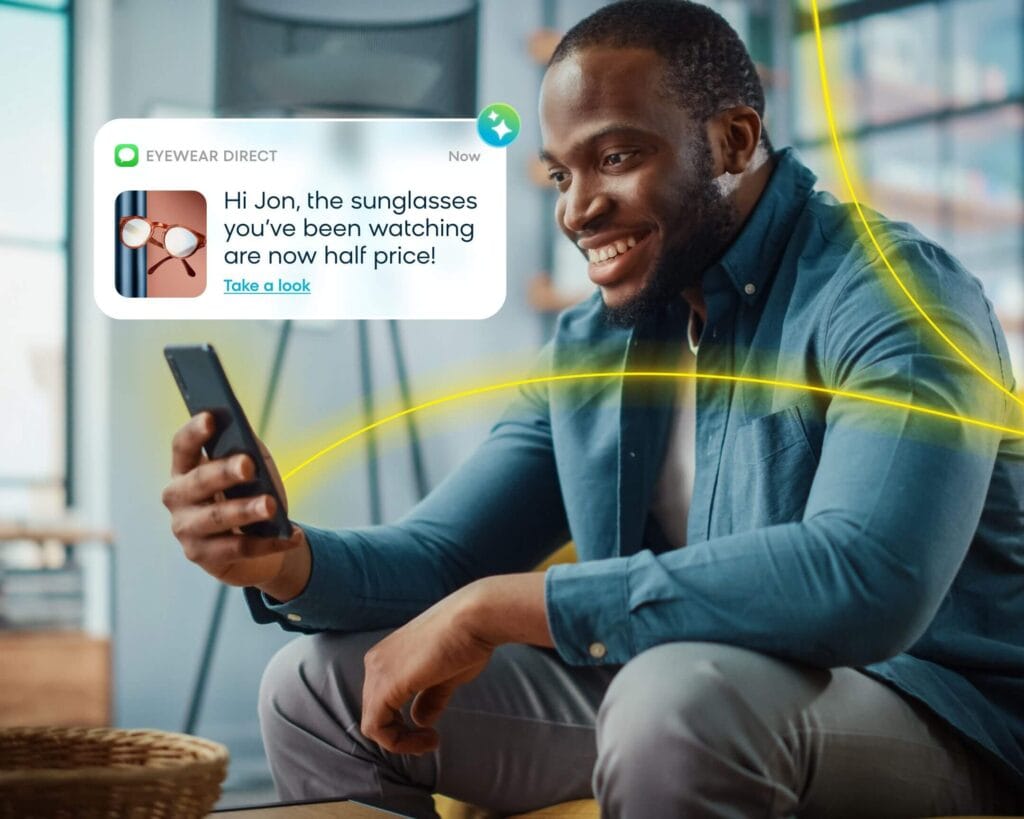
- AI , Team Efficiency
Sneak Peek: How Bloomreach Is Changing Marketing Automation With AI

- Data & Analytics , Personalization
5 Things We Learned from BFCM 2024: The Data, Insights, and Key Takeaways
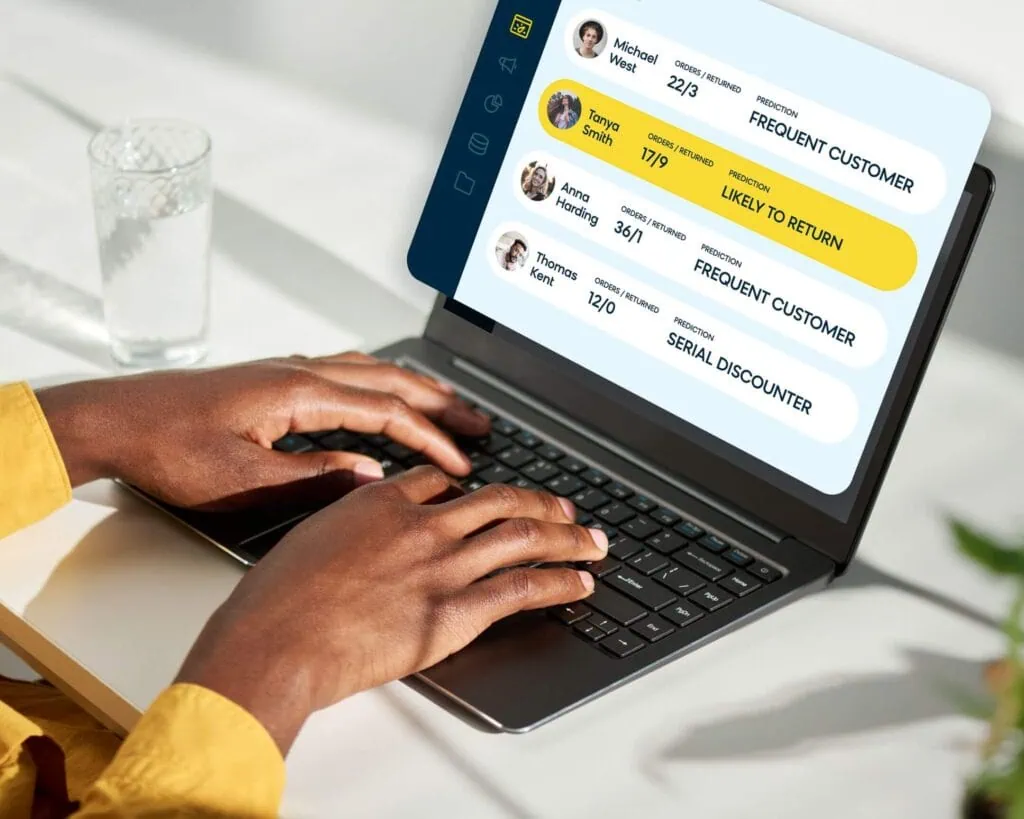
- Customer Data , Profitability , Team Efficiency
A Marketer’s Guide to Data Warehouses: Driving Growth and Efficiency With Company-Wide Data
Join 15,000+ recipients getting the latest insights on ai and ecommerce delivered straight to their inboxes., explore more resources.

Tune in to our Commerce Experience podcast series.

Read up on the latests in AI, commerce and personalization.

Become inspired with our collection of use cases.

Join our virtual events covering popular topics.

Find an in-person event to meet the Bloomreach team.

Read a number of guides covering best practices.

Analyst Reports
See how we stack up according to analysts.

Marketing Automation
Personalize marketing in real-time across email, sms, app, website, and more.
Product Discovery
Ecommerce search and merchandising focused on maximizing revenue.
Unified Data Platform
Customer & product data management, integrations and advanced analytics for omnichannell personalization.
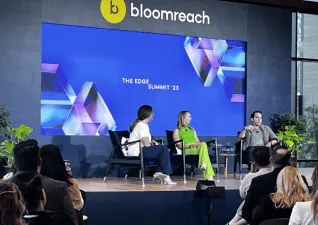
The Edge Summit
London & New York, Sep 2024
Find the perfect package for your business. Unify all your customer and product data and deliver connected customer experiences with our three commerce-specific products.
Book a call with one of our experts

Life With Bloomreach
Watch this video to learn what your life could look like when you use Bloomreach.
21 High Quality eCommerce Case Studies
1. Allbirds
Gallantway does some amazing eCommerce case studies and this is certainly one of the best articles I’ve read on this blog.
This case study goes into a very detailed breakdown of some of the existing strategies that Allbirds uses to acquire new customers including social ads, SEO, email marketing, design, user experience and much more.
Another cool thing I liked about this case study is the listing of Allbirds current tools stack. This certainly helps evaluate which tools eCommerce founders are using and where they fit into the overall growth strategy

2. Coconut Bowls
This e commerce case study by Vyper is an awesome example of the power of nailing social-driven competitions.
Coconut Bowls achieved over 200k pageviews, 37k+ followers and over 40k new emails. The cost? Less than $1000. Amazing result.
The great thing about this case study too is that it shares an incredible amount of detail.. Almost step-by-step which is awesome value for any marketer or founder reading this.

The team at Web Profits are very impressive when it comes to writing amazing growth studies as I’ve shared in within the case studies for SaaS Companies.
For those outside of Australia, you may not know who Koala is but by all means, that’s no reason why you shouldn’t read this case study. It’s amazing!
In just 12 months, Koala grew from $0 to $13 million. They had the perfect mix of everything from the Offer, Website, Landing pages, Facebook Ads and so much more. The offer especially is what really helped catapult Koala into a juggernaut in such a short period of time.
Not only was executing these channels so well, it was their creative strategy and creative marketing/design that really helped them form a captivated and engaged customer audience.

4. Gymshark
The story of GymShark and Founder Ben Francis is phenomenal - incredible growth for a company founded over 7 years ago to become a $1.3 Billion brand .
Whilst the $1.3 Billion brand of today is a great result (and only going to continue to grow), it was their year-on-year revenue growth and traction which really caught my eye in this case study by Beeketing. 193% according to this case study from 2013 - 2016.
This case study goes into deep detail about GymShark’s traffic sources, influencer/ambassador programs (biggest key to their success), social media networks connecting with their fans + more.

I love the MVMT brand so much, in fact I’m wearing one of their watches right now as I write this. Both Jake and Kramer built an incredible brand at 22 years old with $20,000 in debt, only to exit 5 years later for $300 Million. This is a case study worth reading.
This growth study goes into detail about their social media marketing strategy and channels (They nailed their Instagram page I can say that for sure - That’s how I discovered them in the first place), Paid Marketing across Facebook Ads and Google Ads as well as SEO (awesome detail).
The level of detail + screenshots of examples across their channels is highly valuable.

This isn’t a highly detailed case study in terms of length, but incredibly valuable for a branding lessons and how great branding and creative can unlock growth.
I absolutely love the branding of RXBar - such a simple concept, yet so much cut through. So much it was a big part of their strategy that helped them achieve $600 Million in the space of four years. Impressive.
The story of the early stages of RXbar is what I most admire though - pure hustle and doing the things that don’t scale. Great story.
7. Frank Body
A brand that nails UGC Instagram that spurred them into a hypergrowth phase was Frank Body. Their Instagram, content & social is second to none. A leader in the eCommerce space in my opinion.
Frank Body used UGC in their early stages of growth as their core focus, which was very deliberate from day 1 according to a quote by the founder Jess in Forbes.
One thing not taken into account with their Instagram dominance was Instagram’s lighter API + pay to play/reach wasn’t as low for organic posts as what it is now. It’s not a fact that this helped Frank Body by any means, but they were one of the early brands that nailed UGC and Instagram.
Their Email Marketing and Website UX really is one to seek inspiration from for any eCommerce founder or marketer.

8. Princess Polly
Here’s another awesome case study by Gallantway on Princess Polly’s customer acquisition strategy. Definitely read this if you work in fashion eCommerce.
Princess Polly is an Australian-brand which has experienced huge growth which has used influencer marketing, social media organic, Facebook Ads, TikTok Ads, Email Marketing and an amazing UX for its users.
The case study also includes awesome visuals and examples of what Princess Polly does in their key marketing channels. I particularly like the evolution of their website design and UX from 2010 to 2020.

9. Beardbrand
There’s quite a few case studies and posts on BeardBrand’s growth, but this article by Sleeknote tops the rest.
Love the breakdown of 13 of Beardbrand’s key strategies that grew their online store. Lots of easy wins for eCommerce founders and marketers to pick up, run with and test to see if these strategies work for their brand.
A key channel that absolutely did an amazing job with (and still do an amazing job), is their YouTube Channel. They even have over 1.6 Million subscribers now.
Another amazing case study with fantastic imagery to highlight the examples.

10. Warby Parker
Another beautiful eCommerce brand that experienced huge growth in a matter of a few years is Warby Parker.
Whilst Warby Parker has raised a lot of money to grow the brand, learning from their early day marketing strategies is worth noting.
Press in the early days was a core strategy to get the name of the brand into the market, fast. However, it was the social good element that played a key role in getting traction, with press being a way of quick amplification.
PR can be expensive if not done right, especially in the early days of a brand, but Warby Parker nailed this. Worth looking into the PR campaigns they did in their first couple of years of existence.

11. Filtergrade
I thought this was timely to share, especially the rise in people selling digital products through Twitter or through their community/following. This is an interesting business many of you may have not heard before, and it’s not your traditional eCommerce type of company. Filtergrade sells Digital Products, such as photo filters, video filters and more.
Filtergrade in this case study doesn’t have huge numbers in terms of monthly visitors (only 50k per month) 150,000 page views, but they sell digital products that have very high margin.
It’s highlighted that the main channels for their success is through social media, influencers and email marketing.

12. Huckberry
Content, content, content. We know it’s so important for so many brands to stand out and engage consumers, but how many do it right? Huckberry in this case do it well. Their content game is strong across all channels from social to email marketing.
Another amazing article by the Sumo team who go into great detail and a detailed analysis backed up with graphics showing the specific examples Huckberry has used with their key marketing tactics.
Huckberry nailed their ambassador/affiliate program to gain faster WOM and generate more referrals and brand engagement.

13. Brooklinen
The Brooklinen journey from being founded to where they are today is pretty awesome. After smashing their Kickstarter original target of $50k to receive nearly 5x ($237k to be accurate), they’re on track to do over $100 million in 2020. Amazing growth in such a short journey of the company.
This case study illustrates that Brooklinen focused on a lean growth strategy that kept costs low, focusing on whatever it took to achieve more WOM + referrals.
A key strategy they engaged in to spearhead this lean strategy is using micro-influencers to achieve faster WOM and also generate UGC. They would then use this UGC content to then fuel all brand advertising. You can see this worked for them with the % breakdowns by Similarweb, with ~33% direct and ~44% search.
Brooklinen’s Facebook Ads and Email Marketing game are pretty good too!

Mecca is an incredible brand I’ve only come to learn more about (probably only learnt of this recently since I’m not a primary customer haha).
Mecca’s growth is very interesting and have looked into more myself, especially with their Facebook Groups strategy (which isn’t mentioned in this amazing case study - worth looking into separately).
This case study goes into granular detail of Mecca’s website, content, paid search, paid social, email marketing & much more. The visuals and screenshots of Mecca using these strategies in practice makes it another epic case study by the Web Profits team.

I’m not 100% sure the trend of mattress companies growing so fast in revenue (just like Koala), but nonetheless definitely a lot we can learn from these two companies.
Similar to Koala in some respect, Purple nailed Social Media and Video. Quick rapid fire testing between creative and copy is what helped them turn into a $200 million ARR company in just 5 years.
Looking at their Facebook Ads and past video ads, I can see once got budget behind them, they convert and engage audiences quickly.

16. Nasty Gal
Nasty Girl built an amazing growth engine to turn it into a $100million+ business per year.
The brand nailed their value proposition for their target market, whilst leveraging social networks and platforms such as eBay.
In addition, they managed to execute strong WOM fast and a loyal customer following.

Here we go… another Mattress company that does great marketing and overall product and customer experience. Lots we can learn from :)
Sleeknote does amazing growth case studies of some of the biggest eCommerce brands. In this post they go into detail 5 key strategies that Casper used as part of it’s core growth engine; nailing the customer experience, creating content for every stage of the funnel, amazing link building strategy, Google Ads and referrals.
The link building strategy they used to land some big publications that provide a Do-follow and high DA, is really good to read. Definitely sparks some ideas for link building for some of the brands I’m involved in.

18. Supreme
Another amazing case study by Chris Von Wilpert who’s also done other amazing case studies on SaaS companies.
Great detailed analysis of Supreme’s growth which has helped them achieve a huge spike of growth in revenue and social following, whilst building a “cult-like” following with their audience.
This is one of my favourite eCommerce studies just due to the fact of the amazing imagery and screenshots to highlight the exact strategies and tactics used by Supreme. Love it!

19. Dollar Shave Club
This case study on Dollar Shave club is dated back to 2015 but very well worth the read.
This growth study goes into detail the UX of their product onboarding process and email marketing, viral messaging, social media examples + more.
Dollar Shave Club in my opinion was they nailed the customer experience - everything from the boxes customers receive to then their email marketing and videos. Great brand.

20. Harry's
Harry’s a great brand to learn about eCommerce marketing done right and no better company to write this growth case study other than Sleeknote (not affiliated with them at all, they just do really amazing content).
This study goes in-depth on 5 key marketing strategies Harry adopted in their marketing efforts including SEO (backlinks, link-building, etc), word of mouth/referrals, ad strategies + more. Strategy #5 is pretty clever.
Throughout the article it’s evident that Harry nailed their messaging + storytelling across all their channels. Great copy + stories make great brands stand out.

21. Bellroy
Another great case study by Sleeknote with this one on focus on Bellroy, one of Australia’s top success stories.
Really good content that goes in-depth across 7 growth marketing strategies that have contributed to Bellroy’s growth success.
I definitely recommend reading strategy #3 “The marketer magnet method”. Bellroy nails their above the fold + page experience across key product pages.
Yep, I can confirm I want to sign up to this newsletter. I know I can unsubscribe at any time. Privacy Policy . Cookie Policy .
You have successfully joined our subscriber list.
Top 40+ eCommerce Case Studies.
How hismile dominated millennials, the most wanted persona on the planet.
by King Kong
Aggressive testing using social media to find and confirm the right customer persona.
Worked with key influencers from micro to macro to penetrate their ideal customer persona
One of the best eCommerce case studies I've ever read!
$20 Million Skin care business in 2 years with no beauty experience
by Daily Mail
Launched with 100s of nano/micro influencers in one go. Took over instagram with models posting photos
Strong distribution network of influencers with a warm + very engaged audience
Picked up on trends - then amplify via influencers
Just one single instagram giveaway resulted in 41k emails + 37k new followers
by Vyper.ai
With less than $1000 to run this campaign, Coconut Bowls generated LOTS of new emails + followers.
This case study breaks down the exact steps that Coconut Bowls used to explode this giveaway that resulted in $$$
One of the best giveaway case studies I've ever read!
The growth story of Zara | how they turned into the iconic brand of today
by Contact Pigeon
We love this case study due to the story of where Zara originated from into the powerhouse brand of today
Highlights the key drives of growth that helped Zara turn into a Mulit-Million dollar brand
Really impressive stats!
Bootstrapping one of Australia’s most popular shopping brands to $80M ARR
by Business Insider
Growth hacked through community building in early days of facebook, creating modelling competition getting friends to tag each other
A very strong personal brand on instagram and brand partnership deals with macro influencers on instagram
Obsessive focus on customers and customer support.
The journey of 20k to $12M in one year | How Instagram exploded this Business' Growth
by Smart Company
Laser focus on customer persona allowed to double down on Instagram influencers, where they shipped the product to many influencers across the globe
Find and solve a pain point people are facing, the cost should be dwarfed by the value
“Sweet spot” between 200,000 &500,000 for influencers.

AutoCreate personalised outreach messages that get 80% open rates using AI
Build a $200m arr mattress company in 5 years.
Rapid testing between copy and video creatives to ensure their target audience is always entertained and the ads can drive conversation
Video marketing and entertaining story telling helped with product awareness and growth
Bringing tech & science to a very boring/old industry
$0 to $13M in 12 months - Amazing Case Study on Koala
by Web Profits
Koala offered an excellent product that adds significant value, and topped with off with next-to-none customer experience with their 4 hour delivery
Every content piece should have scroll stoppers and be very entertaining - the shock factor video pieces
One of the best case study breakdowns you will read!
$300M+ Valued company in 7 years | Top Case Study
by Beeketing
Amongst the first companies in the world to use influencer marketing truly at scale
Build long lasting relationships by being omnipresent on every social media channel where your customer is
Popup stores across the world a big success.
$0 to $72M in funding | Innovation in Eating or Ingenious Marketing?
by jconnelly.com
A strong story always sells, customers want to understand why this product was built + build a relationship
Packaging is everything, after they repackaged and branded their product the brand took off
Strong PR game, especially in food PR is everything
$163,633.50 Sales In 30 Days | Blendjet using AppSumo for growth
Disclaimer - more around Appsumo product as a case study for them but very interesting study + screenshots.
That revenue figure was from 3406 abandoned carts in 30 days. Incredible recovery!
3 Steps strategy section = powerful.
$0 to $100M within 2 years | amazing Case Study on Allbirds
by Gallantway
A very strong email marketing campaign for cold outreach as well as a brand consistent email strategy for onboarding
Sell the vision and the guarantee, cruelty feel materials, 30 day return and 1 click ease to shop collection
Leveraged their reviews in all their marketing messaging.
5 years to $700 Valuation | The rapid growth of Away
Take something boring, fix the boring problems and create a brand of fun and excitement around it
Their brand is around the obsession of travel not luggage, Aways marketing maven came in their branding, selling people the outcome of travel
Build something unique and identifiable
Viral Video to $1Billion Acquisition | The story of Dollar Shave Club
Customer centric brand that created relatability with their customers using humour
A beautiful and wholesome customer experience with branded boxing, custom unboxing and several personalised up-sell opportunities
Their entire website + UXis a pure sales funnel
The $600M Story in 4 years | A brand case study masterpiece
by Reign 23
Initial growth with door to door sales, theres no bad sales call - spoke to every customer under the sun
Branded partnerships with influencers on instagram to skyrocket their growth
Found many of his original customers at CrossFit gyms
Kickstarter to $300M Exit in 5 years | Growth Story of MVMT
by Alex Fedotoff
Crowd funded a real world problem people face with access to luxury products at reasonable prices
Leveraged small to medium influencers to create a “mvmt” online similar to how Daniel Wellington built their brand up
Used data and leveraged media that works for them - Pics!
Self Funding and disrupting a stagnant market | Story of snow
Influencer marketing with the right influencers matching your target audience
Customer case studies and proof of work will be the biggest upsell
Multiple upselling systems setup during product checkout flows
The story of spanx through using humour | PDF download
by Stanford
This article illustrates how humour played a big role in the launch of Spanx into the brand it is today
By using humour she managed to build a loyal and committed customer base and community
A quality case study which is different to others
How FasionNova has become one of the most searched fashion brands on google
Achieved amazing early traction success back in 2013 when they launched and sold out over a weekend
Relied heavily on working with influencers and growing their Instagram account which boasts over 18+ million
One of the best interviews-based case studies I've read
Rebranding a very personal topic into a Multi-million business
by Fast Company
The medicines aren’t novel but the marketing is made to feel relatable, at home and comforting
Educational content around how men should take care of themselves, showing tutorials and ways for self care
Building subtle humour into sensitive topics = success
$0 to $750M in 4 years | the journey of Casper serving 1 million customers
by Sleeknote
Transformed something as mundane as unboxing their product into a memorable, share-worthy experience
Curiosity reward gap, referral coefficient is high, each customer was a sales person
Such a good case study! One of the best I've read
One tactic YouFoodz used to skyrocket growth by 3000%
by Referral Candy
A big focus on churn and reactivating existing customers a big factor for huge growth
Additional focus on social proof with reviews + social media big levers for growth over time
Whilst more SaaS based, use many ecommerce tactics
$0 to $20 million by selling leftover coffee | amazing story or Frank Body
by Viral Loops
Big focus on growing Instagram organically and started Instagram marketing at the right time
Influencers actively using the product in photos = big social proof and created a referral engine
Beautiful UX of their product pages for CRO
From a $30 investment into $100K per month | growth strategies by Beardbrand
A wonderful case study by Sleeknote which dives in 13 detailed strategies that contributed to Beardbrand's growth
Detailed and curated content specific to each stage of the funnel a big success - promote popular stuff via FB ads
Drip email course to nurture warm audiences
From $0 to $1.2 Billion ecommerce powerhouse in just 5 years
by Growth Marketing Pro
In the early stages of growth they focused on generating "buzz" through PR and word of mouth strategies
Building a social mission as part of their strategy made helped them stand out to consumers
A big focus on PR helped them stand out
$10K to $1Million in just one year | Case Study By Appsumo
Had a unique brand story and products which stood out from competitors
Invested heavily into an ambassador and affiliate program to spur growth
Content + Email game was strong
Thr growth journey of Supreme | Case study by Sumo
Majority of their traffic sources comes from organic and direct
Celebrity influencer marketing a big core to their success (like many other ecommerce successes)
Content + Email massive for their success
How Mellow perfected a pre-launch strategy to achieve over $200k in orders
Reached out to reporters to get PR (doing things that don't scale) and a focus helped them a lot
They studied the most successful websites doing products and focused on what worked for them
They used referral candy as a tool to build referrals
Growing a Multi-million brand by building a content and community machine
Fomo-based marketing and authenticity major factors for growth success
Quality content though socials and leveraging influencers across all platforms
Influencers are more exclusive to the brand
from a vintage shop on ebay to an ecommerce site with $100 million in sales
by Growth Hackers
An amazing story on the journey of NastyGal using an existing platform to build brand to then going on their own
Leveraged social networks and eBay to reach their audience
Fostered word of mouth strategies and customer loyalty
The growth journey of building the world's Top Hot sauce brand
In the early stages focused on pop-up stores to get face to face with customers but had scaling issues
Leveraged the Shopify Fufillment network program in order to scale
Another fantastic interview styled case study
Built their brand over 3 years to 50,000 unique visits per month
by A Better Lemonade Stand
Large focus on social media and chatting to existing customers and photographers to generate WOM
Leveraged Creative Market and their audience to generate sales and reviews of Filtergrade
Focus on building a community, not just an online shop
Reverse Engineering a $400 million startup | harry's growth case study
This case study outlines 5 key growth strategies that you can steal and implement
Replicable Word-of-mouth engine & White Hat links sections are very impressive
Sleeknote case studies are always very good!
From $1000 investment to $10+ million | the growth journey of Man Crates
Focus on storytelling and content big factors for initial growth and referrals
"Tease the unboxing experience to reduce cart abandonment" (strategy #3) - very clever!
Product Reviews helped convert more customers
$0 to $800 million | Growth journey of rent the runway
A large focus on data and obsession on being more efficient with the customer experience
Collecting data also meant they could create really personable experiences to convert more customers
Stayed on trend when it came to trying new experiences
7 strong growth case studies for ecommerce | Bellroy success
Taking notes of the strategy of their Black Friday approach is fantastic - lots to take away!
One of the best when it comes to comverting traffic into sales from Display ads
One of the best study breakdown of strategy
Growth Study of Bonobos | The rise of an ecommerce contender
Pride themselves on their customer service which helped spur their word of mouth
Andy Dunn says making sure Bonobos got one thing right, then the rest can follow
A nice overview of their growth
Overview of a successful content marketing engine in a competitive market
"Customers are also the website builders" - big focus on UGC (User Generated Content) = social proof
Leveraging of social media to skyrocket content amplification - big followings on FB, Pinterest & IG
One of the Pinterest accounts for ecommerce I've seen
From $0 to $100+ million in revenue | Growth Study
Everlane sniffed out potential channels for acquisition - not applicable now but they used Tumblr with great success
They did some clever guerilla marketing tactics - Type in "Everlane and Postmates". Quite clever!
Focused on nailing an effective affiliate marketing strategy
$87k with a single email which then helped spur continuous growth
by Rejoiner
Provide value rather than going for the hard sell on the first touchpoint - focused on 3 points on joining the community
Multiple CTA's to content & quality & engaging explanations of new products helped conversions
Learn from their email marketing approach = very good!
by Marketing Strategy
A quality case study that breaks down strategies across digital and offline - with a deep dive into metrics
Spent a lot of budget on Podcast and YouTube sponsorships and saw great success
Direct Mail also played a big role for acquisition
Review of the Iconic's online marketing strategy
This case study was done back in 2014 but still has some amazing growth marketing strategies & tactics
Goes into great detail about the website, product pages and overall UX with heatmaps, etc = really good detail!
Despite date written, one of the best case studies I've read
The Growth strategy of UK's ecommerce Juggernaut
Great case study which goes into detail the key factors for ASOS' growth success
ASOS automated their international expansion strategy. Amazing section to read and research more into.
Tailored, personalised content key driver for conversions
From $24 in her bank account to 16 millions followers for her businesses | Gretta Van Riel
by Single Grain
Influencer marketing and Instagram a wonderful combination for her success with her brands
Used messenger bots as part of her growth engine to engage customers differently than just purely email
Read more into Gretta - she's very impressive!
Product Features

IMAGES
COMMENTS
May 16, 2024 · We’ve spent hundreds of hours analyzing the world’s most successful DTC companies and ecommerce brands, including Sephora, Dollar Shave Club, Casper, Warby Parker, and Allbirds, to create ecommerce case studies you can use as inspiration for your own online store.
Nov 22, 2024 · As such, these studies often highlight successful ecommerce companies or initiatives, showcasing best practices, innovative approaches, and lessons learned. Having all the basic information covered, let’s jump to the main topic of the article—examples of the best ecommerce case studies. 15 ecommerce case studies: examples and descriptions
Dec 5, 2024 · These eCommerce case studies unveil novel strategies and tactics on how others have tackled challenges in the eCommerce field. You can learn from their experiences to overcome challenges while running an eCommerce business. Follow our next articles to explore additional information related to case study email examples or case study questions ...
Mar 9, 2021 · Case Study Summary: eCommerce store specializing in niche furniture style with an AOV of $1,300 applied a “See, Think, Do” Facebook ad strategy to significantly improve their ROAS. The essence of the strategy is to create specific campaigns with different targeting, creatives, and CTA for each stage of the marketing funnel. Here’s what ...
Feb 1, 2022 · [Ecommerce case study #8] Use influencers to reach customers: Gwynnie Bee saw 5.85% CTR from Youtube influencer By now, you’re probably well aware of how effective influencer marketing can be in spreading brand awareness and social proof, and increasing engagement among your target audience members.
Nov 16, 2023 · The case study dissects how a surge in digital ad-driven sales, showcases the power of data-driven decision-making. Read the full Sephora case study here. Case studies for electronics and tools eCommerce retailers. Retail case study #23: Screwfix
Mar 17, 2023 · This e-commerce case study showed a significant result such as a 450% increase in visitor retention and a 200% boost in conversion rates. Rakuten 24’s website. Rakuten 24 concerns. Rakuten 24 is an online store by Rakuten, the leading e-commerce company from Japan.
Feb 12, 2024 · You too can achieve results as impressive as these ecommerce case studies. With Bloomreach’s solutions, you get an omnichannel marketing platform, ecommerce search and merchandising, and a headless CMS — all powered by Loomi , our commerce-specific AI.
Dec 14, 2020 · This e commerce case study by Vyper is an awesome example of the power of nailing social-driven competitions. Coconut Bowls achieved over 200k pageviews, 37k+ followers and over 40k new emails. The cost?
A curation of the best, top-quality ecommerce case studies you need to read. Lots of lessons and growth hacks to implement for your ecommerce business. We're rated 4.8/5 on Trustpilot.